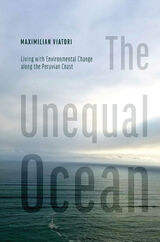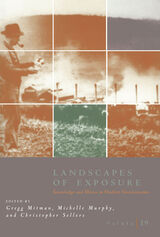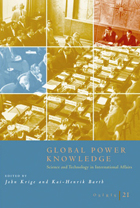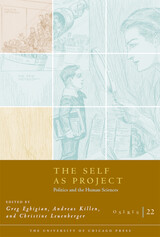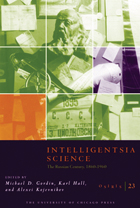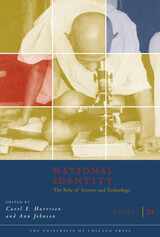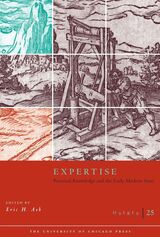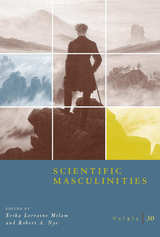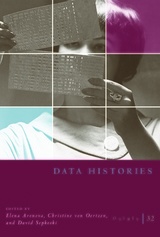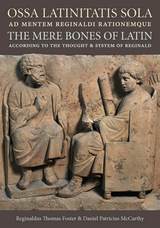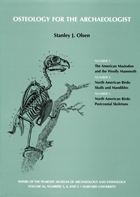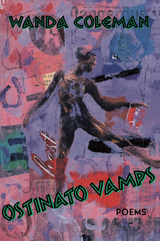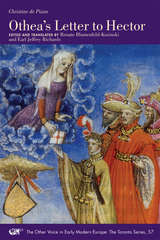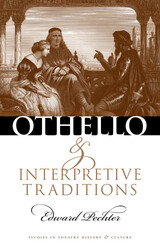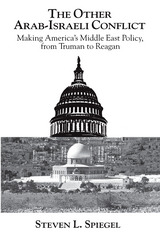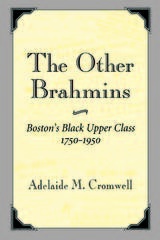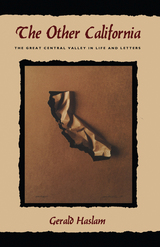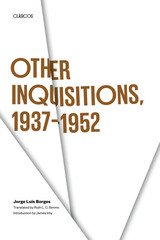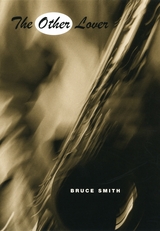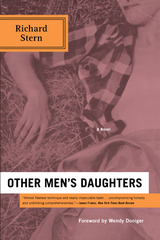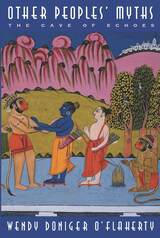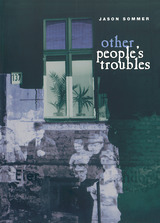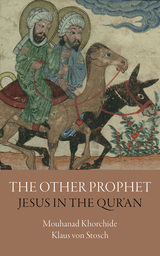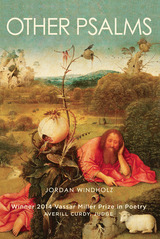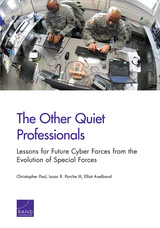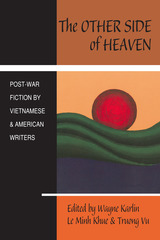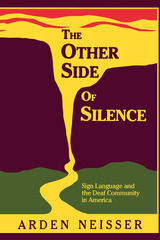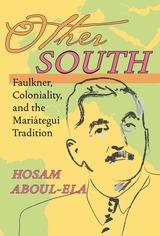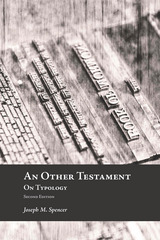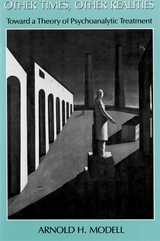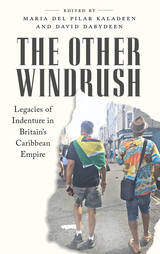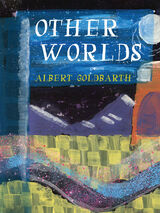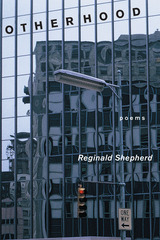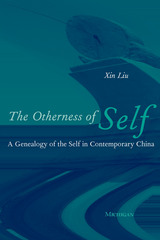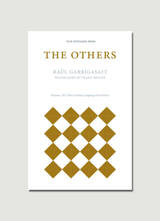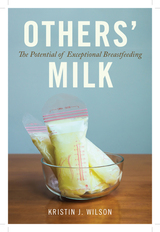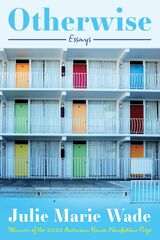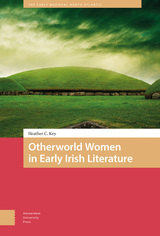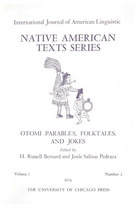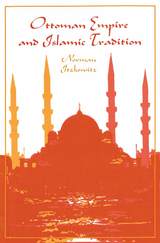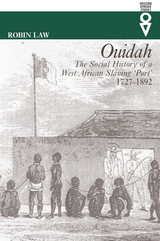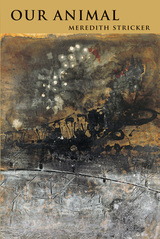 Osiris, Volume 16: Science in Theistic Contexts: Cognitive Dimensions
Edited by John Hedley Brooke, Margaret J. Osler, and Jitse M. van der Meer
University of Chicago Press, 2001 It is a widely shared assumption that science and religion are fundamentally opposed to each other. Yet, recent historiography has shown that religious belief needs to be added to the social, economic, political, and other cultural factors that went into the making of modern science. This new collection shows religious ideas not only motivated scientific effort but also shaped the actual content of major scientific theories. The fourteen studies contained in this volume concentrate on such topics as the theological facets of modern astronomy in the works of Galileo, Kepler, and Newton; the retention of teleology in the natural philosophy of Boyle; and the theistic and teleological associations of the modern theory of evolution authored by Darwin and Wallace. While the majority of the contributions focus on the Christian traditions, the collection also contains case-studies of Judaic and Islamic influences.
Reflecting the fecundity of contemporary scholarship, the current volume should be of extraordinary interest to historians of science, scientists, as well as anyone intrigued by the many ways in which relations between religion and science have been constructed.
Contributors include:
Peter Barker,
John Hedley Brooke,
Geoffrey Cantor,
Margaret G. Cook,
Michael J. Crowe,
Thomas Dixon,
Noah J. Efron,
Richard England,
Martin Fichman,
Maurice A. Finocchiaro,
Menachem Fish,
Bernard R. Goldstein,
Bernard Lightman,
Margaret J. Osler
F. Jamil Ragep,
Phillip R. Sloan,
Stephen Snobelen,
Jitse M. van der Meer,
Stephen J. Wykstra,
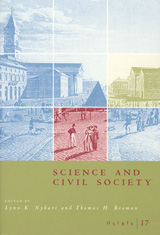 Osiris, Volume 17: Science and Civil Society
Edited by Lynn K. Nyhart and Thomas Broman
University of Chicago Press, 2002 This volume explores the varieties of relationships formed between science and civil society, at both the conceptual and institutional levels, since the late seventeenth century. It brings together general historians and historians of science with different national perspectives to confront the various ways sin which science and civil society have shaped one another in different times and places. How, when, and why did science become intertwined in the network of voluntary associations, professional groups and other institutions we understand as comprising "civil society"? How has science affected the ideology of civil society and thus the legitimacy of political authority in historical contexts as different as late eighteenth-century America, mid nineteenth-century Germany, and early twentieth-century China? How have scientists made use of the ideological links between science and civil political discourse to further their own professional ends? In contrast to much recent writing on civil society, this volume does not aim at making normative pronouncements about the role of civil society in promoting democratic polities, nor does it attempt to weigh the role of science in democracy. Instead, the essays examine how the fruitful interplay of beliefs concerning science and civil society has worked to legitimize the institutional forms of civil society and naturalize its ideologies, while at the same time giving to science its overwhelmingly powerful role in public life.
Osiris, Volume 18: Science and the City
Edited by Sven Dierig, Jens Lachmund, and Andrew Mendelsohn
University of Chicago Press, 2003 Seeking to unite the history of science and urban history, this book emphasizes the active role cities play in shaping both scientific practice and scientific knowledge. Furthermore, the authors argue that cities themselves have to be viewed as mediated by science. Four interconnections of science and the city are discussed: the relationship between scientific expertise and urban politics; science's role in the cultural representation of the city; the embedment of scientific activity in the city's social and material infrastructure; and the interaction between science and everyday urban life.
Osiris, Volume 19: Landscapes of Exposure: Knowledge and Illness in Modern Environments
Edited by Gregg Mitman, Michelle Murphy, and Christopher Sellers
University of Chicago Press, 2004 Bringing together historians of science and medicine with environmental historians, and adding more contemporary vantage points from geography, anthropology, and sociology, Osiris Volume 19: Landscapes of Exposure offers an unprecedented interdisciplinary depiction of how, over the nineteenth and twentieth centuries, scientists and lay people have generated methods for connecting health and place, disease and ecology, calculation and risk.
Osiris, Volume 21: Global Power Knowledge: Science and Technology in International Affairs
Edited by John Krige and Kai-Henrik Barth
University of Chicago Press, 2006 Osiris annualy examines a particular topic in the history of science, bringing together experts in the field to consider multiple aspects of the time period, episode, or theme. Volume 21, Historical Perspectives on Science, Technology, and International Affairs, explores the ways in which scientists and issues in science and technology have played significant roles in foreign policy and international relations, especially since the Second World War.
Osiris, Volume 22: The Self as Project: Politics and the Human Sciences
Edited by Greg Eghigian, Andreas Killen, and Christine Leuenberger
University of Chicago Press, 2007 Osiris annually examines a particular topic in the history of science, bringing together experts in the field to consider multiple aspects of the time period, episode, or theme. Volume 22 explores the ways that twentieth-century political institutions and the human sciences in the western world attempted to understand and shape the attitudes and behaviors of individuals.
Osiris, Volume 23: Intelligentsia Science: The Russian Century, 1860-1960
Edited by Michael Gordin, Karl Hall, and Alexei Kojevnikov
University of Chicago Press, 2008 The newest annual volume of Osiris, Intelligentsia Science explores the transformations in science in the history of Russia and the Soviet Union, from serfdom to Sputnik, as a series of developments in Russian culture.
The contributors argue that it was the generation of the 1860s that transformed “intelligentsia” into a central notion of Russian popular discourse, cementing its association with revolutionary politics—and with science. Science became the cornerstone of the intelligentsia’s ideological and political projects, either as an alternative to socialism, or more often as its nominal raison d’être. The Russian century may in fact be over, but the interrelation of the intelligentsia and science to form “intelligentsia science” proves enduring.
Osiris, Volume 24: National Identity: The Role of Science and Technology
Edited by Carol E. Harrison and Ann Johnson
University of Chicago Press, 2009 This latest volume of Osiris, National Identity: The Role of Science and Technology, explores the ways in which modern science and the nation-state have mutually interacted since the Enlightenment. The contributors argue for the formative role of science and technology in the creation of national identity, and with examples drawn from eastern and western nation-states, they argue that possession of scientific and technological resources became a marker of national character; the first states to develop this power nexus of science, technology, and bureaucracy went on to become globally dominant and widely imitated. This volume traces the significance of this relationship from its beginnings in the West to its dissemination into the postcolonial world.
Osiris, Volume 25: Expertise: Practical Knowledge and the Early Modern State
Edited by Eric H. Ash
University of Chicago Press, 2010 This newest annual edition of Osiris brings together a variety of scholars to consider a topic of increasing interest in the history of science: expertise. Focusing specifically on the role expertise has played in the support, legitimation, and growth of the state since early modern times, Expertise and the Early Modern State reveals how scientific expertise and practical knowledge were crucial to the construction of early modern empires and economies. The state, on the other hand, performed a similar function for scientists, giving them much of the status and resources they needed to further their work. A penetrating, multifaceted investigation, Osiris 25 will be required reading for historians of science and early modern political development.
 Osiris, Volume 26: Klima
Edited by James Rodger Fleming and Vladimir Jankovic
University of Chicago Press, 2011 “Climate is a rather elusive entity,” wrote Helmut Landsberg in 1950 as he sorted out some twenty or so competing definitions. This volume of Osiris explores the complexities in understanding what climate means from a historical perspective. The title of this volume, Klima, evokes its Greek origins, κλίμα, meaning an extended period encompassing vast layers of different kinds of meteorological information. The volume thus seeks not only to decouple Klima from its current exclusive association with atmospheric sciences, but also to re-visit the implications of an ancient vocabulary for medical, geographical, agricultural, economic, racial, and other “endemic” concerns. If climate is not just about the weather, what is it? The essays in this volume treat climate discourse as a framing device that makes explicit all social concerns arising from the anxiety over the sensible and latent experiences of living in an atmosphere of hunger and satiation, disease and health, poverty and wealth, isolation and community, angst and hope. James Fleming is a historian of science and technology and Professor of Science, Technology and Society at Colby College, Maine. Vladimir Jankovic is a faculty member, at the Centre for the History of Science, Technology and Medicine, University of Manchester. He is a historian of atmospheric sciences, and has published in the history of meteorology, geography of environmental knowledge, and medical climatology.
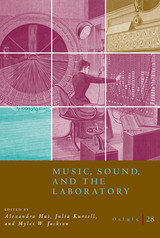 Osiris, Volume 28: Music, Sound, and the Laboratory from 1750-1980
Edited by Alexandra Hui, Julia Kursell, and Myles W. Jackson
University of Chicago Press Journals, 2013 The understanding of sound underwent profound changes with the advent of laboratory science in the nineteenth and twentieth centuries. New techniques of sound visualization and detection, the use of electricity to generate sound, and the emergence of computers radically reshaped the science of acoustics and the practice of music. The essays in this volume of Osiris explore the manifold transformations of sound ranging from soundproof rooms to psychoacoustics of seismology to galvanic music to pedaling technique. They also discuss more general themes such as the nature of scientific evidence and the development of instruments and instrumentation. In examining the reciprocity between music and science, this volume reaches a new register in the evolution of scientific methodology during the nineteenth and twentieth centuries.
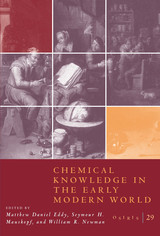 Osiris, Volume 29: Chemical Knowledge in the Early Modern World
Edited by Matthew D. Eddy, Seymour H. Mauskopf, and William R. Newman
University of Chicago Press Journals, 2014 The last twenty-five years have witnessed some provocative transmutations in our understanding of early modern chemistry. The alchemist, once marginalized as a quack, now joins the apothecary, miner, humanist, and natural historian as a practitioner of “chymistry.” In a similar vein, the Chemical Revolution of the eighteenth century, with its focus on phlogiston and airs, has been expanded to include artisanal, medical, and industrial practices. This collection of essays builds on these reappraisals and excavates the affinities between alchemy, chymistry, and chemistry from the sixteenth to the eighteenth centuries. It reveals a rich world of theory and practice in which instruments, institutions, inscriptions and ideas were used to make material knowledge. More generally, the volume will catalyze wide-ranging discussions of material and visual cultures, the role of expertise, and the religious and practical contexts of scientific inquiry.
Osiris, Volume 30: Scientific Masculinities
Edited by Erika Lorraine Milam and Robert A. Nye
University of Chicago Press Journals, 2015 This volume of Osiris integrates gender analysis with the global history of science and medicine from the late Middle Ages to the present by focusing on masculinity. The premise is that social constructions of masculinity function simultaneously as foils for femininity and as methods of differentiating between “kinds” of men. In exploring scientific masculinities, the book asks: how has masculinity been defined, and what are the mechanisms by which it operates in science? The essays are divided into sections that emphasize the importance of gender to the practices of professionalization, the spaces in which scientific, technological, and medical labor is performed, and the ways that sex, gender, and sexual orientation are measured and serve as metaphors in society and culture.
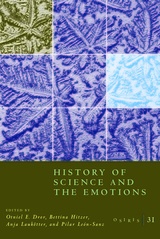 Osiris, Volume 31: History of Science and the Emotions
Edited by Otniel E. Dror, Bettina Hitzer, Anja Laukötter, and Pilar León-Sanz
University of Chicago Press Journals, 2016 What new insights become available for historians when emotions are included as an analytical category? This volume of Osiris explores the historical interrelationships between science and its cultures and cultures of emotions. It argues that a dialogue between the history of emotions and the history of science leads to a rethinking of our categories of analysis, our subjects, and our periodizations. The ten case studies in the volume explore these possibilities and interrelationships across North America and Europe, between the twelfth and the twentieth centuries, in a variety of scientific disciplines. They analyze how scientific communities approached and explained the functions of emotions; how the concomitant positioning of emotions in or between body-mind-intersubjectivity took place; how emotions infused practices and how practices generated emotions; and, ultimately, how new and emerging identities of and criteria for emotions created new knowledge, new technologies, and new subjectivities.
Osiris, Volume 32: Data Histories
Edited by Elena Aronova, Christine von Oertzen, and David Sepkoski
University of Chicago Press Journals, 2017 The history of data brings together topics and themes from a variety of perspectives in history of science: histories of the material culture of information and of computing, the history of politics on individual and global scales, gender and women’s history, as well as the histories of many individual disciplines, to name just a few of the areas covered by essays in this volume. But the history of data is more than just the sum of its parts. It provides an emerging new rubric for considering the impact of changes in cultures of information in the sciences in the longue durée, and an opportunity for historians to rethink important questions that cross many of our traditional disciplinary categories.
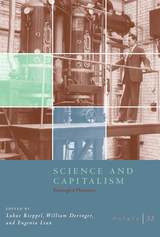 Osiris, Volume 33: Science and Capitalism: Entangled Histories
Edited by Lukas Rieppel, William Deringer, and Eugenia Lean
University of Chicago Press Journals, 2018 The historical relationship between science and capitalism has long stood as a central question in science studies, at least since its foundations in the 1930s. Taking inspiration from the recent surge of scholarly interest in the “history of capitalism,” as well as from renewed attention to political economy by historians of science and technology, this Osiris volume revisits this classic quandary, foregrounding the entanglements between these two powerful and unruly historical forces and tracing the diverse ways they mutually shaped each other. Key attention is paid to the practices of knowledge work that enable both scientific and capitalistic action and to the diversity of global sites and circuits in which science/capitalism have been performed. The assembled papers excavate an array of tangled nodes at the science/capitalism nexus, spanning from the seventeenth century to the twenty-first, from Nevada to Central Asia to Japan, from microbiology to industrial psychology to public health.
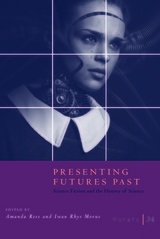 Osiris, Volume 34: Presenting Futures Past: Science Fiction and the History of Science
Edited by Amanda Rees and Iwan Rhys Morus
University of Chicago Press Journals, 2019 The role of fiction in both understanding and interpreting the world has recently become an increasingly important topic for many of the human sciences. This volume of Osiris focuses on the relationship between a particular genre of storytelling—science fiction (SF), told through a variety of media—and the history of science.
The protagonists of these two enterprises have a lot in common. Both SF and the history of science are oriented towards the (re)construction of unfamiliar worlds; both are fascinated by the ways in which natural and social systems interact; both are critically aware of the different ways in which the social (class, gender, race, sex, species) has inflected the experience of the scientific. Taking a global approach, Presenting Futures Past examines the ways in which SF can be used to investigate the cultural status and authority afforded to science at different times and in different places. The essays consider the role played by SF in the history of specific scientific disciplines, topics, or cultures, as well as the ways in which it has helped to move scientific concepts, methodologies, and practices between wider cultural areas. Ultimately, Presenting Futures Past explores what SF can tell us about the histories of the future, how different communities have envisaged their futures, and how SF conveys the socioscientific claims of past presents.
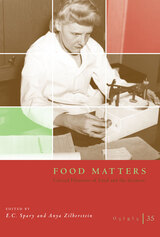 Osiris, Volume 35: Food Matters: Critical Histories of Food and the Sciences
Edited by E. C. Spary and Anya Zilberstein
University of Chicago Press Journals, 2020 Since the early modern period, science has played an ever-growing role in healthcare, agriculture, the regulation of food and drink trades, and the standardization of nutrition guidelines. Yet until now, few studies had explored the historical processes through which scientific claims of knowledge gained the power to shape food supply chains and consumer choices. This volume of Osiris reveals how sciences of food have been informed by, and helped to shape in turn, an array of institutions, labor regimes, cultural practices, and ethical commitments.
The essays delve into a range of topics, from early modern dietetics and debates about cannibalism to modern ready-to-eat rations and Ayurvedic recipes, from analyses of hungry model organisms to the dining rituals of Silicon Valley entrepreneurs and their patrons. As Food Matters shows, the history of knowledge about food has always raised debates about the shifting definition and boundaries of expertise: between traditional recipes and experimental protocols; between domestic craft skill and laboratory procedure; between the management and redistribution of resources for the social body on the one hand, and the subjective experiences of individual bodies on the other. At a moment when the authority of science is being questioned by a variety of publics, Food Matters is a timely reminder that such tensions, always present in food-related domains, reflect broader historical developments through which science became a prevalent force in shaping all aspects of public and private life.
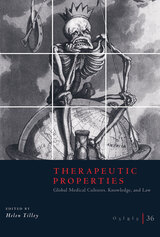 Osiris, Volume 36: Therapeutic Properties: Global Medical Cultures, Knowledge, and Law
Edited by Helen Tilley
University of Chicago Press Journals, 2021 This volume of Osiris takes as its point of departure a simple premise: we have yet to fully flesh out the complex historical interplay between medicine and law across the globe. Therapeutic Properties takes an inventive look at the issue, presenting welcome insights on the worldwide ascendancy of biomedicine, the persistence of nonofficial and unorthodox approaches to healing, and the legal contexts that have served to shape these dynamics.
The contributions draw upon source material from the Americas, Africa, Western Europe, the Caribbean, and Asia to trace the influence of penal and civil codes, courts and constitutions, and patents and intellectual properties on not only health practices but also the very foundations of state-sanctioned medicine. The authors explore, too, how institutions of global governance, including those underpinning empires and trade, have historically created feedback loops that enabled laws and regulatory regimes to spread, amplifying their effects and standardizing approaches to diseases, drugs, professions, personhood, and well-being along the way. Highlighting the payoff of interdisciplinary and transnational analyses, this volume adroitly teases apart how different actors fought to write the rules of global health, rendering certain approaches to life and death irrelevant and invisible, others pathological and punishable by law, and others still, normal and natural.
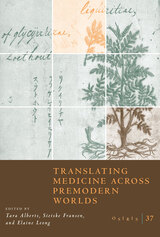 Osiris, Volume 37: Translating Medicine across Premodern Worlds
Edited by Tara Alberts, Sietske Fransen, and Elaine Leong
University of Chicago Press Journals, 2022 Highlights the importance of translation for the global exchange of medical theories, practices, and materials in the premodern period.
This volume of Osiris turns the analytical lens of translation onto medical knowledge and practices across the premodern world. Understandings of the human body, and of diseases and their cures, were influenced by a range of religious, cultural, environmental, and intellectual factors. As a result, complex systems of translation emerged as people crossed linguistic and territorial boundaries to share not only theories and concepts, but also materials, such as drugs, amulets, and surgical tools. The studies here reveal how instances of translation helped to shape and, in some cases, reimagine these ideas and objects to fit within local frameworks of medical belief.
Translating Medicine across Premodern Worlds features case studies located in geographically and temporally diverse contexts, including ninth-century Baghdad, sixteenth-century Seville, seventeenth-century Cartagena, and nineteenth-century Bengal. Throughout, the contributors explore common themes and divergent experiences associated with a variety of historical endeavors to “translate” knowledge about health and the body across languages, practices, and media. By deconstructing traditional narratives and de-emphasizing well-worn dichotomies, this volume ultimately offers a fresh and innovative approach to histories of knowledge.
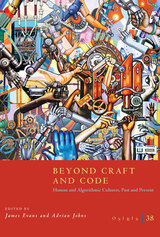 Osiris, Volume 38: Beyond Craft and Code: Human and Algorithmic Cultures, Past and Present
Edited by James Evans and Adrian Johns
University of Chicago Press Journals, 2023 Perceptively explores the shifting intersections between algorithmic systems and human practices in the modern era. How have algorithmic systems and human practices developed in tandem since 1800? This volume of Osiris deftly addresses the question, dispelling along the way the traditional notion of algorithmic “code” and human “craft” as natural opposites. Instead, algorithms and humans have always acted in concert, depending on each other to advance new knowledge and produce social consequences. By shining light on alternative computational imaginaries, Beyond Craft and Code opens fresh space in which to understand algorithmic diversity, its governance, and even its conservation. The volume contains essays by experts in fields extending from early modern arithmetic to contemporary robotics. Traversing a range of cases and arguments that connect politics, historical epistemology, aesthetics, and artificial intelligence, the contributors collectively propose a novel vocabulary of concepts with which to think about how the history of science can contribute to understanding today’s world. Ultimately, Beyond Craft and Code reconfigures the historiography of science and technology to suggest a new way to approach the questions posed by an algorithmic culture—not only improving our understanding of algorithmic pasts and futures but also unlocking our ability to better govern our present.
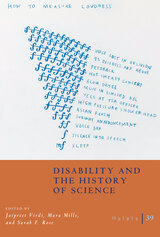 Osiris, Volume 39: Disability and the History of Science
Edited by Jaipreet Virdi, Mara Mills, and Sarah F. Rose
University of Chicago Press Journals, 2024 Presents a powerful new vision of the history of science through the lens of disability studies.
Disability has been a central—if unacknowledged—force in the history of science, as in the scientific disciplines. Across historical epistemology and laboratory research, disability has been “good to think with”: an object of investigation made to yield generalizable truths. Yet disability is rarely imagined to be the source of expertise, especially the kind of expertise that produces (rational, neutral, universal) scientific knowledge.
This volume of Osiris places disability history and the history of science in conversation to foreground disability epistemologies, disabled scientists, and disability sciencing (engagement with scientific tools and processes). Looking beyond paradigms of medicalization and industrialization, the volume authors also examine knowledge production about disability from the ancient world to the present in fields ranging from mathematics to the social sciences, resulting in groundbreaking histories of taken-for-granted terms such as impairment, infirmity, epidemics, and shōgai.
Some contributors trace the disabling impacts of scientific theories and practices in the contexts of war, factory labor, insurance, and colonialism; others excavate racial and settler ableism in the history of scientific facts, protocols, and collections; still others query the boundaries between scientific, lay, and disability expertise. Contending that disability alters method, authors bring new sources and interpretation techniques to the history of science, overturn familiar narratives, apply disability analyses to established terms and archives, and discuss accessibility issues for disabled historians. The resulting volume announces a disability history of science.
 Osiris, Volume 40: Animal Mobilities
Edited by Tamar Novick, Lisa Onaga, and Gabriel N. Rosenberg
University of Chicago Press Journals, 2025 Situates "animal mobility" within the politics of movement, opening new perspectives in the history of science.
Human societies often come to know the natural world by examining animals, even as animals, frequently both willful and animate, can elude human grasp and challenge human aims. Animals and their movements have underpinned many methodological, moral, and epistemic dilemmas that generatively trouble the field. Featuring a range of geographies, species, languages, and cultures, the contributions in this volume broaden the view of the historical roles animals play in knowledge production processes. Organized according to three scales of animal movement (individuals, groups, systems), the twelve richly illustrated inquiries are situated in different time periods, from the sixteenth-century Ottoman Empire to the recent globalized past, and introduce varied forms, capacities, and politics of movement associated with animals. The analytic attention to animal mobility deepens comprehension of animal agency and human–animal interactions in unexpected spaces, including airports, entertainment venues, living rooms, dirt roads, and waterways. Taken together, the case studies in this volume reconsider how, where, and by whom science is done.
 Osiris, Volume 9: Instruments
Edited by Albert Van Helden and Thomas L. Hankins
University of Chicago Press, 1994 They measure, they demonstrate, they reveal unseen worlds. Through the ages, scientific instruments have been used not only to advance understanding, but also to advance careers, dazzle audiences, and impose standards. These eleven essays take stock of the philosophy of instrumentation and the impact of new instruments in both the physical and life sciences, carefully considering the important interplay between instruments and authority, audience, and culture.
Contributors include Albert Van Helden on telescopes and authority, Jan Golinski on the demonstrative order of proof in Lavoisier's chemistry, Bruce J. Hunt on the development of electrical standards, Deborah Warner on terrestrial magnetism, Bruce Hevly on Stanford's supervoltage X-ray tube, Robert W. Smith and Jose h N. Tatarewicz on devices and black boxes, Thatcher Deane on the imperial astronomical bureau in the Ming dynasty, Thomas L. Hankins on Louis-Bertrand Castel's ocular harpsichord, Simon Schaffer on demonstration devices in Georgian mechanics, Timothy Lenoir on Helmholtz and the materialities of communication, and Robert Frank on instruments, biological techniques, and the "all-or-none" principle.
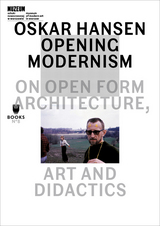 Oskar Hansen - Opening Modernism: On Open Form Architecture, Art and Didactics
M. Christine Boyer, Tomasz Fudala, Jola Gola, Aleksandra Kedziorek, Lukasz Ronduda, Felicity Scott, Karol Sienkiewicz, Mark Wasiuta, et al.
Museum of Modern Art in Warsaw, 2014 Following an international conference organized at the Museum of Modern Art in Warsaw in 2013, Oskar Hansen—Opening Modernism analyzes diverse aspects of the architectural, theoretical, and didactical oeuvre of Oskar Hansen, who was the Polish member of Team 10, a group of architects that challenged standard views of urbanism more than fifty years ago. In chronicling the impact of Hansen’s theory of “Open Form” on architecture, urban planning, experimental film, and visual arts in postwar Poland, this volume traces the flow of architectural ideas in a Europe divided by the Cold War. Through discussions of the ideas of openness and participation in state-socialist economies, Oskar Hansen—Opening Modernism offers new insights into exhibition design and the interrelations of architecture, visual arts, and the state.
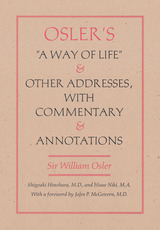 Osler's A Way of Life and Other Addresses, with Commentary and Annotations
Sir William Osler
Duke University Press, 2001 Sir William Osler (1849–1919) had a long and distinguished career as a physician and professor at McGill University, the University of Pennsylvania, the Johns Hopkins University, and finally, as the Regius Chair in Medicine at Oxford University. Over the course of his professional life, Osler gave many addresses—mostly to medical students—on medical ethics, medicine and the humanities, the relationship between the medical practitioner and the patient, and, as the titular essay makes clear, on the “way of life” he advocated for the ethical physician. He remains an inspiration to many contemporary medical practitioners; there are active Osler Societies throughout the world.
While Osler’s talks were frequently published during his lifetime and they have been published individually and in different compilations since his death, none contain the over 1500 annotations that appear here, notes that serve to explain the many philosophical, biblical, historical, and literary allusions contained in Osler’s writings.
This thoroughly explicated selection of Sir William Osler’s writings will be cherished by physicians, medical students, nurses, philosophers, theologians, and ethicists in this—and future—generations.
Ossa Latinitatis Sola Ad Mentem Reginaldi Rationemque
Reginaldus Thomas Foster
Catholic University of America Press, 2016 From the first encounter with the Latin language to its full presentation, the objective of Ossa Latinitatis Sola is to get people into immediate contact with and understanding of Latin authors, and for these encounters to grow into a love and use of the entire language in all its literary types and periods of time and authors of the past 2,300 years.
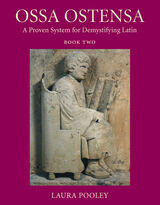 Ossa Ostensa: A Proven System for Demystifying Latin, Book 2
Laura Pooley
Catholic University of America Press, 2023 Ossa Ostensa is the world’s first comprehensive example of how to teach and learn the Latin language using the unique teaching system of the internationally recognized authority Reginald Foster. Laura Pooley – prize-winning graduate of the University of Oxford and currently a supervisor at the University of Cambridge, brings to life the year she spent in Rome studying Latin with Reginaldus. His inspiring and transformative method of teaching combines with Laura’s twenty years of teaching experience to produce concise and crystal-clear explanations of the language. The three ‘experiences’ of Latin: beginners, intermediates and advanced, are divided between three user-friendly workbooks. Each workbook comprises around thirty lessons, where the language is presented in hand-out form requiring very little modification by prospective teachers. Each language area is then illustrated by translated reading examples. After each lesson, Laura provides translation practice targeted to the taught content. These Latin passages are divided into Classical and Post-Classical literature, to appeal to the interests of all Latin students. Not only that, but each passage is accompanied by teaching questions and translation hints, the mainstay of Reginaldus’ classroom persona and pedagogy so famously encapsulated in his Ludi. Students therefore can exercise recent language content and develop deep and spontaneous fluency in the Latin language. Enjoy continuing your experience of learning with Reginaldus with book 2 of the Ossa Ostensa series, where the significant language areas of participles and subjunctives are met for the first time.
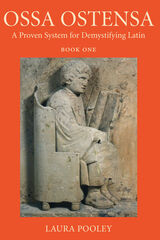 Ossa Ostensa: A proven system for demystifying Latin, Book One
Laura Pooley
Catholic University of America Press, 2021 Ossa Ostensa is the world’s first comprehensive example of how to teach and learn the Latin language using the unique teaching system of the internationally recognized authority Reginald Foster. Laura Pooley – prize-winning graduate of the University of Oxford and currently a supervisor at the University of Cambridge, brings to life the year she spent in Rome studying Latin with Reginaldus. His inspiring and transformative method of teaching combines with Laura’s twenty years of teaching experience to produce concise and crystal-clear explanations of the language. The three ‘experiences’ of Latin: beginners, intermediates and advanced, are divided between three user-friendly workbooks. Each workbook comprises around thirty lessons, where the language is presented in hand-out form requiring very little modification by prospective teachers. Each language area is then illustrated by translated reading examples. After each lesson, Laura provides translation practice targeted to the taught content. These Latin passages are divided into Classical and Post-Classical literature, to appeal to the interests of all Latin students. Not only that, but each passage is accompanied by teaching questions and translation hints, the mainstay of Reginaldus’ classroom persona and pedagogy so famously encapsulated in his Ludi. Students therefore can exercise recent language content and develop deep and spontaneous fluency in the Latin language. For the first time, the experience of learning with Reginaldus is available to everyone.
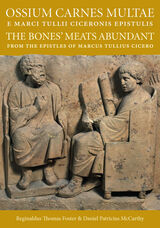 Ossium Carnes Multae e Marci Tullii Ciceronis Epistulis / The Bones’ Meats Abundant from the Epistles of Marcus Tullius Cicero
Reginaldus Thomas Foster
Catholic University of America Press, 2021 Beginners and experts alike will find a complete immersion into the workings and nature of the Latin language embodied in the incomparable, insuperable epistles of the great Marcus Tullius Cicero, something which other commentators pass over or scorn. This second volume puts “meat on the bones” of the Latin language presented in the first volume: Ossa Latinitatis Sola: The Mere Bones of Latin. The personal letters of Cicero provide ample meat to enflesh the skeletal structure of the language, thus the title: Ossium Carnes Multae: The Bones’ Meats Abundant from the epistles of Marcus Tullius Cicero.
Part 1 presents 51 complete letters from the Tyrell-Purser text. Facing each letter is an image of its oldest manuscript edition as early as the ninth century, which are preserved and guarded in the Medicea Laurentiana library in Florence, Italy, witnessing to the human hand preserving this monument of world heritage for over two millennia.
Part 2 follows with a most careful rendition into English of Tully’s living, telephone-like Latin discourse. A thorough treatment and explanation of noteworthy elements of his natural talk follows with numerous references to the Encounters in Volume I. All this has students, learners, teachers, experts of the Latin language in mind and is humbly designed to deepen the understanding and appreciation of specific expressions and peculiarities of Cicero’s language itself.
Part 3 provides 500 sentences consisting of from 1 to 5 words and suited for the beginnings or continuation of Latin conversations: 200 declarations, 100 questions, 100 exclamations, 100 injunctions drawn from his letters. The volume is amply indexed.
All this has been done to enhance the study and use of Latin, to popularize Cicero’s correspondence, to prepare the reader for Volume III which will deal again with the letters and their usefulness for Latin conversation.
An Osteology of Some Maya Mammals
Stanley J. Olsen
Harvard University Press, 1982 The bone remains of a considerable range of vertebrate mammals have been recovered in the course of excavations at Maya archaeological sites. Many of the mammals represented in those collections are peculiar to Central America and have not been treated in osteological studies. This volume has been designed to aid in the identification of faunal remains recovered in the Maya area and is intended particularly for those archaeologists not having the large comparative mammal collections in their institutions. A number of the skeletons are figured for the first time.
Ostinato Vamps: Poems
Wanda Coleman
University of Pittsburgh Press, 2003 Ostinato Vamps is Wanda Coleman's first book of poetry since the demise of her longtime publisher, Black Sparrow Press. It continues and enlarges the traits that have been her hallmark for more than three decades: a fierce adherence to the truth and a language so musical one can almost hear the blues line underneath her stanzas.
Linguistically daring, lyrically breathtaking, stylistically bold, these poems both explore familiar territory and shatter stereotypes. Life is difficult, often unfair, but it belongs to the living, as Coleman reminds us in no uncertain terms. Racing between an earthy eroticism and fatalistic despair, filled with humor and tragedy, these poems are alive. They breathe. They challenge us even as they reward us for seeking the truth.
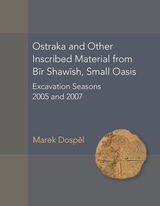 Ostraka and Other Inscribed Material from Bir Shawish, Small Oasis: Excavation Seasons 2005 and 2007
Marek Dospel
University of Michigan Press, 2020 Informal documents and remains of material culture, when analyzed properly, offer a unique window into the daily lives and workings of ancient civilizations. Published here in their archaeological context and with any relevant artifacts, the documents and inscriptions excavated recently in Egypt’s Western Desert represent a valuable addition to our meager documentation of the Bahriya Oasis in the first centuries CE. This is the first comprehensive treatment of an archaeological dataset from the archaeological exploration of Bīr Shawīsh. Dating to around 400 CE, these primary historical sources include documentary texts written on ostraka, informal inscriptions on various ceramic objects, plus a group of incised lids. The core of the volume consists of an annotated edition and analytical indices. This is prefaced by the historical and archaeological context and is followed by a synthesis of selected issues inherent to the published material. The book includes appendices and pictures of all published objects. Doubling the number of texts and inscriptions published to date from the Small Oasis, this new corpus furthers our understanding of the economic, administrative, and social history of Late Antique Egypt.
 Ostrannenie: On "Strangeness" and the Moving Image. The History, Reception, and Relevance of a Concept
Annie van den Oever
Amsterdam University Press, 2010 Ostrannenie (‘making it strange’) has become one of the central concepts of modern artistic practice, ranging over movements including Dada, postmodernism, epic theatre, and science fiction, as well as our response to arts. Coined by the ‘Russian Formalist’ Viktor Shklovsky in 1917, ostrannenie has come to resonate deeply in Film Studies, where it entered into dialogue with the Brechtian concept of Verfremdung, the Freudian concept of the uncanny and Derrida's concept of différance.
Striking, provocative and incisive, the essays of the distinguished film scholars in this volume recall the range and depth of a concept that since 1917 changed the trajectory of theoretical inquiry.
European Film Studies – ‘The Key Debates is a new film series from Amsterdam University Press edited by Annie van den Oever (the founding editor), Ian Christie and Dominique Chateau. The editors’ ambition is to uncover and track the process of appropriation of critical terms in film theory in order to give the European film heritage the attention it deserves.
With contributions from Ian Christie, Yuri Tsivian, Dominique Chateau, Frank Kessler, Laurent Jullier, Miklós Kiss, Annie van den Oever, Emile Poppe, László Tarnay, Barend van Heusden, András Bálint Kovács, and Laura Mulvey, this important study is a wonderful piece of imaginative yet rigorous scholarship.
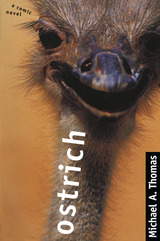 Ostrich: (A Comic Novel)
Michael A. Thomas
University of Nevada Press, 2000 Nevada sheep rancher Sabine Eckleberry’s life is in shambles. His wife has decamped to Arizona to run a dog-grooming business; his youngest daughter needs a husband; his irrepressible son VJ wants to turn the ranch into an ostrich-breeding operation; and the wild burros he has adopted to guard his sheep can’t get along with their charges. Now his family and friends are about to descend on the ranch to celebrate Sabine’s seventy-second birthday. The ranch is soon a chaos of budding and blighted romances, mistaken identities, rampaging poodles, runaway sheep, schemes of seduction and sudden wealth, and a newly hatched ostrich chick in search of love. Novelist Michael A. Thomas has created a cast of memorable human characters, a supporting cast of realistic animal personalities, and a colorful setting in Nevada’s rangeland. His keen ear for dialogue and his perfect timing support a plot as complicated and satisfying as a Shakespearean comedy.
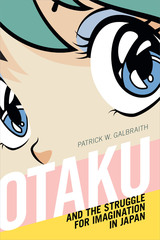 Otaku and the Struggle for Imagination in Japan
Patrick Galbraith
Duke University Press, 2019 From computer games to figurines and maid cafes, men called “otaku” develop intense fan relationships with “cute girl” characters from manga, anime, and related media and material in contemporary Japan. While much of the Japanese public considers the forms of character love associated with “otaku” to be weird and perverse, the Japanese government has endeavored to incorporate “otaku” culture into its branding of “Cool Japan.” In Otaku and the Struggle for Imagination in Japan, Patrick W. Galbraith explores the conflicting meanings of “otaku” culture and its significance to Japanese popular culture, masculinity, and the nation. Tracing the history of “otaku” and “cute girl” characters from their origins in the 1970s to his recent fieldwork in Akihabara, Tokyo (“the Holy Land of Otaku”), Galbraith contends that the discourse surrounding “otaku” reveals tensions around contested notions of gender, sexuality, and ways of imagining the nation that extend far beyond Japan. At the same time, in their relationships with characters and one another, “otaku” are imagining and creating alternative social worlds.
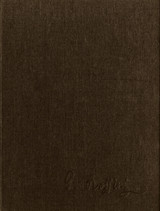 Otello, ossia Il Moro di Venezia: Dramma per musica in Three Acts by Francesco Berio di Salsa
Gioachino Rossini
University of Chicago Press, 1994 Rossini's Otello, first performed in 1816, remained an immensely popular opera throughout the nineteenth century and was only eclipsed by Verdi's more Shakespearean version. The critical edition by Michael Collins allows us to rediscover Rossini's Otello as one of the composer's early masterpieces in the tragic genre.
The first of eight serious operas newly-written for the Teatro San Carlo of Naples, Otello reveals Rossini as a composer deeply concerned with both character development and large-scale musical forms. Desdemona's "Willow Song" is a fine example: here not only is variation technique used for dramatic ends, but the song itself forms part of a larger scheme that encompasses the entire third act as a single, unified piece.
Far more than a mere forerunner to Verdi, Rossini's Otello deserves to be known for its own innovative qualities.
Othea’s Letter to Hector
Christine de Pizan
Iter Press, 2017 Othea’s Letter to Hector, one of Christine de Pizan’s most popular works, is at the same time one of her most complex creations. Combining a somewhat Sibylline verse text based on a mythological figure with extensive citation of pagan sapiential authorities, the Bible, and the Church Fathers, it showcases Christine’s extraordinary learning and her innovative approach to didacticism. An appendix provides new insights on her skillful use of patristic sources and creative command of Latin authors.
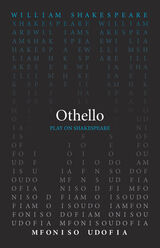 Othello
William Shakespeare
Arizona Center for Medieval and Renaissance Studies, 2022 A contemporary translation that emphasizes the racial malice at the heart of Shakespeare’s play.
In her update of Shakespeare’s Othello, Mfoniso Udofia engages with the racial malice at the heart of the play. Udofia’s take on this complicated story emphasizes the rhythm and lyrical patterns of Othello’s speech. Opening up the text to modern ears, Udofia presents us with a code-switched Othello.
This translation of Othello was written as part of the Oregon Shakespeare Festival’s Play On! project, which commissioned new translations of thirty-nine Shakespeare plays. These translations present the work of “The Bard” in language accessible to modern audiences while never losing the beauty of Shakespeare’s verse. Enlisting the talents of a diverse group of contemporary playwrights, screenwriters, and dramaturges from diverse backgrounds, this project reenvisions Shakespeare for the twenty-first century. These volumes make these works available for the first time in print—a new First Folio for a new era.
Othello and Interpretive Traditions
Edward Pechter
University of Iowa Press, 1999 During the past twenty years or so, Othello has become the Shakespearean tragedy that speaks most powerfully to our contemporary concerns. Focusing on race and gender (and on class, ethnicity, sexuality, and nationality), the play talks about what audiences want to talk about. Yet at the same time, as refracted through Iago, it forces us to hear what we do not want to hear; like the characters in the play, we become trapped in our own prejudicial malice and guilt.
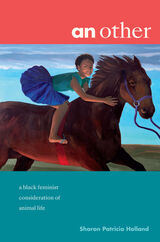 an other: a black feminist consideration of animal life
Sharon Patricia Holland
Duke University Press, 2023 In an other, Sharon Patricia Holland offers a new theorization of the human animal/divide by shifting focus from distinction toward relation in ways that acknowledge that humans are also animals. Holland centers ethical commitments over ontological concerns to spotlight those moments when Black people ethically relate with animals. Drawing on writers and thinkers ranging from Hortense Spillers, Sara Ahmed, Toni Morrison, and C. E. Morgan to Jane Bennett, Jacques Derrida, and Donna Haraway, Holland decenters the human in Black feminist thought to interrogate blackness, insurgence, flesh, and femaleness. She examines MOVE’s incarnation as an animal liberation group; uses sovereignty in Morrison’s A Mercy to understand blackness, indigeneity, and the animal; analyzes Charles Burnett’s films as commentaries on the place of animals in Black life; and shows how equestrian novels address Black and animal life in ways that rehearse the practices of the slavocracy. By focusing on doing rather than being, Holland demonstrates that Black life is not solely likened to animal life; it is relational and world-forming with animal lives.
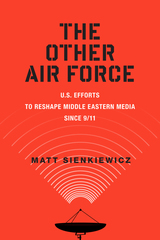 The Other Air Force: U.S. Efforts to Reshape Middle Eastern Media Since 9/11
Sienkiewicz, Matt
Rutgers University Press, 2016 Winner of the 2019 Alpha Sigma Nu Book Award
As it seeks to win the hearts and minds of citizens in the Muslim world, the United States has poured millions of dollars into local television and radio programming, hoping to generate pro-American currents on Middle Eastern airwaves. However, as this fascinating new book shows, the Middle Eastern media producers who rely on these funds are hardly puppets on an American string, but instead contribute their own political and creative agendas while working within U.S. restrictions. The Other Air Force gives readers a unique inside look at television and radio production in Afghanistan and the Palestinian territories, from the isolated villages of the Afghan Panjshir Valley to the congested streets of Ramallah. Communications scholar Matt Sienkiewicz explores how the U.S. takes a “soft-psy” approach to its media efforts combining “soft” methods of encouraging entertainment programming, such as adaptations of The Voice and The Apprentice with more militaristic “psy-ops” approaches to information control. Drawing from years of field research and interviews with everyone from millionaire executives to underpaid but ever resourceful cameramen, Sienkiewicz considers the perspectives of the Afghan and Palestinian media workers trying to forge viable broadcasting businesses without straying outside American-set boundaries for acceptable content. As it carefully examines the interplay of U.S. military and economic might with the capacity for local ingenuity and resistance, the book also analyzes the intriguingly complex programming that emerges from this tension. Combining eyewitness reportage with cutting-edge scholarship, The Other Air Force reveals the remarkable creative output that can emerge even from the world’s tensest conflict zones.
 The Other Altar
Nicholas Gulig
University Press of Colorado, 2024 Nicholas Gulig’s third collection of poetry, The Other Altar, unearths a landscape where the experience of loss is both local and global, personal and political, here and far away. The speaker of these poems wanders in a world illumined at every turn by ghosts whose shape and form he hopes to language in a litany of books, one inside the other. Haunting these pages are the specter of a dead father and the racial violence of a specifically American time and place. Against this backdrop of abiding heartache, Gulig turns to those he loves and to whom he feels indebted—his wife and children, his friends, and to the ghosts of other writers, his literary ancestors—trusting that a language rooted beyond the borders of our collective isolation, a poetry formed upon the altar of other people, might guide the self in the direction of a reenchanted, less solitary experience of creation. The Other Altar is a book that struggles on every page to remind the reader that grief and grace are intertwined, that liberation is a path we walk together, hand in hand and heart to heart, a place we speak into existence when the distance between word and world dissolves.
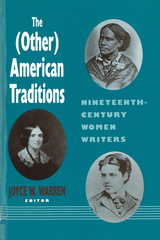 The (Other) American Traditions: Nineteenth-Century Women Writers
Warren, Joyce W
Rutgers University Press, 1993 The American literary canon has been the subject of debate and change for at least a decade. As women writers and writers of color are being rediscovered and acclaimed, the question of whether they are worthy of inclusion remains open.
The (Other) American Traditions brings together for the first time in one place, essays on individual writers and traditions that begin to ask the harder questions. How do we talk about these writers once we get beyond the historical issues? How is their work related to their male counterparts? How is it similar: how is it different? Are differences related to gender or race or class? How has the selection of books in the literary canon (Melville, Hawthorne, Emerson, and James) led to a definition of the American tradition that was calculated to exclude women? Do we need a new critical vocabulary to discuss these works? Should we stop talking about a tradition and begin to talk about many traditions? How did black American women writers develop strategies for speaking out when they were doubly in jeopardy of being ignored as blacks and as women? The volume offers irrefutable proof that the writers, the critics who work on their texts, all these questions, and the expansion of the canon matter very much indeed. Contributors: Nina Baym, Deborah Carlin, Joanne Dobson, Josephine Donovan, Judith Fetterley, Frances Smith Foster, Susan K. Harris, Karla F.C. Holloway, Paul Lauter, Diane Lichtenstein, Carla L. Peterson, Carol J. Singley, Jane Tompkins, Joyce W. Warren and Sandra A. Zagarell.
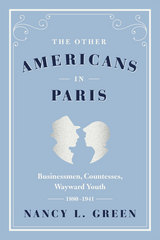 The Other Americans in Paris: Businessmen, Countesses, Wayward Youth, 1880-1941
Nancy L. Green
University of Chicago Press, 2014 While Gertrude Stein hosted the literati of the Left Bank, Mrs. Bates-Batcheller, an American socialite and concert singer in Paris, held sumptuous receptions for the Daughters of the American Revolution in her suburban villa. History may remember the American artists, writers, and musicians of the Left Bank best, but the reality is that there were many more American businessmen, socialites, manufacturers’ representatives, and lawyers living on the other side of the River Seine. Be they newly minted American countesses married to foreigners with impressive titles or American soldiers who had settled in France after World War I with their French wives, they provide a new view of the notion of expatriates.
Nancy L. Green thus introduces us for the first time to a long-forgotten part of the American overseas population—predecessors to today’s expats—while exploring the politics of citizenship and the business relationships, love lives, and wealth (and poverty for some) of Americans who staked their claim to the City of Light. The Other Americans in Paris shows that elite migration is a part of migration tout court and that debates over “Americanization” have deep roots in the twentieth century.
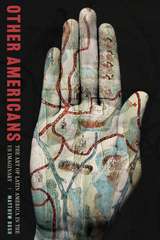 Other Americans: The Art of Latin America in the US Imaginary
Matthew Bush
University of Pittsburgh Press, 2022 Grounded in perspectives of affect theory, Other Americans examines the writings of Roberto Bolaño and Daniel Alarcón; films by Alfonso Cuarón, Claudia Llosa, Matt Piedmont, and Joel and Ethan Coen; as well as the Netflix serials Narcos and El marginal. These widely consumed works about Latin America—equally balanced between narratives produced in the United States and in the region itself—are laden with fear, anxiety, and shame, which has an impact that exceeds the experience of reception. The negative feelings encoded in visions of Latin America become common coinage for US audiences, shaping their ideological relationship with the region and performing an affective interpellation. By analyzing the underlying melodramatic structures of these works that would portray Latin America as an implicit other, Bush examines a process of affective comprehension that foments an us/them, or north/south binary in the reception of Latin America’s globalized art.
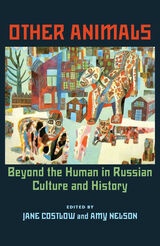 Other Animals: Beyond the Human in Russian Culture and History
Jane Costlow
University of Pittsburgh Press, 2010 The lives of animals in Russia are intrinsically linked to cultural, political and psychological transformations of the Imperial, Soviet, and post-Soviet eras. Other Animals examines the interaction of animals and humans in Russian literature, art, and life from the eighteenth century until the present. The chapters probe a range of human-animal relationships through tales of cruelty, interspecies communion and compassion, and efforts to either overcome or establish the human-animal divide. These essays also explore the unique nature of the Russian experience in this regard.
Four themes run through the volume: the prevalence of animals in utopian visions; the ways in which Russians have both incorporated and sometimes challenged Western sensibilities and practices, such as the humane treatment of animals and the inclusion of animals in urban domestic life; the quest to identify and at times exploit the physiological basis of human and animal behavior and the ideological implications of these practices; and the breakdown of traditional human-animal hierarchies and categories during times of revolutionary upheaval, social transformation, or disintegration.
From failed Soviet attempts to transplant the semi-nomadic Sami and their reindeer herds onto collective farms, to performance artist Oleg Kulik’s scandalous portrayal of Pavlov’s dogs as a parody of the Soviet “new man,” to novelist Tatyana Tolstaya’s post-cataclysmic future world of hybrid animal species and their disaffection from the past, Other Animals presents a completely new perspective on Russian and Soviet history. It also offers a fascinating look into the Russian psyche as seen through human interactions with animals.
The Other Arab-Israeli Conflict: Making America's Middle East Policy, from Truman to Reagan
Steven L. Spiegel
University of Chicago Press, 1985 The Other Arab-Israeli Conflict illuminates the controversial course of America's Middle East relations from the birth of Israel to the Reagan administration. Skillfully separating actual policymaking from the myths that have come to surround it, Spiegel challenges the belief that American policy in the Middle East is primarily a relation to events in that region or is motivated by bureaucratic constraints or the pressures of domestic politics. On the contrary, he finds that the ideas and skills of the president and his advisors are critical to the determination of American policy. This volume received the 1986 National Jewish Book Award.
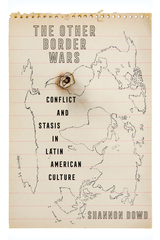 The Other Border Wars: Conflict and Stasis in Latin American Culture
Shannon Dowd
University of Pittsburgh Press, 2024 The Other Border Wars: Conflict and Stasis in Latin American Culture questions bordering as an organizing principle of culture, conflict, and politics. Shannon Dowd argues that Central and South American border conflicts such as the Chaco War, between Bolivia and Paraguay (1932–1935); the Soccer War, between El Salvador and Honduras (1969); and the Falklands/Malvinas War, between Argentina and the United Kingdom (1982); can be considered as stasis, meaning civil strife, rather than polemos, meaning international war. Through analyses of literature, film, and theater, Dowd shows that border conflict is entwined with domestic strife, reinforced by stagnant geographical lines, and magnified under globalization. Deploying a capacious theory of stasis to question modern sovereignty and bordering, Dowd examines border zones from the outbreak of hostilities to the present, highlighting the lasting legacies of enclosure and violence. The Other Border Wars asks readers to consider how cultural expression challenges the purported fixity of Latin American borders, and even the very idea of bordering.
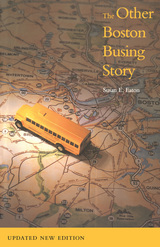 The Other Boston Busing Story: What's Won and Lost Across the Boundary Line
Susan E. Eaton
Brandeis University Press, 2020 METCO, America’s longest-running voluntary school desegregation program, buses black children from Boston’s city neighborhoods to predominantly white suburban schools. In contrast to the infamous violence and rage that greeted forced school busing within the city in the 1970s, the work of METCO has quietly and calmly promoted school integration. But how has this program affected the lives of its graduates? Would they choose to participate if they had it to do over again? Would they place their own children on the bus to suburbia? In The Other Boston Busing Story, sixty-five METCO graduates who are now adults answer those questions and more, vividly recalling their own stories and assessing the benefits and hardships of crossing racial and class lines on their way to school. As courts and policymakers today are forcing the abandonment of desegregation, this book offers an accessible and moving account of a rare program that, despite serious challenges, provides a practical remedy for the persistent inequalities in American education. This new edition puts the original findings in a contemporary context.
The Other Brahmins: Boston's Black Upper Class 1750-1950
Adelaide Cromwell
University of Arkansas Press, 1995 Adelaide Cromwell’s pioneering work explores race and the social caste system in an atypical northern environment over a period of two centuries. Based on scholarly sources, interviews, and questionnaires, the study identifies those blacks in Boston who exercised political, economic, and social leadership from the end of the eighteenth century to the middle of the twentieth. The central focus is a comparison of black and white upper-class women in the 1940s. This rare look at a black social microcosm not located in the South is seminal and timely. Because it concludes at a critical period in American history, The Other Brahmins paints a colorful backdrop for evaluating subsequent changes in urban sociology and stratification. In a groundbreaking study, Cromwell effectively challenges the simplistic notions of hierarchy as they pertain to race.
The Other California: The Great Central Valley In Life And Letters
Gerald W. Haslam
University of Nevada Press, 1993 Oildale native, Gerald Haslam, doesn’t like it when folks dismiss the Central Valley as boring and flat. In this collection of essays, he argues that it is California’s heartland and economic hub. In addition, the valley has produced a crop of gifted writers. These nineteen essays range from reminiscences of childhood and adolescence to a portrait of Mexican-Americans and their position in the Valley’s society to a moving essay about having the author’s aging father come to live with the family. Even if you have never lived in the Valley, reading this book will give you an entirely new perspective the next time you drive into it.
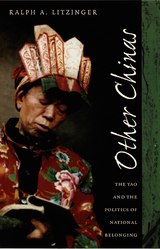 Other Chinas: The Yao and the Politics of National Belonging
Ralph A. Litzinger
Duke University Press, 2000 In Other Chinas Ralph A. Litzinger investigates the politics of ethnic identity in postsocialist China. By combining innovative research with extensive fieldwork conducted during the late 1980s and early 1990s in south-central and southwestern China, Litzinger provides a detailed ethnography of the region’s Yao population in order to question how minority groups are represented in China. In particular, he focuses on how elite members of this minority population have represented their own culture, history, and identity to a range of Chinese and Western observers.
Litzinger begins by describing how during the Republican period the Yao were considered a dangerous people who preferred to consort with beasts and goblins rather than join in the making of a modern nation. He then compares this to the communist revolutionaries’ view of the Yao as impressive rebels and positive examples of subaltern agency. Litzinger shows how scholars, government workers, communist party officials, and Taoist ritual specialists have influenced the varied depictions of the Yao and, in doing so, he advances a new understanding of both the Yao and the effects of official discourse, written histories, state policy, and practices of minority empowerment. In addition to analyzing issues of ritual practice, social order, morality, and the governance of ethnic populations, Litzinger considers the Yao’s role in the cultural reforms of the 1980s. By distancing his study from romanticized depictions of minorities Litzinger is able to focus on how minority representation, struggle, and agency have influenced the history of the People’s Republic, cultural debates within contemporary Chinese society, and China’s rapidly changing role in the global order.
This book will be of interest to Asianists in both anthropology and cultural studies and should appeal more generally to scholars invested in issues of ethnic identity, minority politics, and transnationalism.
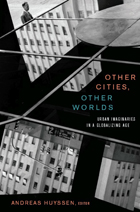 Other Cities, Other Worlds: Urban Imaginaries in a Globalizing Age
Andreas Huyssen, ed.
Duke University Press, 2008 Other Cities, Other Worlds brings together leading scholars of cultural theory, urban studies, art, anthropology, literature, film, architecture, and history to look at non-Western global cities. The contributors focus on urban imaginaries, the ways that city dwellers perceive or imagine their own cities. Paying particular attention to the historical and cultural dimensions of urban life, they bring to their essays deep knowledge of the cities they are bound to in their lives and their work. Taken together, these essays allow us to compare metropolises from the so-called periphery and gauge processes of cultural globalization, illuminating the complexities at stake as we try to imagine other cities and other worlds under the spell of globalization. The effects of global processes such as the growth of transnational corporations and investment, the weakening of state sovereignty, increasing poverty, and the privatization of previously public services are described and analyzed in essays by Teresa P. R. Caldeira (São Paulo), Beatriz Sarlo (Buenos Aires), Néstor García Canclini (Mexico City), Farha Ghannam (Cairo), Gyan Prakash (Mumbai), and Yingjin Zhang (Beijing). Considering Johannesburg, the architect Hilton Judin takes on themes addressed by other contributors as well: the relation between the country and the city, and between racial imaginaries and the fear of urban violence. Rahul Mehrotra writes of the transitory, improvisational nature of the Indian bazaar city, while AbdouMaliq Simone sees a new urbanism of fragmentation and risk emerging in Douala, Cameroon. In a broader comparative frame, Okwui Enwezor reflects on the proliferation of biennales of contemporary art in African, Asian, and Latin American cities, and Ackbar Abbas considers the rise of fake commodity production in China. The volume closes with the novelist Orhan Pamuk’s meditation on his native city of Istanbul. Contributors: Ackbar Abbas, Teresa P. R. Caldeira, Néstor García Canclini, Okwui Enwezor, Farha Ghannam, Andreas Huyssen, Hilton Judin, Rahul Mehrotra, Orhan Pamuk, Gyan Prakash, Beatriz Sarlo, AbdouMaliq Simone, Yingjin Zhang
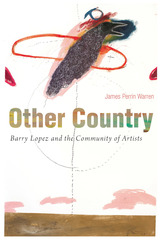 Other Country: Barry Lopez and the Community of Artists
James Perrin Warren
University of Arizona Press, 2015 The award-winning American environmental writer Barry Lopez has traveled extensively in remote and populated parts of the world. Lopez’s fiction and nonfiction focus on the relationship between the physical landscape and human culture, posing abiding questions about ethics, intimacy, and place.
Other Country presents a full-scale treatment of Lopez’s work. James Perrin Warren examines the relationship between Lopez’s writing and the work of several contemporary artists, composers, and musicians, whose works range from landscape photography, painting, and graphic arts to earth art, ceramics, and avant-garde music. The author demonstrates Lopez’s role in creating this community of artists who have led cultural change, and shows that Lopez’s writing—and his engagement with the natural world—creates an “other country” by redefining boundaries, rediscovering a place, and renewing our perceptions of landscapes.
Warren’s critique examines manuscripts and typescripts from the 1960s to the present, interviews with Lopez conducted from 2008 to 2013, and interviews with artists. Part 1 focuses on the relationship between Lopez’s storytelling, which he calls “a conversation with the land,” and Robert Adams’s landscape photography. For both Lopez and Adams, a worthy artistic expression serves the cultural memory of a community, reminding us how to behave properly toward other people and the land. Part 2 looks at the collaborative friendship of Lopez and visual artist Alan Magee, tracking the development of Lopez’s short stories through a consideration of Magee’s career. Part 3 moves farther afield, discussing Lopez’s relationship to Richard Long’s earth art, Richard Rowland’s ceramics, and John Luther Adams’s soundscapes.
Other Country reveals the dynamic relationships between Lopez, considered by many the most important environmental writer working in America, and the artistic community, who seek to explore the spiritual and ethical dimensions of an honorable and attentive relationship to the land and thus offer profound implications for the future of the planet.
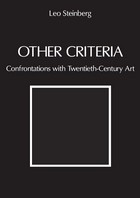 Other Criteria: Confrontations with Twentieth-Century Art
Leo Steinberg
University of Chicago Press, 2007 Leo Steinberg’s classic Other Criteria comprises eighteen essays on topics ranging from “Contemporary Art and the Plight of Its Public” and the “flatbed picture plane” to reflections on Picasso, Rauschenberg, Rodin, de Kooning, Pollock, Guston, and Jasper Johns. The latter, which Francine du Plessix Gray called “a tour de force of critical method,” is widely regarded as the most eye-opening analysis of the Johns’s work ever written. This edition includes a new preface and a handful of additional illustrations.
“The art book of the year, if not of the decade and possibly of the century. . . .The significance of this volume lies not so much in the quality of its insights—although the quality is very high and the insights are important—as in the richness, precision, and elegance of its style. . . . A meeting with the mind of Leo Steinberg is one of the most enlightening experiences that contemporary criticism affords.” —Alfred Frankenstein, Art News
“Not only one of the most lucid and independent minds among art critics, but a profound one.”—Robert Motherwell
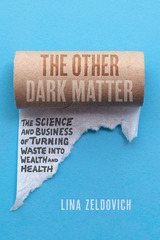 The Other Dark Matter: The Science and Business of Turning Waste into Wealth and Health
Lina Zeldovich
University of Chicago Press, 2021 Grossly ambitious and rooted in scientific scholarship, The Other Dark Matter shows how human excrement can be a life-saving, money-making resource—if we make better use of it.
The average person produces about four hundred pounds of excrement a year. More than seven billion people live on this planet. Holy crap!
Because of the diseases it spreads, we have learned to distance ourselves from our waste, but the long line of engineering marvels we’ve created to do so—from Roman sewage systems and medieval latrines to the immense, computerized treatment plants we use today—has also done considerable damage to the earth’s ecology. Now scientists tell us: we’ve been wasting our waste. When recycled correctly, this resource, cheap and widely available, can be converted into a sustainable energy source, act as an organic fertilizer, provide effective medicinal therapy for antibiotic-resistant bacterial infection, and much more.
In clear and engaging prose that draws on her extensive research and interviews, Lina Zeldovich documents the massive redistribution of nutrients and sanitation inequities across the globe. She profiles the pioneers of poop upcycling, from startups in African villages to innovators in American cities that convert sewage into fertilizer, biogas, crude oil, and even life-saving medicine. She breaks taboos surrounding sewage disposal and shows how hygienic waste repurposing can help battle climate change, reduce acid rain, and eliminate toxic algal blooms. Ultimately, she implores us to use our innate organic power for the greater good. Don’t just sit there and let it go to waste.
 Other Death: Ellipsis
Ferenc Barnás
Seagull Books, 2025 A lecturer’s descent into psychological chaos unfolds against the turbulent backdrop of 1990s Budapest.
In Other Death, we are thrown into the chaotic life of a forty-year-old university lecturer who is experiencing a sudden, complete psychological and existential breakdown. Afternoons disappear and years chop and change in confusion as he wanders the streets searching for work. Homelessness, alcoholism, and hate are on the rise in 1990s Budapest as symptoms of the regime change. Images flash up from other lives: a Boer pointing a shotgun in Johannesburg, bodies heaped up in the downtown area, a Volkswagen campervan parked by an empty phone box in Switzerland. As he encounters new and historic traumas embedded in the lives and the buildings around him, the unnamed narrator struggles to grasp any coherent identity. It’s only when he starts to work as a gallery attendant, observing the interactions between viewer and artwork, light and space, that he embarks on the slow healing routine towards clarity.
In Barnás’s semi-autobiographical novel, meditations on trauma and urban space, image and observation, and spiritual friendships echo the writings of W. G. Sebald and Thomas Bernhard. Like Vertigo meets The Bell Jar, the magnetic language of Other Death draws the reader into the murky workings of a mind severely afflicted.
 The Other Digital China: Nonconfrontational Activism on the Social Web
Jing Wang
Harvard University Press, 2019 A scholar and activist tells the story of change makers operating within the Chinese Communist system, whose ideas of social action necessarily differ from those dominant in Western, liberal societies.
The Chinese government has increased digital censorship under Xi Jinping. Why? Because online activism works; it is perceived as a threat in halls of power. In The Other Digital China, Jing Wang, a scholar at MIT and an activist in China, shatters the view that citizens of nonliberal societies are either brainwashed or complicit, either imprisoned for speaking out or paralyzed by fear. Instead, Wang shows the impact of a less confrontational kind of activism. Whereas Westerners tend to equate action with open criticism and street revolutions, Chinese activists are building an invisible and quiet coalition to bring incremental progress to their society.
Many Chinese change makers practice nonconfrontational activism. They prefer to walk around obstacles rather than break through them, tactfully navigating between what is lawful and what is illegitimate. The Other Digital China describes this massive gray zone where NGOs, digital entrepreneurs, university students, IT companies like Tencent and Sina, and tech communities operate. They study the policy winds in Beijing, devising ways to press their case without antagonizing a regime where taboo terms fluctuate at different moments. What emerges is an ever-expanding networked activism on a grand scale. Under extreme ideological constraints, the majority of Chinese activists opt for neither revolution nor inertia. They share a mentality common in China: rules are meant to be bent, if not resisted.
Other Emergencies: Stories
Sarah Freligh
Moon City, 2025 The “other emergencies” experienced by Sarah Freligh’s characters range from mildly disruptive to life-altering. In “All That Water,” a college dropout struggling with addiction forges an unlikely alliance with a bank teller following a botched robbery. In “Aftershocks,” a writer grieving the loss of her support dog is haunted by the memory of what she witnessed on 9/11. In “Happenstance,” two women from different backgrounds form a tenuous connection over the shared experience of their histories. And in “Heaven,” a detective and a high school girl navigate the fraught terrain in the days following a mass shooting in a small town. Ultimately the stories in Other Emergencies revolve around the resilience of people and the capacity for authentic connection in times of great change.
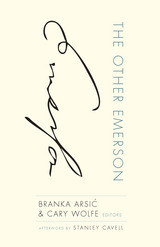 The Other Emerson
Branka Arsic
University of Minnesota Press, 2010 Ralph Waldo Emerson is one of the most significant figures in nineteenth-century American literature and culture-indeed, this collection argues, in the history of philosophy. The Other Emerson is a thorough reassessment of the philosophical underpinnings, theoretical innovations, and ethical and political implications of the prose writings of one of America's most enduring thinkers.
Considering Emerson first and foremost as a daring and original thinker, The Other Emerson focuses on three Emersonian subjects-subjectivity, the political, and the nature of philosophy-and range in topic from Emerson's relationships to slavery and mourning to his place in the development of Romanticism as reread by contemporary systems theory. It is Emerson's appreciation of truth's instability that link him to the European philosophical tradition.
Contributors: Eduardo Cadava, Princeton U; Sharon Cameron, Johns Hopkins U; Russell B. Goodman, U of New Mexico; Paul Grimstad, Yale U; Eric Keenaghan, U at Albany, SUNY; Gregg Lambert, Syracuse U; Sandra Laugier, Université de Picardie Jules Verne; Donald Pease, Dartmouth College.
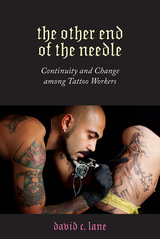 The Other End of the Needle: Continuity and Change among Tattoo Workers
David C. Lane
Rutgers University Press, 2021 The Other End of the Needle demonstrates that tattooing is more complex than simply the tattoos that people wear. Using qualitative data and an accessible writing style, sociologist Dave Lane explains the complexity of tattoo work as a type of social activity. His central argument is that tattooing is a social world, where people must be socialized, manage a system of stratification, create spaces conducive for labor, develop sets of beliefs and values, struggle to retain control over their tools, and contend with changes that in turn affect their labor. Earlier research has examined tattoos and their meanings.
Yet, Lane notes, prior research has focused almost exclusively on the tattoos—the outcome of an intricate social process—and have ignored the significance of tattoo workers themselves. "Tattooists," as Lane dubs them, make decisions, but they work within a social world that constrains and shapes the outcome of their labor—the tattoo. The goal of this book is to help readers understand the world of tattoo work as an intricate and nuanced form of work. Lane ultimately asks new questions about the social processes occurring prior to the tattoo’s existence.
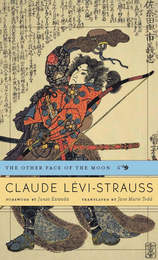 The Other Face of the Moon
Claude Lévi-Strauss
Harvard University Press, 2013 Gathering for the first time all of Claude Lévi-Strauss’s writings on Japanese civilization, The Other Face of the Moon forms a sustained meditation into the French anthropologist’s dictum that to understand one’s own culture, one must regard it from the point of view of another.
Exposure to Japanese art was influential in Lévi-Strauss’s early intellectual growth, and between 1977 and 1988 he visited the country five times. The essays, lectures, and interviews of this volume, written between 1979 and 2001, are the product of these journeys. They investigate an astonishing range of subjects—among them Japan’s founding myths, Noh and Kabuki theater, the distinctiveness of the Japanese musical scale, the artisanship of Jomon pottery, and the relationship between Japanese graphic arts and cuisine. For Lévi-Strauss, Japan occupied a unique place among world cultures. Molded in the ancient past by Chinese influences, it had more recently incorporated much from Europe and the United States. But the substance of these borrowings was so carefully assimilated that Japanese culture never lost its specificity. As though viewed from the hidden side of the moon, Asia, Europe, and America all find, in Japan, images of themselves profoundly transformed.
As in Lévi-Strauss’s classic ethnography Tristes Tropiques, this new English translation presents the voice of one of France’s most public intellectuals at its most personal.
 The OTHER FIFTIES: INTERROGATING MIDCENTURY AMERICAN ICONS
Joel Foreman
University of Illinois Press, 1997 From the Edsel to Eisenhower, from Mau Mau to Doris Day, and from Ayn Rand to Elvis, contributors to The Other Fifties topple the decade's already weakened image as a time of unprecedented peace, prosperity, and conformity. Representing the fifties as a period of cultural transformation, contributors reveal the gradual "unmaking" of traditions and value systems that took place as American culture prepared itself for the more easily observed cultural turbulence of the 1960s. Well known contributors demonstrate how television, the novel, the Hollywood movie, the Broadway musical, and rock and roll assaulted midcentury American attitudes toward sexuality, race, gender, and class, so altering public sensibilities that what was novel or shocking in the fifties seems tame or even downright difficult to grasp today. They also rebut the widely held view that 1950s consumerism led to cultural homogeneity, replacing this view with a picture of robust popular markets that defied conservative controls and actively subverted
conventional norms and values. Brushing away the haze of an era, The Other Fifties will help readers understand the decade not as placid or repressed, but as a time when emancipatory desires struggled to articulate themselves.
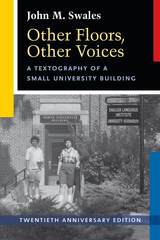 Other Floors, Other Voices, Twentieth Anniversary Edition: A Textography of a Small University Building
John M. Swales
University of Michigan Press, 2018 “John Swales’ textography might also be called ‘comparative rhetoric in a small building,’ offering proof, once again, that another culture may be only a trip up or down a flight of stairs. . . .such an appealing and original book.” ---BAAL News
Originally published in 1998, Other Floors, Other Voices uses texts to capture the lives of three communities operating within a single building (the North University Building, or NUBS) on the University of Michigan campus. Swales' thoughtful exploration of the three units—the Computer Resource Site, the University Herbarium (botany), and the English Language Institute—centers around the individuals who work on each floor and the discourse-related activities they engage in.
The Twentieth Anniversary Edition of Other Floors, Other Voices includes: a new preface, an introductory essay on the value of rereading this volume many years after publication, and an epilogue that reflects on and reveals what has happened to the three units in the past 20 years.
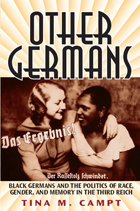 Other Germans: Black Germans and the Politics of Race, Gender, and Memory in the Third Reich
Tina M. Campt
University of Michigan Press, 2005 It's hard to imagine an issue or image more riveting than Black Germans during the Third Reich. Yet accounts of their lives are virtually nonexistent, despite the fact that they lived through a regime dedicated to racial purity.
Tina Campt's Other Germans tells the story of this largely forgotten group of individuals, with important distinctions from other accounts. Most strikingly, Campt centers her arguments on race, rather than anti-semitism. She also provides oral history as background for her study, interviewing two Black Germans for the book.
In the end, the author comes face to face with an inevitable question: Is there a relationship between the history of Black Germans and those of other black communities?
The answers to Campt's questions make Other Germans essential reading in the emerging study of what it meant to be black and German in the context of a society that looked at anyone with non-German blood as racially impure at best.
Tina Campt is Associate Professor of Women's Studies at Duke University.
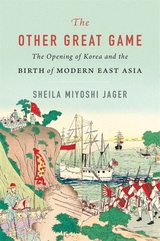 The Other Great Game: The Opening of Korea and the Birth of Modern East Asia
Sheila Miyoshi Jager
Harvard University Press, 2023 Winner of the Duke of Wellington Medal for Military History.
A dramatic new telling of the dawn of modern East Asia, placing Korea at the center of a transformed world order wrought by imperial greed and devastating wars.
In the nineteenth century, Russia participated in two “great games”: one, well known, pitted the tsar’s empire against Britain in Central Asia. The other, hitherto unrecognized but no less significant, saw Russia, China, and Japan vying for domination of the Korean Peninsula. In this eye-opening account, brought to life in lucid narrative prose, Sheila Miyoshi Jager argues that the contest over Korea, driven both by Korean domestic disputes and by great-power rivalry, set the course for the future of East Asia and the larger global order.
When Russia’s eastward expansion brought it to the Korean border, an impoverished but strategically located nation was wrested from centuries of isolation. Korea became a prize of two major imperial conflicts: the Sino-Japanese War at the close of the nineteenth century and the Russo-Japanese War at the beginning of the twentieth. Japan’s victories in the battle for Korea not only earned the Meiji regime its yearned-for colony but also dislodged Imperial China from centuries of regional supremacy. And the fate of the declining tsarist empire was sealed by its surprising military defeat, even as the United States and Britain sized up the new Japanese challenger.
A vivid story of two geopolitical earthquakes sharing Korea as their epicenter, The Other Great Game rewrites the script of twentieth-century rivalry in the Pacific and enriches our understanding of contemporary global affairs, from the origins of Korea’s bifurcated identity—a legacy of internal politics amid the imperial squabble—to China’s irredentist territorial ambitions and Russia’s nostalgic dreams of recovering great-power status.
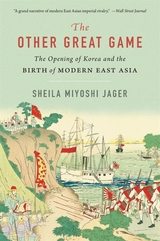 The Other Great Game: The Opening of Korea and the Birth of Modern East Asia
Sheila Miyoshi Jager
Harvard University Press Winner of the Duke of Wellington Medal for Military History, this dramatic new account of the dawn of modern East Asia places Korea at the center of a transformed world order wrought by imperial greed and devastating wars.
In the nineteenth century, Russia participated in two “great games.” One, well known, pitted the tsar’s empire against Britain in Central Asia. The other, hitherto unrecognized, saw Russia, China, and Japan vying for domination of Korea. This eye-opening account argues that the contest over Korea set the course for the future of the global order.
After centuries of isolation, Korea became a prize in the Sino-Japanese War at the close of the nineteenth century and the Russo-Japanese War at the beginning of the twentieth. Japan’s victories not only gained the Meiji regime a colony but also dislodged Imperial China from regional supremacy. As the fate of the declining tsarist empire was sealed by its surprising military defeat, the United States and Britain sized up the new Japanese challenger.
A vivid story of two geopolitical earthquakes sharing Korea as their epicenter, The Other Great Game rewrites the script of twentieth-century rivalry in the Pacific and enriches our understanding of contemporary global affairs, from the origins of Korea’s bifurcated identity—a legacy of internal politics amid the imperial squabble—to China’s irredentist ambitions and Russia’s nostalgic dreams of recovering great-power status.
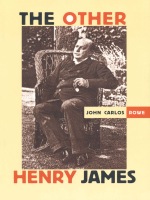 The Other Henry James
John Carlos Rowe
Duke University Press, 1998 In The Other Henry James, John Carlos Rowe offers a new vision of Henry James as a social critic whose later works can now be read as rich with homoerotic suggestiveness. Drawing from recent work in queer and feminist theory, Rowe argues that the most fruitful approach to James today is one that ignores the elitist portrait of the formalist master in favor of the writer as a vulnerable critic of his own confused and repressive historical moment. Rowe traces a particular development in James’s work, showing how in his early writings James criticized women’s rights, same-sex relations, and other social and political trends now identified with modern culture; how he ambivalently explored these aspects of modernity in his writings of the 1880s; and, later, how he increasingly identified with such modernity in his heretofore largely ignored or marginally treated fiction of the 1890s. Building on recent scholarship that has shown James to be more anxious about gender roles, more conflicted, and more marginal a figure than previously thought, Rowe argues that James—through his treatment of women, children, and gays—indicts the values and conventions of the bourgeoisie. He shows how James confronts social changes in gender roles, sexual preferences, national affiliations, and racial and ethnic identifications in such important novels as The American, The Tragic Muse, What Maisie Knew, and In the Cage, and in such neglected short fiction as “The Last of the Valerii,” “The Death of the Lion,” and “The Middle Years.” Positioning James’s work within an interpretive context that pits the social and political anxieties of his day against the imperatives of an aesthetic ideology, The Other Henry James will engage scholars, students, and teachers of American literature and culture, gay literature, and queer theory.
Other Inquisitions, 1937-1952
By Jorge Luis Borges
University of Texas Press, 1964 This remarkable book by one of the great writers of the twentieth century includes essays on a proposed universal language, a justification of suicide, a refutation of time, the nature of dreams, and the intricacies of linguistic forms. Borges comments on such literary figures as Pascal, Coleridge, Cervantes, Hawthorne, Whitman, Valéry, Wilde, Shaw, and Kafka. With extraordinary grace and erudition, he ranges in time, place, and subject from Omar Khayyam to Joseph Conrad, from ancient China to modern England, from world revolution to contemporary slang.
 The Other Insect Societies
James T. CostaWith a Foreword by Bert Hölldobler and a Commentary by Edward O. Wilson
Harvard University Press, 2006 Asked to name an insect society, most of us--whether casual or professional students of nature--quickly point to one of the so-called eusocial marvels: the ant colony, the beehive, the termite mound, the wasp nest. Each is awe-inspiring in its division of labor--collective defense, foraging, and nestbuilding. Yet E. O. Wilson cautioned back in 1971 that sociality should be defined more broadly, "in order to prevent the arbitrary exclusion of many interesting phenomena." Thirty-five years later, James T. Costa gives those interesting phenomena their due. He argues that, in trying to solve the puzzle of how highly eusocial behaviors evolved in a few insect orders, evolutionary biologists have neglected the more diverse social arrangements in the remaining twenty-eight orders--insect societies that don't fit the eusocial schema. Costa synthesizes here for the first time the scattered literature about social phenomena across the arthropod phylum: beetles and bugs, caterpillars and cockroaches, mantids and membracids, sawflies and spiders. This wide-ranging tour takes a rich narrative approach that interweaves theory and data analysis with the behavior and ecology of these remarkable groups. This comprehensive treatment is likely to inspire a new generation of naturalists to take a closer look.
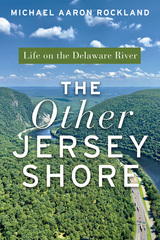 The Other Jersey Shore: Life on the Delaware River
Michael Aaron Rockland
Rutgers University Press, 2024 River otters, black bears, and red foxes drink from its clear waters. Prickly pear cacti grow from the red shale cliffs that overlook it, while on the river near Bordentown lies the archeological remnants of a sprawling estate built by the former King of Spain, Napoleon’s brother, who lived there for almost twenty years. You might imagine this magical and majestic waterway is located in some faraway land. But in fact, it’s the backbone and lifeblood of the Garden State: the Delaware River.
The Other Jersey Shore takes readers on a personal tour of the New Jersey portion of the Delaware River and its surroundings. You will learn about the role that the river played in human history, including Washington’s four crossings of the Delaware during the Revolutionary War. And you will also learn about the ecological history of the river itself, once one of the most polluted waterways in the country and now one of the cleanest, providing drinking water for 17 million people. Michael Aaron Rockland, a long-time New Jersey resident, shows readers his very favorite spots along the Delaware, including the pristine waterfalls and wilderness in the Delaware Water Gap recreation area. Along the way, he shares engrossing stories and surprising facts about the river that literally defines western New Jersey.
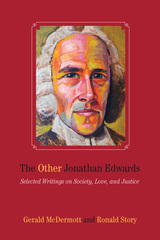 The Other Jonathan Edwards: Selected Writings on Society, Love, and Justice
Gerald McDermott
University of Massachusetts Press, 2015 Widely regarded as perhaps America's greatest theologian, Jonathan Edwards still suffers the stereotype of hellfire preacher obsessed with God's wrath. In this anthology, Gerald McDermott and Ronald Story seek to correct that common view by showing that Edwards was also a compassionate, socially conscious minister of the first order.
Through a selection of sermons and primary writings, McDermott and Story reveal an Edwards who preached love toward all humanity regardless of belief or appearance; who demanded private and public charity to the poor; who criticized hard-hearted business dealings as impious and socially destructive; and who condemned envy and status-seeking as anti-Christian and anti-community. This "other" Jonathan Edwards preached about grace and the love of God but also about responsive constitutional government, the iniquities of hypocrisy and corruption, and the nature of wise leadership. He acknowledged the need for national defense but left room for popular revolt from tyranny. He anticipated a millennial age of peace and prosperity and believed that people should live in the world as they would live through grace in heaven.
Jonathan Edwards was, in sum, a worldly as well as spiritual reformer who resisted the materialistic, acquisitive, and individualistic currents of American culture. For these reasons, McDermott and Story think he may have lessons to teach us today.
 The Other Journey: Poems New and Selected
Katherine Chapin
University of Minnesota Press, 1959
The Other Journey: Poems New and Selected was first published in 1959. Minnesota Archive Editions uses digital technology to make long-unavailable books once again accessible, and are published unaltered from the original University of Minnesota Press editions.The title poem of Katherine Garrison Chapin’s collection conveys the quality of this volume of lyrics which have appeared in magazines in the last fifteen years, and a selection from her three earlier books now out of print. The Other Journey suggests the duality of experience – an outward journey in space and inward journey of the mind. Included is a brief essay on the poetic image, and there are three translations, poems by Paul Claudel, Gabriela Mistral, and Rafael Alberti.Some of these poems have appeared in Harpers, New Republic, Nation, Saturday Review, American Scholar, Poetry, Contemporary Poetry, Voices, Ladies Home Journal, Prairie Schooner, and Botteghe Oscure. Miss Chapin’s earlier volumes of poetry are Outside of the World, Time Has No Shadow, and Plain Chant for America.
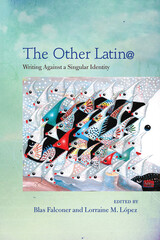 The Other Latin@: Writing Against a Singular Identity
Edited by Blas Falconer and Lorraine M. López
University of Arizona Press, 2011 “The stereotype spells death to the imagination by shrinking all possibilities to one. Generalizations encourage us to stop considering what can be.” —from the Introduction
The sheer number of different ethnic groups and cultures in the United States makes it tempting to classify them according to broad stereotypes, ignoring their unique and changing identities. Because of their growing diversity within the United States, Latinas and Latinos face this problem in their everyday lives. With cultural roots in Mexico, Puerto Rico, Cuba, the Dominican Republic, or a variety of other locales, Hispanic-origin people in the United States are too often consigned to a single category. With this book Blas Falconer and Lorraine M. López set out to change this.
The Other Latin@ is a diverse collection of essays written by some of the best emerging and established contemporary writers of Latin origin to help answer the question: How can we treat U.S. Latina and Latino literature as a definable whole while acknowledging the many shifting identities within their cultures? By telling their own stories, these authors illuminate the richness of their cultural backgrounds while adding a unique perspective to Latina and Latino literature.
This book sheds light on the dangers of abandoning identity by accepting cultural stereotypes and ignoring diversity within diversity. These contributors caution against judging literature based on the race of the author and lament the use of the term Hispanic to erase individuality. Honestly addressing difficult issues, this book will greatly contribute to a better understanding of Latina and Latino literature and identity.
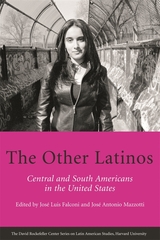 The Other Latinos
José Luis Falconi
Harvard University Press The Other Latinos addresses an important topic: the presence in the United States of Latin American and Caribbean immigrants from countries other than Mexico, Cuba, and Puerto Rico. Focusing on the Andes, Central America, and Brazil, the book brings together essays by a number of accomplished scholars.
Michael Jones-Correa's chapter is a lucid study of the complex issues in posing "established" and "other," and "old" and "new" in the discussion of Latino immigrant groups. Helen B. Marrow follows with general observations that bring out the many facets of race, ethnicity, and identity. Claret Vargas analyzes the poetry of Eduardo Mitre, followed by Edmundo Paz Soldán's reflections on Bolivians' "obsessive signs of identity." Nestor Rodriguez discusses the tensions between Mexican and Central American immigrants, while Arturo Arias's piece on Central Americans moves brilliantly between the literary (and the cinematic), the historical, and the material. Four Brazilian chapters complete the work.
The editors hope that this introductory work will inspire others to continue these initial inquiries so as to construct a more complete understanding of the realities of Latin American migration into the United States.
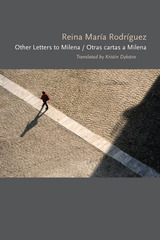 Other Letters to Milena / Otras cartas a Milena
Reina María Rodríguez
University of Alabama Press, 2014 Published in Spanish as Otras cartas a Milena, Other Letters to Milena shows Rodríguez confronting pressing issues at the turn of the twenty-first century. These involve a new post-Soviet world and the realities of diasporic existence, which have a profound effect even on people like Rodríguez who have not migrated but continue to live and work in their home nation. The book’s title references Franz Kafka, whose Letters to Milena was published after his death in 1952. This signals that Rodríguez participates in her city’s long cosmopolitan tradition asserted by Cuban writers and scholars of Cuban literature. Rodríguez’s youngest daughter, featured most prominently in the letters making up the collection’s centerpiece, “A Girl’s Story,” was named after Milena Jesenská, the recipient of Kafka’s letters.
With the poems provided in a bilingual format, the collection will be of interest both to English readers in general (this will be the first English translation of a complete Rodríguez collection not excerpted from a larger work) and to Spanish readers unable to obtain the collection in any form, given the difficulty of distributing Cuban literature outside that country.
As an introduction to the book, Dykstra has included a critical commentary. It clarifies many of the author’s references, such as details pertaining to her family history—items Dykstra learned during lengthy discussions with the author about her work—and influences about her choices in the translation.
Available directly from the University of Alabama Press is a deluxe edition that includes a handmade, limited-edition color linocut print and letterpress-printed poem signed by both Rodríguez and artist Alejandro Sainz. To purchase a copy of this unique item, select the "Other Book" above.
The Other Lover
Bruce Smith
University of Chicago Press, 2000 The Other Lover is a collection of bittersweet American love poems. Writing with jazz-like verbal panache, Bruce Smith reaches for the paradoxical pulls between sweetness and bitterness. With carefully crafted rhyming stanzas and unpredictable free verse rhythms, these poems bristle and pop like the riffs of a virtuoso horn player. The book is a personal, passionate, disturbing collection that places the reader both inside and outside of the poet's life. Deftly filtering personal experiences through improvisatory structures and a wide range of idioms, Smith communicates the want, the lack, the desire for what is missing, the sweetness of absence and pain. The pleasure of The Other Lover is in the imagination's dance in the erotic spaces between the poet and the reader.
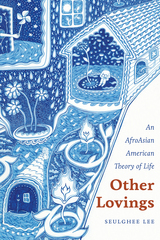 Other Lovings: An AfroAsian American Theory of Life
Seulghee Lee
Ohio State University Press, 2025 In Other Lovings, Seulghee Lee traces the presence and plenitude of love embedded in Black and Asian American literatures and cultures to reveal their irreducible power to cohere minoritarian social life. Bringing together Black studies, Asian American studies, affect theory, critical theory, and queer of color critique, Lee examines the bonds of love in works by Amiri Baraka, Audre Lorde, David Henry Hwang, Gayl Jones, Fred Moten, Adrian Tomine, and Charles Yu. He attends to the ontological force of love in popular culture, investigating Asian American hip-hop and sport through readings of G Yamazawa, Year of the Ox, and Jeremy Lin, as well as in Black public culture through bell hooks, Martin Luther King Jr., and Cornel West. By assessing love’s positive function in these works, Lee argues against critical regimes, such as Afropessimism and racial melancholia, that center negativity. In revealing what Black and Asian American traditions share in their positive configurations of being and collectivity, and in their responses to the overarching logic of white supremacy, Other Lovings suggests possibilities for thinking beyond sociological opposition and historical difference and toward political coalition and cultural affinity. Ultimately, Other Lovings argues for a counter-ontology of love—its felt presence, its relational possibilities, and its lived practices.
Other Men's Daughters
Richard Stern
Northwestern University Press, 2004 Written by one of America's finest contemporary novelists, Other Men's Daughters is the story of an intense love affair between a middle-aged professor and a young woman, wise and worldly beyond her years.
One reviewer writes, "I...was struck not simply by its psychological depth but particularly by the combination of toughness and tenderness through which romantic love was represented and discussed. The lack of sentimentality (in a novel about the refusal to live a life without love) was immensely important to me...and is likely ...to be immensely important ...today."
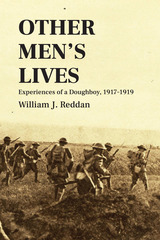 Other Men's Lives: Experiences of a Doughboy, 1917–1919
William J. Reddan
Westholme Publishing, 2017 An Attack by an American Infantry Company During World War I and Its Aftermath
“Who can explain the feelings or thoughts of a soldier during the last few minutes before a battle? He fixes his bayonet, sees that his rifle is working properly, loads it, turns the safety lock, doing a dozen things, automatically from force of training. Just a faint trace of nervousness. . . . A few of us were thinking of a wife and children hoping if it was our turn to ‘Go West,’ that the folks back home would not feel too badly.”—from Other Men’s Lives
Receiving orders in March 1917 to report for active service in the European war, Capt. William J. Reddan and his New Jersey National Guard unit joined the 29th Infantry Division of the U.S. Army. Following training for “Over There,” which included maneuvering under live machine gun and grenade fire and constant bayonet drills, Reddan assumed command of Company B, 114th Infantry—two hundred officers and men. Arriving in France in June 1918, Reddan and his company entered the frontline trenches along the Alsace front in August. Fighting side by side with the French, the 114th conducted patrols in “no man’s land,” repulsed attacks, and endured artillery and chemical barrages. Toward the end of September, the regiment was moved by truck to a new sector: the Argonne Forest. Here, Reddan and his company would be part of the Meuse-Argonne offensive, the largest in the history of the U.S. Army. This final Allied assault would last until the Armistice, November 11, 1918, and claim the most American lives of the war. On October 12, Reddan and the rest of the 114th Infantry were ordered to take a German position that was supposed to offer little resistance; instead, Reddan watched in horror as his company was destroyed: of his two hundred officers and men, only thirteen survived the ordeal. Wounded by both shrapnel and gas, Reddan was evacuated to a field hospital and did not return to his unit until after peace was declared.
Written in 1936, Other Men’s Lives: Experiences of a Doughboy, 1917–1919 recounts the complete story of Reddan’s company in the World War, including the true story of what happened in that tragic October battle as well as the political aftermath that sought to exonerate the upper command who had bungled the operation.
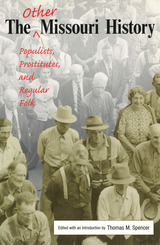 The Other Missouri History: Populists, Prostitutes, and Regular Folk
Edited & Intro by Thomas M. Spencer
University of Missouri Press, 2005 The essays in The Other Missouri History explore a wide range of topics in Missouri social history. By dealing with the lives of ordinary Missourians, these pieces examine the effects of significant social and economic change at all levels of society. With a broader scope in Missouri history than previous studies, this book demonstrates how Missourians have been affected by issues of race, class, and gender. Gregg Andrews's essay, “The Racial Politics of Reconstruction in Ralls County, 1865–1870,” examines how race shaped the political culture in Ralls County during the Reconstruction Era. Andrews argues that race-baiting was used prominently by editors of the Ralls County Record to discredit Radicals in the county and was perhaps the most powerful political weapon that conservatives and later Democrats could use to gain the allegiance of voters. Farmers are another popular topic for those practicing the “other Missouri history.” Michael J. Steiner's “The Failure of Alliance/Populism in Northern Missouri” provides insight into the economic and rhetorical reasons for the failure of Populism in Missouri. Steiner contends that white farmers in northern Missouri were happy with the status quo and rejected calls for radical reform and major change in the agricultural economy. Women began to become active in public life during the late nineteenth and early twentieth centuries. Janice Brandon-Falcone's “Constance Runcie and the Runcie Club of St. Joseph” examines the first two decades of an important women's club that still exists in St. Joseph, Missouri. Also included in The Other Missouri History are essays by Deborah J. Henry, Daniel A. Graff, Bonnie Stepenoff, Robert Faust, and Amber R. Clifford. Because of the diverse issues addressed, this volume will appeal to general readers of Missouri and Midwestern history, as well as to those who teach courses in history and have sought a supplemental text.
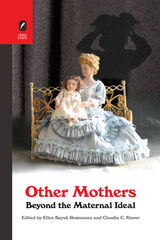 Other Mothers: Beyond the Maternal Ideal
Edited by Ellen Bayuk Rosenman and Claudia C. Klaver
Ohio State University Press, 2008 Other Mothers, edited by Ellen Bayuk Rosenman and Claudia C. Klaver, offers a range of essays that open a conversation about Victorian motherhood as a wide-ranging, distinctive experience and idea. In spite of its importance, however, it is one of the least-studied aspects of the Victorian era, subsumed under discussions of femininity and domesticity.
This collection addresses this void, revealing the extraordinary diversity of Victorian motherhood. Exploring diaries, novels, and court cases, with contexts ranging from London to Egypt to Australia, these varied accounts take the collection “beyond the maternal ideal” to consider the multiple, unpredictable ways in which motherhood was experienced and imagined in this formative historical period.
Other Mothers joins revisionist approaches to femininity that now characterize Victorian studies. Its contents trace intersections among gender, race, and class; question the power of separate spheres ideology; and insist on the context-specific nature of social roles. The fifteen essays in this volume contribute to the fields of literary criticism, history, cultural studies, and history.
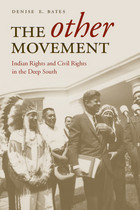 The Other Movement: Indian Rights and Civil Rights in the Deep South
Denise E. Bates
University of Alabama Press, 2022 Examines the most visible outcome of the Southern Indian Rights Movement: state Indian affairs commissions
In recalling political activism in the post-World War II South, rarely does one consider the political activities of American Indians as they responded to desegregation, the passing of the Civil Rights Acts, and the restructuring of the American political party system. Native leaders and activists across the South created a social and political movement all their own, which drew public attention to the problems of discrimination, poverty, unemployment, low educational attainment, and poor living conditions in tribal communities.
While tribal-state relationships have historically been characterized as tense, most southern tribes—particularly non-federally recognized ones—found that Indian affairs commissions offered them a unique position in which to negotiate power. Although individual tribal leaders experienced isolated victories and generated some support through the 1950s and 1960s, the creation of the inter-tribal state commissions in the 1970s and 1980s elevated the movement to a more prominent political level. Through the formalization of tribal-state relationships, Indian communities forged strong networks with local, state, and national agencies while advocating for cultural preservation and revitalization, economic development, and the implementation of community services.
This book looks specifically at Alabama and Louisiana, places of intensive political activity during the civil rights era and increasing Indian visibility and tribal reorganization in the decades that followed. Between 1960 and 1990, U.S. census records show that Alabama’s Indian population swelled by a factor of twelve and Louisiana’s by a factor of five. Thus, in addition to serving as excellent examples of the national trend of a rising Indian population, the two states make interesting case studies because their Indian commissions brought formerly disconnected groups, each with different goals and needs, together for the first time, creating an assortment of alliances and divisions.
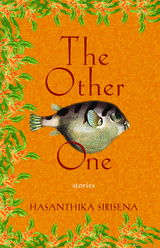 The Other One: Stories
Hasanthika Sirisena
University of Massachusetts Press, 2016 Set in Sri Lanka and America, the ten short stories in this debut collection feature characters struggling to contend with the brutality of a decades-long civil war while also seeking security, love, and hope. The characters are students, accountants, soldiers, servants. They are immigrants and strivers. They are each forced to make sometimes comic, sometimes tragic, choices. What they share, despite what they've endured, is the sustaining power of human connection.
An excerpt from the book:
“All I want to know is when you are coming? When are you bringing my sons, my family?”
She watched as a gecko, tinier than normal, skittered across the far wall. It disappeared into a small crack. The room was very hot, and she hadn't turned on the ceiling fan so that the family could save a little money. She took a handkerchief from her nightstand and wiped the beads of sweat from her forehead and the back of her neck.
“I can't leave malli alone here. He's making progress but—”
“It will be for two years only. Then you can sponsor him.”
“The lawyer says it's not so easy.”
“He's a grown man. Let the government take him. The government did this to malli. Let the government pay the price for his care.”
Even though there was no chance that her brother Ranjith could hear her, Anoja dropped her voice. “Malli is all alone here. He has nobody but aiya and me.”
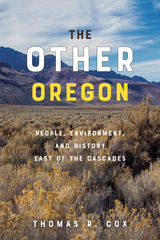 The Other Oregon: People, Environment, and History East of the Cascades
Thomas R. Cox
Oregon State University Press, 2019 The Other Oregon: People, Environment, and History East of the Cascades is a multidisciplinary work that ranges widely through a diverse and often under-appreciated land, drawing on the fields of environmental history, cultural and physical geography, and natural resource management to tell a comprehensive and compelling story.
With a staggering variety of landscapes, from high desert to alpine peaks, Oregon east of the Cascades encompasses seventeen counties and two time zones. Although this vast region defies generalization, its history is distinct from the rest of Oregon. The interrelationship between its people and the land has always been central, but that relationship has evolved and changed over time. Regional economies that were once largely exploitive and dedicated to commodity exports have slowly moved toward the husbanding of resources and to broader and deeper appreciations.
Historian Thomas Cox reveals the complexity of interactions between the people of Eastern Oregon, the land, natural resources, and one another, demonstrating how the region’s history speaks to larger American issues. The 2016 occupation of the Malheur National Wildlife Refuge, covered in detail within these pages, further reveals the relevance of Eastern Oregon to the larger world.
Written in clear and engaging prose and informed by extensive research, The Other Oregon will be a valuable resource for anyone interested in the environment, social change, and the relationships among the diverse people who make up Oregon society east of the Cascades. It will appeal to area residents and visitors, students of the American West, environmental historians, biologists, land managers, and anyone with an abiding interest in the region.
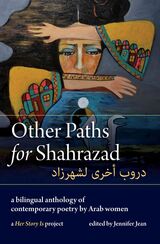 Other Paths for Shahrazad: A Bilingual Anthology of Contemporary Poetry by Arab Women
Edited by Jennifer Jean
Tupelo Press, 2026 A bilingual anthology of contemporary poetry by forty women poets from eleven Arab nations.
A project of the Her Story Is (HSI) collective, led by Iraqi and American women writers and artists, Other Paths for Shahrazad features poems curated by the Iraqi contingent of HSI. Each poem was cotranslated by HSI members and collaborators from Iraq, Syria, Jordan, Egypt, Canada, and the United States.
The anthology is arranged so that the poems are in dialogue with each other, rather than separated into stark sections according to theme, region, or author, so that the reader experiences it as they experience a standard collection of poetry: as a potent journey, as poems speaking to poems.
Contributors include Muna Alaasi, Laila Alahdab, Marwa Abo Daif, Omaima Abd Shafy, Samia Abdulrahman, Violette Abu Jalad, Huda Aldaghfaq, Hanaa Ahmed, Souzan Ali, Huda Almubark, Iman Alsebaiy, Samira Baghdadi, Salwa ben Rhouma, Fatima Bennis, Suzanne Chakaroun, Mejda Dhahri, Rasha Fadhil, Hannan Haddad, Susana Hajjar, Jackleen Salam, Salma Abdul Hussein al-Harba, Faleeha Hassan, Azhar Ali Hussein, Asmaa Hussin, Ataf Janem, Nadia Al-Katib, Nesrin Ekram Khoury, Dima Mahmod, Hoda AbdelKader Mahmoud, Fatima Mansor, Zakia Al-Marmuq, Eman Masrweh, Raghda Mostafa, Nermeen Al Mufti, Khawla Jasim Alnahi, Amira Salameh, Layla Al Sayed, Sumia al Shaybani, Zizi Shosha, Mariam Soliman, and Elham Nasser Al-Zabedy.
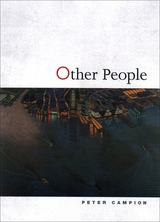 Other People
Peter Campion
University of Chicago Press, 2005 Poem to Fire
Fast transparency that explodes the fuel and air
in the cylinder and shuts the intake valves and thrusts
down on the piston so the crankshaft spins and spins
you cut through all material that blocks your way
so fast that driving now past rushes and billboards
this pull to her could be your own impersonal presence
cloaked in the day to day of the malls and condos
all those wired sensors keeping on guard for you
except you flicker even inside the wet wall
where papillary muscle makes that sweet pulsation
in whatever room she's moving through this moment
under the cotton and the cool smoothness tinted blue
In this debut collection, Peter Campion explores both the gaps and the connections between the self and others. Like the "night blooming jasmine leaving its warm trace," these poems arise out of the dark. A man awakens in a hotel room to find the neighboring voices merging with the anguished souls of his nightmare. A woman living alone beside the ocean hears the words of the dead echo in the crashing waves. But if these poems convey a feeling of an enduring emptiness, they also offer us the most vital intimacies. In one poem, two lovers traverse the industrial sweep of strip malls and office towers to arrive at their rendezvous. In another, the seemingly simple memory of a mother playing with her sons at a park bridges a chasm of pain and loss.
With great poise, keen insight, and formal skill, Campion moves between shared experience and interior life in the shifting textures of Other People. Whether writing in rhymed couplets or free verse, he matches a deep understanding of the poetic tradition with his own imaginative feel for structure.
"The 'other people' of the title of this extraordinary book are fully alive in the life of its language; and so is the poet observing them, and observing himself, as one of them. The book is a sympathetic and unsentimental instrument of truth."—David Ferry
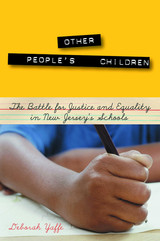 Other People's Children: The Battle for Justice and Equality in New Jersey's Schools
Yaffe, Deborah
Rutgers University Press, 2007 Winner of the 2008 NJ Studies Academic Alliance author's award for an outstanding non-fiction work about New Jersey
In 1981, when Raymond Abbott was a twelve-year-old sixth-grader in Camden, New Jersey, poor city school districts like his spent 25 percent less per student than the state’s wealthy suburbs did. That year, Abbott became the lead plaintiff in a landmark class-action lawsuit demanding that the state provide equal funding for rich and poor schools. Over the next twenty-five years, as the non-profit law firm representing the plaintiffs won ruling after ruling from the New Jersey Supreme Court, Abbott dropped out of school, fought a cocaine addiction, and spent time in prison before turning his life around. Raymond Abbott’s is just one of the many human stories that have too often been forgotten in the policy battles New Jersey has waged for two generations over equal funding for rich and poor schools. Other People’s Children, the first book to tell the story of this decades-long school funding battle, interweaves the public story—an account of legal and political wrangling over laws and money—with the private stories of the inner-city children who were named plaintiffs in the state’s two school funding lawsuits, Robinson v. Cahill and Abbott v. Burke. Although these cases have shaped New Jersey’s fiscal and political landscape since the 1970s, most recently in legislative arguments over tax reform, the debate has often been too abstract and technical for most citizens to understand. Written in an accessible style and based on dozens of interviews with lawyers, politicians, and the plaintiffs themselves, Other People’s Children crystallizes the arguments and clarifies the issues for general readers. Beyond its implications for New Jersey, this book is an important contribution to the conversations taking place in all states about the nation’s responsibility for its poor, and the role of public schools in providing equal opportunities and promising upward mobility for hard-working citizens, regardless of race or class.
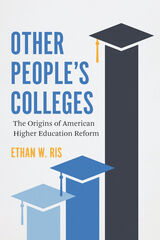 Other People's Colleges: The Origins of American Higher Education Reform
Ethan W. Ris
University of Chicago Press, 2022 An illuminating history of the reform agenda in higher education.
For well over one hundred years, people have been attempting to make American colleges and universities more efficient and more accountable. Indeed, Ethan Ris argues in Other People’s Colleges, the reform impulse is baked into American higher education, the result of generations of elite reformers who have called for sweeping changes in the sector and raised existential questions about its sustainability. When that reform is beneficial, offering major rewards for minor changes, colleges and universities know how to assimilate it. When it is hostile, attacking autonomy or values, they know how to resist it. The result is a sector that has learned to accept top-down reform as part of its existence.
In the early twentieth century, the “academic engineers,” a cadre of elite, external reformers from foundations, businesses, and government, worked to reshape and reorganize the vast base of the higher education pyramid. Their reform efforts were largely directed at the lower tiers of higher education, but those efforts fell short, despite the wealth and power of their backers, leaving a legacy of successful resistance that affects every college and university in the United States. Today, another coalition of business leaders, philanthropists, and politicians is again demanding efficiency, accountability, and utility from American higher education. But, as Ris argues, top-down design is not destiny. Drawing on extensive and original archival research, Other People’s Colleges offers an account of higher education that sheds light on today’s reform agenda.
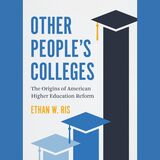 Other People's Colleges: The Origins of American Higher Education Reform
Ethan W. Ris
University of Chicago Press, 2022 This is an auto-narrated audiobook edition of this book. An illuminating history of the reform agenda in higher education.
For well over one hundred years, people have been attempting to make American colleges and universities more efficient and more accountable. Indeed, Ethan Ris argues in Other People’s Colleges, the reform impulse is baked into American higher education, the result of generations of elite reformers who have called for sweeping changes in the sector and raised existential questions about its sustainability. When that reform is beneficial, offering major rewards for minor changes, colleges and universities know how to assimilate it. When it is hostile, attacking autonomy or values, they know how to resist it. The result is a sector that has learned to accept top-down reform as part of its existence.
In the early twentieth century, the “academic engineers,” a cadre of elite, external reformers from foundations, businesses, and government, worked to reshape and reorganize the vast base of the higher education pyramid. Their reform efforts were largely directed at the lower tiers of higher education, but those efforts fell short, despite the wealth and power of their backers, leaving a legacy of successful resistance that affects every college and university in the United States. Today, another coalition of business leaders, philanthropists, and politicians is again demanding efficiency, accountability, and utility from American higher education. But, as Ris argues, top-down design is not destiny. Drawing on extensive and original archival research, Other People’s Colleges offers an account of higher education that sheds light on today’s reform agenda.
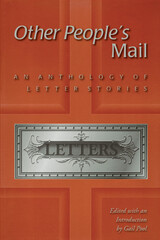 Other People's Mail: An Anthology of Letter Stories
Edited & Intro by Gail Pool
University of Missouri Press, 2000
While the art and craft of letter writing have declined in this century, letter stories have thrived. Cast as love letters and Dear John letters, as thank-you notes and suicide notes, as memos, letters to the editor, and exchanges with the United States Post Office, examples of epistolary fiction have been published by the hundreds, among them the work of many of our most notable authors. Why has this form of fiction writing remained so popular? As Gail Pool answers, "Who, after all, is immune to the seduction of reading other people's mail?"
Although epistolary fiction enjoyed its greatest popularity in the eighteenth and nineteenth centuries, a time when letters were central to daily life, this style of writing has a decidedly postmodern air. Letter stories are about communication, and they are effective in framing our modern concerns: the struggle to find meaningful stories, relationships, and lives amid the social and moral disarray of the era and the blurred boundaries between fact and fiction, artist and audience, private and public domains. These are the themes of our time, and the themes of the stories in Other People's Mail.
Offering seventeen stories written by a culturally diverse group of authors, Other People's Mail represents what letter tales, at their best, can do. They may be written from the Canadian wilderness, a private school in Geneva, a concentration camp, or beyond the grave. They may be comic or satirical, poignant or tragic, but all are united in their distinctive format.
The first collection of its kind, Other People's Mail is a unique and important anthology. Pool's highly informative introduction explores the nature of letter fiction, and her individual preface to each story provides background information on both the author and the tale. A select listing additional letter stories rounds out the anthology. Literature and writing instructors in search of a fresh approach to stories and readers looking for an anthology with a lively theme will enjoy this collection.
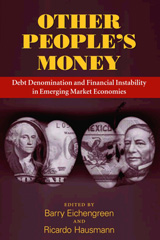 Other People's Money: Debt Denomination and Financial Instability in Emerging Market Economies
Edited by Barry Eichengreen and Ricardo Hausmann
University of Chicago Press, 2005 Recent crises in emerging markets have been heavily driven by balance-sheet or net-worth effects. Episodes in countries as far-flung as Indonesia and Argentina have shown that exchange rate adjustments that would normally help to restore balance can be destabilizing, even catastrophic, for countries whose debts are denominated in foreign currencies. Many economists instinctually assume that developing countries allow their foreign debts to be denominated in dollars, yen, or euros because they simply don't know better.
Presenting evidence that even emerging markets with strong policies and institutions experience this problem, Other People's Money recognizes that the situation must be attributed to more than ignorance. Instead, the contributors suggest that the problem is linked to the operation of international financial markets, which prevent countries from borrowing in their own currencies. A comprehensive analysis of the sources of this problem and its consequences, Other People's Money takes the study one step further, proposing a solution that would involve having the World Bank and regional development banks themselves borrow and lend in emerging market currencies.
Other Peoples' Myths: The Cave of Echoes
Wendy Doniger O'Flaherty
University of Chicago Press, 1995 Other People's Myths celebrates the universal art of storytelling, and the rich diversity of stories that people live by. Drawing on Biblical parables, Greek myths, Hindu epics, and the modern mythologies of Woody Allen and soap operas, Wendy Doniger O'Flaherty encourages us to feel anew the force of myth and tradition in our lives, and in the lives of other cultures. She shows how the stories of mythology—whether of Greek gods, Chinese sages, or Polish rabbis—enable all cultures to define themselves. She raises critical questions about the way we interpret mythical stories, especially the way different cultures make use of central texts and traditions. And she offers a sophisticated way of looking at the roles myths play in all cultures.
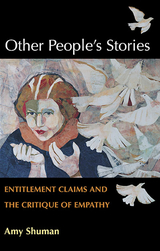 Other People's Stories: Entitlement Claims and the Critique of Empathy
Amy Shuman
University of Illinois Press, 2010 In Other People's Stories, Amy Shuman examines the social relations embedded in stories and the complex ethical and social tensions that surround their telling. Drawing on innovative research and contemporary theory, she describes what happens when one person's story becomes another person's source of inspiration, or when entitlement and empathy collide. The resulting analyses are wonderfully diverse, integrating narrative studies, sociolinguistics, communications, folklore, and ethnographic studies to examine the everyday, conversational stories told by cultural groups including Latinas, Jews, African Americans, Italians, and Puerto Ricans. Shuman offers a nuanced and clear theoretical perspective derived from the Frankfurt school, life history research, disability research, feminist studies, trauma studies, and cultural studies. Without compromising complexity, she makes narrative inquiry accessible to a broad population.
Other People's Troubles
Jason Sommer
University of Chicago Press, 1997 Son of a Holocaust survivor, Jason Sommer writes of troubles that unfold at the intersection of history made and personality in making, of self and other, of wakefulness and sleep. His world is post-Holocaust, and the poetic voice in this book is one which emerges from that calamity, telling the stories of those who have finally begun to speak to him, and now through him. As a survivor's child, Sommer must consider how to live in the wake of history, among those who are indelibly marked by it.
 Other People's Wars: The US Military and the Challenge of Learning from Foreign Conflicts
Brent L. Sterling
Georgetown University Press, 2023 Case studies explore how to improve military adaptation and preparedness in peacetime by investigating foreign wars Preparing for the next war at an unknown date against an undetermined opponent is a difficult undertaking with extremely high stakes. Even the most detailed exercises and wargames do not truly simulate combat and the fog of war. Thus, outside of their own combat, militaries have studied foreign wars as a valuable source of battlefield information. The effectiveness of this learning process, however, has rarely been evaluated across different periods and contexts. Through a series of in-depth case studies of the US Army, Navy, and Air Force, Brent L. Sterling creates a better understanding of the dynamics of learning from “other people’s wars,” determining what types of knowledge can be gained from foreign wars, identifying common pitfalls, and proposing solutions to maximize the benefits for doctrine, organization, training, and equipment. Other People’s Wars explores major US efforts involving direct observation missions and post-conflict investigations at key junctures for the US armed forces: the Crimean War (1854–56), Russo-Japanese War (1904–5), Spanish Civil War (1936–39), and Yom Kippur War (1973), which preceded the US Civil War, First and Second World Wars, and major army and air force reforms of the 1970s, respectively. The case studies identify learning pitfalls but also show that initiatives to learn from other nations’ wars can yield significant benefits if the right conditions are met. Sterling puts forth a process that emphasizes comprehensive qualitative learning to foster better military preparedness and adaptability.
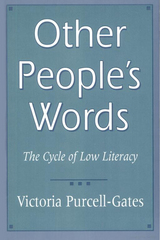 Other People’s Words: The Cycle of Low Literacy
Victoria Purcell-Gates
Harvard University Press, 1995 If asked to identify which children rank lowest in relation to national educational norms, have higher school dropout and absence rates, and more commonly experience learning problems, few of us would know the answer: white, urban Appalachian children. These are the children and grandchildren of Appalachian families who migrated to northern cities in the 1950s to look for work. They make up this largely “invisible” urban group, a minority that represents a significant portion of the urban poor. Literacy researchers have rarely studied urban Appalachians, yet, as Victoria Purcell-Gates demonstrates in Other People’s Words, their often severe literacy problems provide a unique perspective on literacy and the relationship between print and culture.
A compelling case study details the author’s work with one such family. The parents, who attended school off and on through the seventh grade, are unable to use public transportation, shop easily, or understand the homework their elementary-school-age son brings home because neither of them can read. But the family is not so much illiterate as low literate—the world they inhabit is an oral one, their heritage one where print had no inherent use and no inherent meaning. They have as much to learn about the culture of literacy as about written language itself.
Purcell-Gates shows how access to literacy has been blocked by a confluence of factors: negative cultural stereotypes, cultural and linguistic elitism, and pedagogical obtuseness. She calls for the recruitment and training of “proactive” teachers who can assess and encourage children’s progress and outlines specific intervention strategies.
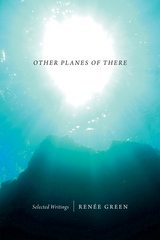 Other Planes of There: Selected Writings
Renée Green
Duke University Press, 2014 For more than two decades, the artist Renée Green has created an impressive body of work in which language is an essential element. Green is also a prolific writer and a major voice in the international art world. Other Planes of There gathers for the first time a substantial collection of the work she wrote between 1981 and 2010. The selected essays initially appeared in publications in different countries and languages, making their availability in this volume a boon to those wanting to follow Green's artistic and intellectual trajectory.
Charting this cosmopolitan artist’s thinking through the decades, Other Planes of There brings essays, film scripts, reviews, and polemics together with reflections on Green's own artistic practice and seminal artworks. It immerses the reader in three decades of contemporary art showcasing the art and thought, the incisive critiques and prescient observations of one of our foremost artists and intellectuals. Sound, cinema, literature, time-based media, and the relationship between art forms and other forms of knowledge are just a few of the matters that Green takes up and thinks through. Sixty-four pages of color plates were selected by the artist for this lavishly illustrated volume.
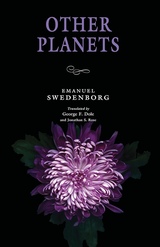 Other Planets
Emanuel Swedenborg
Swedenborg Foundation Publishers, 2018 In Other Planets, Emanuel Swedenborg offers us a panorama of a unified and purposeful universe based on his visionary journeys through the unimaginably vast reaches of the spiritual world.
Cast in the form of a travelogue, Swedenborg describes having contact with the spirits of people who had lived on Mercury, Jupiter, and other planets and satellites in our solar system and beyond. This may present a challenge for those who interpret it literally, but just as it is with other of Swedenborg’s “memorable occurrences” in the spiritual world, the goal is to consider and explore the deeper insights that he reveals regarding the universal principles that unite the human with the Divine. The discussions of faith in Other Planets are framed by Swedenborg’s own Christian beliefs; however, a key takeaway for readers will certainly be the feeling that there are multiple ways of approaching belief and religious practice that can all lead to heaven.
Also published under the titles Earths in the Universe, The Worlds in Space, and Life on Other Planets, this work provides seasoned students of Swedenborg with a renewed take on the fundamentals of his theology. At the same time, this short piece opens a window onto how the people of the eighteenth century sought to integrate science and religion in ways that are still relevant and meaningful today.
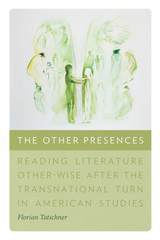 The Other Presences: Reading Literature Other-Wise after the Transnational Turn in American Studies
Florian Tatschner
Dartmouth College Press, 2019 Florian Tatschner examines an alternative mode of reading fictional texts in the context of North American literature through “reading other-wise”: a mode of reading that regards the other in narratives not merely as a discursive construct of alterity, but as a presencing of otherness that resists discursive fixity. Waldenfels’s phenomenology constitutes the foundational approach of this work, and Lyotard’s poststructuralist philosophy of language, with its distinction between discursivity and figurality, offers a suitable framework for negotiating the relation between otherness and alterity. Drawing on the increasingly significant term “presence” in connection with phenomenon of otherness, Tatschner attempts to close a scholarly gap in the discourse on aesthetics regarding cultural difference as well as the relation between presence and aesthetics in American studies.
The Other Prophet: Jesus in the Qur’an
Mouhanad Khorchide and Klaus von Stosch
Gingko, 2025 Unique study of Jesus in the Qur’an by a Christian and a Muslim scholar writing together.
The Qur’an identifies Jesus as a sign of God, and he holds a place as one of the most important prophets in Islam. Looking at Jesus in Islam also reveals both deep differences from and rich connections to the view of Jesus in Christianity. In The Other Prophet, Mouhanad Khorchide and Klaus von Stosch explore and explain the position of the Qur’anic Jesus, with one scholar working from the Muslim and the other from the Christian theological perspective. Their combined research presents a history of Jesus’ presence in the Qur’an and provides astute observations to deepen the understanding of both Christians and Muslims. Here we find that a common view of Jesus from the Muslim and Christian sides is not only possible but also expands our understanding of Jesus and his message.
Other Psalms
Jordan Windholz
University of North Texas Press, 2015
 The Other Public Lands: Preservation, Extraction, and Politics on the Fifty States' Natural Resource Lands
Steven Davis
Temple University Press, 2025 For most Americans, state lands are the most readily accessible type of public land; however, despite their ubiquity, they remain largely terra incognita. The Other Public Lands is a primer on state public lands and the political dynamics that underlie their management. Offering a wide-angle overview, Steven Davis focuses on how states prioritize competing claims related to conservation, resource development, tourism, recreation, and finances.
The Other Public Lands looks at both differences and common patterns in state land management, including the structure of natural resource agencies. Davis examines the privatization and commercialization of state parks, and the tensions between recreation, revenue and the preservation of biodiversity and natural landscapes. He also raises issues about equity, access, appropriate development, and ecological health. Chapters review state forests, state wildlife management areas, and school trust lands. In addition, the roles of interest groups, the courts, and agency culture and behavior are compared and analyzed both between states and the federal government and between states with differing approaches to specific issues.
As there has been a demand to transfer at least some federal lands to the states, The Other Public Lands concludes with an appraisal of whether states could handle this transfer and goes on to suggest ways to ensure adequate access in an era of increased demand.
The Other Quiet Professionals: Lessons for Future Cyber Forces from the Evolution of Special Forces
Christopher Paul
RAND Corporation, 2014 With the establishment of U.S. Cyber Command, the cyber force is gaining visibility and authority, but challenges remain, particularly in the areas of acquisition and personnel recruitment and career progression. A review of commonalities, similarities, and differences between the still-nascent U.S. cyber force and early U.S. special operations forces, conducted in 2010, offers salient lessons for the future direction of U.S. cyber forces.
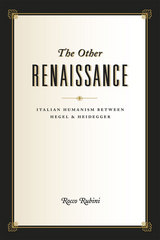 The Other Renaissance: Italian Humanism between Hegel and Heidegger
Rocco Rubini
University of Chicago Press, 2014 A natural heir of the Renaissance and once tightly conjoined to its study, continental philosophy broke from Renaissance studies around the time of World War II. In The Other Renaissance, Rocco Rubini achieves what many have attempted to do since: bring them back together. Telling the story of modern Italian philosophy through the lens of Renaissance scholarship, he recovers a strand of philosophic history that sought to reactivate the humanist ideals of the Renaissance, even as philosophy elsewhere progressed toward decidedly antihumanist sentiments.
Bookended by Giambattista Vico and Antonio Gramsci, this strand of Renaissance-influenced philosophy rose in reaction to the major revolutions of the time in Italy, such as national unity, fascism, and democracy. Exploring the ways its thinkers critically assimilated the thought of their northern counterparts, Rubini uncovers new possibilities in our intellectual history: that antihumanism could have been forestalled, and that our postmodern condition could have been entirely different. In doing so, he offers an important new way of thinking about the origins of modernity, one that renews a trust in human dignity and the Western legacy as a whole.
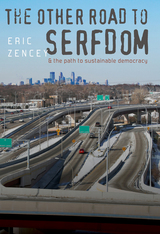 The Other Road to Serfdom and the Path to Sustainable Democracy
Eric Zencey
University Press of New England, 2012 Our planet is finite. Our political and economic systems were designed for an infinite planet. These difficult truths anchor the perceptive analysis offered in The Other Road to Serfdom and the Path to Sustainable Democracy. With wit, energy, and a lucid prose style, Eric Zencey identifies the key elements of “infinite planet” thinking that underlie our economics and our politics—and shows how they must change. Zencey’s title evokes F. A. Hayek, who argued that any attempt to set overall limits to free markets—any attempt at centralized planning—is “the road to serfdom.” But Hayek’s argument works only if the planet is infinite. If Hayek is right that planning and democracy are irreducibly in conflict, Zencey argues, then on a finite planet, “free markets operated on infinite planet principles are just the other road to serfdom.” The alternative is ecological economics, an emergent field that accepts limits to what humans can accomplish economically on a finite planet. Zencey explains this new school of thought and applies it to current political and economic concerns: the financial collapse, terrorism, population growth, hunger, the energy and oil industry’s social control, and the deeply rooted dissatisfactions felt by conservative “values” voters who have been encouraged to see smaller government and freer markets as the universal antidote. What emerges is a coherent vision, a progressive and hopeful alternative to neoconservative economic and political theory—a foundation for an economy that meets the needs of the 99% and just might help save civilization from ecological and political collapse.
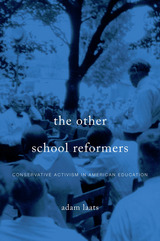 The Other School Reformers: Conservative Activism in American Education
Adam Laats
Harvard University Press, 2015 The idea that American education has been steered by progressive values is celebrated by liberals and deplored by conservatives, but both sides accept it as fact. Adam Laats shows that this widely held belief is simply wrong. Upending the standard narrative of American education as the product of courageous progressive reformers, he calls to center stage the conservative activists who decisively shaped America’s classrooms in the twentieth century. The Other School Reformers makes clear that, in the long march of American public education, progressive reform has more often been a beleaguered dream than an insuperable force.
Laats takes an in-depth look at four landmark school battles: the 1925 Scopes Trial, the 1939 Rugg textbook controversy, the 1950 ouster of Pasadena Public Schools Superintendent Willard Goslin, and the 1974 Kanawha County school boycott. Focused on issues ranging from evolution to the role of religion in education to the correct interpretation of American history, these four highly publicized controversies forced conservatives to articulate their vision of public schooling—a vision that would keep traditional Protestant beliefs in America’s classrooms and push out subversive subjects like Darwinism, socialism, multiculturalism, and feminism. As Laats makes clear in case after case, activists such as Hiram Evans and Norma Gabler, Homer Chaillaux and Louise Padelford were fiercely committed to a view of the curriculum that inculcated love of country, reinforced traditional gender roles and family structures, allowed no alternatives to capitalism, and granted religion a central role in civic life.
 "Other Sheep I Have" The Autobiography of Father Paul M. Washington
Paul Washington
Temple University Press, 1994 Father Paul M. Washington rose to local and nation prominence as an unflagging supporter of civil and women's rights. One of a handful of black priests in a traditionally white church, he fought for understanding among all people, eventually serving twenty-five years as the Rector of the Episcopal Church of the Advocate in an inner-city Philadelphia neighborhood. Though his ideas about equality often went against the views of the Episcopal church leadership, he rejected threats of withdrawn funding or retaliation to follow his heart and his theology. Father Washington's story is a window of insight into the struggles for justice and dignity in the latter half of the twentieth century. In the tumultuous 1960s he supported the Black Power movement, the Black Panther Party, and many other groups working for peace and justice, providing meeting places and guidance. He often found himself in the midst of racial disturbances—the riots on Susquehanna Avenue in 1963 and on Columbia Avenue in 1964, in front of the Board of Education where high school students protested the Eurocentric curriculum, and outside the walls of Girard College where citizens and civic leaders demonstrated against the school's exclusion of black children. In the 1980s, he helped Philadelphia city officials negotiate with MOVE members and was a vocal supporter of Ramona Africa, fighting for her release from prison. It was in his church on the corner of 18th and Diamond Streets that women were first ordained a priests in the Episcopal church. And it was one of his congregation, Barbara Harris, who became the first female Episcopal bishop. In his evocative voice, Father Washington describes the pivotal events of his life and how each impacted upon his evolving ideas of the relationship between religion and justice. Spanning seven decades, his account is at once an insightful and unique historical account of political action, of the reformation of the church, of the changing urban landscape, and of a life graced by leadership and spiritual enlightenment.
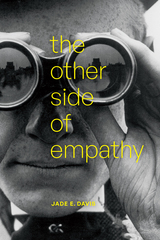 The Other Side of Empathy
Jade E. Davis
Duke University Press, 2023 In The Other Side of Empathy, Jade E. Davis contests the value of empathy as an affective or critical tool. Whether focusing on technology, colonialism, or racism, she shows how empathy can obscure relationships of dominance, control, submission, and victimization, arguing that these histories taint the whole concept of empathy. Drawing on digital archives of photographs, memoirs, newspapers, interviews, and advertisements regarding nineteenth-century ethnographic museums and human zoos, Davis shows how empathetic responses erase culpabilities from those institutions that commodify difference. She also contends that empathy’s mediation through digital technology cannot lead to more ethical actions, as technology only connects representations of people rather than the people themselves. In empathy’s place, Davis proposes mutual recognition as a way to see and experience others beyond colonial modes of empathy. Davis illustrates that moving beyond empathy allows for a more nuanced understanding of the colonial past and its ongoing impact while providing for a more meaningful affective engagement with the world.
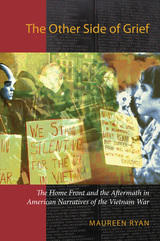 The Other Side of Grief: The Home Front and the Aftermath in American Narratives of the Vietnam War
Maureen Ryan
University of Massachusetts Press, 2008 The lingering aftereffects of the Vietnam War resonate to this day throughout American society: in foreign policy, in attitudes about the military and war generally, and in the contemporary lives of members of the so-called baby boom generation who came of age during the 1960s and early 1970s. While the best-known personal accounts of the war tend to center on the experience of combat, Maureen Ryan's The Other Side of Grief examines the often overlooked narratives—novels, short stories, memoirs, and films—that document the war's impact on the home front.
In analyzing the accounts of Vietnam veterans, women as well as men, Ryan focuses on the process of readjustment, on how the war continued to insinuate itself into their lives, their families, and their communities long after they returned home. She looks at the writings of women whose husbands, lovers, brothers, and sons served in Vietnam and whose own lives were transformed as a result. She also appraises the experiences of the POWs who came to be embraced as the war's only heroes; the ordeal of Vietnamese refugees who fled their "American War" to new lives in the United States; and the influential movement created by those who committed themselves to protesting the war.
The end result of Ryan's investigations is a cogent synthesis of the vast narrative literature generated by the Vietnam War and its aftermath. Together those stories powerfully demonstrate how deeply the legacies of the war penetrated American culture and continue to reverberate still.
The Other Side of Heaven: Post-War Fiction by Vietnamese and American Writers
Edited by Wayne Karlin, Le Minh Khue, and Truong Vu
Northwestern University Press, 1995 These stories represent the "second wave" of fiction—works about the aftermath of the Vietnam conflict as it moved into both countries, touching and forever changing not only the veterans, but also their families and their societies. Contributors include John Edgar Wideman, Larry Brown, Robert Olen Butler, Philip Caputo, Bobbie Ann Mason, Ngo Tu Lap, Tim O'Brien, and others.
The Other Side of Silence: Sign Language and the Deaf Community in America
Arden Neisser
Gallaudet University Press, 1983 Arden Neisser’s classic book on American Sign Language (ASL) and the Deaf community is again available, with a new prologue. The Other Side of Silence explores the Deaf community through telling interviews and research from across the country. In widely varying encounters, Neisser heard Deaf individuals recall how their teachers suppressed ASL, how linguists foster conflicting theories, and how various institutions of the deaf dilute ASL to suit hearing patrons. This seminal book reveals the warmth, creativity, and resilience of Deaf people, and offers an update of the community today.
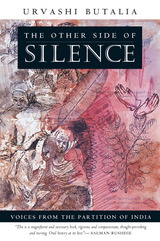 The Other Side of Silence: Voices from the Partition of India
Urvashi Butalia
Duke University Press, 2000 The partition of India into two countries, India and Pakistan, caused one of the most massive human convulsions in history. Within the space of two months in 1947 more than twelve million people were displaced. A million died. More than seventy-five thousand women were abducted and raped. Countless children disappeared. Homes, villages, communities, families, and relationships were destroyed. Yet, more than half a century later, little is known of the human dimensions of this event. In The Other Side of Silence , Urvashi Butalia fills this gap by placing people—their individual experiences, their private pain—at the center of this epochal event.
Through interviews conducted over a ten-year period and an examination of diaries, letters, memoirs, and parliamentary documents, Butalia asks how people on the margins of history—children, women, ordinary people, the lower castes, the untouchables—have been affected by this upheaval. To understand how and why certain events become shrouded in silence, she traces facets of her own poignant and partition-scarred family history before investigating the stories of other people and their experiences of the effects of this violent disruption. Those whom she interviews reveal that, at least in private, the voices of partition have not been stilled and the bitterness remains. Throughout, Butalia reflects on difficult questions: what did community, caste, and gender have to do with the violence that accompanied partition? What was partition meant to achieve and what did it actually achieve? How, through unspeakable horrors, did the survivors go on? Believing that only by remembering and telling their stories can those affected begin the process of healing and forgetting, Butalia presents a sensitive and moving account of her quest to hear the painful truth behind the silence.
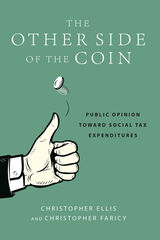 The Other Side of the Coin: Public Opinion toward Social Tax Expenditures
Christopher G. Faricy
Russell Sage Foundation, 2021 Despite high levels of inequality and wage stagnation over several decades, the United States has done relatively little to address these problems—at least in part due to public opinion, which remains highly influential in determining the size and scope of social welfare programs that provide direct benefits to retirees, unemployed workers or poor families. On the other hand, social tax expenditures—or tax subsidies that help citizens pay for expenses such as health insurance or the cost of college and invest in retirement plans—have been widely and successfully implemented, and they now comprise nearly 40 percent of the spending of the American social welfare state. In The Other Side of the Coin, political scientists Christopher Ellis and Christopher Faricy examine public opinion towards social tax expenditures—the other side of the American social welfare state—and their potential to expand support for such social investment.
Tax expenditures seek to accomplish many of the goals of direct government expenditures, but they distribute money indirectly, through tax refunds or reductions in taxable income, rather than direct payments on goods and services or benefits. They tend to privilege market-based solutions to social problems such as employer-based tax subsidies for purchasing health insurance versus government-provided health insurance. Drawing on nationally representative surveys and survey experiments, Ellis and Faricy show that social welfare policies designed as tax expenditures, as opposed to direct spending on social welfare programs, are widely popular with the general public. Contrary to previous research suggesting that recipients of these subsidies are often unaware of indirect government aid—sometimes called “the hidden welfare state”—Ellis and Faricy find that citizens are well aware of them and act in their economic self-interest in supporting tax breaks for social welfare purposes. The authors find that many people view the beneficiaries of social tax expenditures to be more deserving of government aid than recipients of direct public social programs, indicating that how government benefits are delivered affects people’s views of recipients’ worthiness. Importantly, tax expenditures are more likely to appeal to citizens with anti-government attitudes, low levels of trust in government, or racial prejudices. As a result, social spending conducted through the tax code is likely to be far more popular than direct government spending on public programs that have the same goals.
The first empirical examination of the broad popularity of tax expenditures, The Other Side of the Coin provides compelling insights into constructing a politically feasible—and potentially bipartisan—way to expand the scope of the American welfare state.
 The Other Side of the Digital: The Sacrificial Economy of New Media
Andrea Righi
University of Minnesota Press, 2021 A necessary, rich new examination of how the wired world affects our humanity
Our tech-fueled economy is often touted as a boon for the development of our fullest human potential. But as our interactions are increasingly turned into mountains of data sifted by algorithms, what impact does this infinite accumulation and circulation of information really have on us? What are the hidden mechanisms that drive our continuous engagement with the digital? In The Other Side of the Digital, Andrea Righi argues that the Other of the digital acts as a new secular God, exerting its power through endless accountability that forces us to sacrifice ourselves for the digital. Righi deconstructs the contradictions inherent in our digital world, examining how ideas of knowledge, desire, writing, temporality, and the woman are being reconfigured by our sacrificial economy. His analyses include how both our self-image and our perception of reality are skewed by technologies like fitness bands, matchmaking apps, and search engines, among others. The Other Side of the Digital provides a necessary, in-depth cultural analysis of how the political theology of the new media functions under neoliberalism. Drawing on the work of well-known thinkers like Jacques Derrida, Jacques Lacan, and Ludwig Wittgenstein, as well as Carla Lonzi, Luisa Muraro, and Luciano Parinetto, Righi creates novel appraisals of popular digital tools that we now use routinely to process life experiences. Asking why we must sign up for this sort of regime, The Other Side of the Digital is an important wake-up call to a world deeply entangled with the digital.
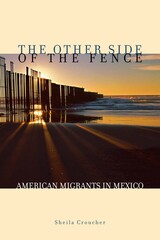 The Other Side of the Fence: American Migrants in Mexico
By Sheila Croucher
University of Texas Press, 2009 A growing number of Americans, many of them retirees, are migrating to Mexico's beach resorts, border towns, and picturesque heartland. While considerable attention has been paid to Mexicans who immigrate to the U.S., the reverse scenario receives little scrutiny. Shifting the traditional lens of North American migration, The Other Side of the Fence takes a fascinating look at a demographic trend that presents significant implications for the United States and Mexico. The first in-depth account of this trend, Sheila Croucher's study describes the cultural, economic, and political lives of these migrants of privilege. Focusing primarily on two towns, San Miguel de Allende in the mountains and Ajijic along the shores of Lake Chapala, Croucher depicts the surprising similarities between immigrant populations on both sides of the border. Few Americans living in Mexico are fluent in the language of their new land, and most continue to practice the culture and celebrate the national holidays of their homeland, maintaining close political, economic, and social ties to the United States while making political demands on Mexico, where they reside. Accessible, timely, and brimming with eye-opening, often ironic, findings, The Other Side of the Fence brings an important perspective to borderlands debates.
 The Other Side of the Popular: Neoliberalism and Subalternity in Latin America
Gareth Williams
Duke University Press, 2002 Drawing on deconstruction, postcolonial theory, cultural studies, and subaltern studies, The Other Side of the Popular is as much a reflection on the limitations and possibilities for thinking about the politics of Latin American culture as it is a study of the culture itself. Gareth Williams pays particular attention to the close relationship between complex cultural shifts and the development of the neoliberal nation-state. The modern Latin American nation, he argues, was built upon the idea of "the people," a citizenry with common interests transcending demographic and cultural differences. As nations have weakened in relation to the global economy, this moment—of the popular as the basis of nation-building—has passed, causing seismic shifts in the relationships between governments and cultural formations. Williams asserts that these changed relationships necessitate the rethinking of fundamental concepts such as "the popular" and "the nation." He maintains that the perspective of subalternity is vital to this theoretical project because it demands the reimagining of the connections between critical reason and its objects of analysis. Williams develops his argument through studies of events highlighting Latin America’s uneasy, and often violent, transition to late capitalism over the past thirty years. He looks at the Chiapas rebellion in Mexico, genocide in El Salvador, the Sendero in Peru, Chile’s and Argentina’s transitions to democratic governments, and Latin Americans’ migration northward. Williams also reads film, photography, and literary works, including Ricardo Piglia’s The Absent City and the statements of a young Salvadoran woman, the daughter of ex-guerrilleros, living in South Central Los Angeles. The Other Side of the Popular is an incisive interpretation of Latin American culture and politics over the last few decades as well as a thoughtful meditation on the state of Latin American cultural studies.
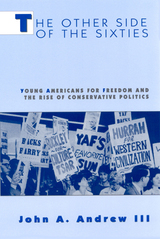 The Other Side of the Sixties: Young Americans for Freedom and the Rise of Conservative Politics
Andrew III, John A
Rutgers University Press, 1997 What were young conservatives doing in the 1960s while SDS and SNCC were working to move the political center to the left? The Other Side of the Sixties offers a gripping account of Young Americans for Freedom (YAF), an organization that became a leading force in promoting conservative ideas and that helped lay the groundwork for today's conservatism. John Andrew has mined unique archival material to document YAF's efforts to form a viable organization, define a new conservatism, attack the liberal establishment, and seize control of the Republican party, all while battling voter hostility and internal factionalism. The author also uncovers the Kennedy administration's use of the IRS to subvert YAF and other right-wing organizations through tax audits and investigations. By painting a more balanced portrait of political thinking in the sixties, Andrew offers a new and much needed look at the ideological atmosphere of a vibrant decade.
 Other Sisterhoods: LITERARY THEORY AND U.S. WOMEN OF COLOR
Edited by Sandra Kumamoto Stanley
University of Illinois Press, 1998 Where are the women writers of color? Where are their theoretical voices?
The fifteen contributors to Other Sisterhoods: Literary Theory and
U.S. Women of Color examine the ways that women writers of color have
contributed to the discourse of literary and cultural theory. They focus
on the impact of key issues, such as social construction and identity
politics, on the works of women writers of color, as well as on the ways
these women deal with differences relating to gender, class, race/ethnicity,
and sexuality. The book also explores the ways women writers of color
have created their own ethnopoetics within the arena of literary and cultural
theory, helping to redefine the nature of theory itself.
"A sophisticated resource that will do much to carry us through
to the next century. Great work!" -- Alvina E. Quintana, author of
Home Girls: Chicana Literary Voices
CONTRIBUTORS:Sandra Kumamoto Stanley, AnaLouise Keating, Dionne
Espinoza, Kimberly N. Brown, Marilyn Edelstein, Tomo Hattori, Robin Riley
Fast, King-Kok Cheung, Timothy Libretti, Renae Moore Bredin, Jennifer
Browdy de Hernandez, Kimberly M. Blaeser, Kathryn Bond Stockton, Eun Kyung
Min, Cecilia Rodriguez Milanes
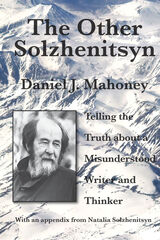 The Other Solzhenitsyn: Telling the Truth about a Misunderstood Writer and Thinker
Daniel J. Mahoney
St. Augustine's Press, 2014 The great Russian writer Aleksandr Solzhenitsyn (1918–2008) is widely recognized as one of the most consequential human beings of the twentieth century. Through his writings and moral witness, he illumined the nature of totalitarianism and helped bring down an ‘evil empire.’ His courage and tenacity are acknowledged even by his fiercest critics. Yet the world-class novelist, historian, and philosopher (one uses the latter term in its capacious Russian sense) has largely been eclipsed by a caricature that has transformed a measured and self-critical patriot into a ferocious nationalist, a partisan of local self-government into a quasi-authoritarian, a man of faith and reason into a narrow-minded defender of Orthodoxy. The caricature, widely dispensed in the press, and too often taken for granted, gets in the way of a thoughtful and humane confrontation with the “other” Solzhenitsyn, the true Solzhenitsyn, who is a writer and thinker of the first rank and whose spirited defense of liberty is never divorced from moderation. It is to the recovery of this Solzhenitsyn that this book is dedicated.
This book above all explores philosophical, political, and moral themes in Solzhenitsyn’s two masterworks, The Gulag Archipelago and The Red Wheel, as well as in his great European novel In the First Circle. We see Solzhenitsyn as analyst of revolution, defender of the moral law, phenomenologist of ideological despotism, and advocate of “resisting evil with force.” Other chapters carefully explore Solzhenitsyn’s conception of patriotism, his dissection of ideological mendacity, and his controversial, but thoughtful and humane discussion of the “Jewish Question” in the Russian – and Soviet twentieth century. Some of Solzhenitsyn’s later writings, such as the “binary tales” that he wrote in the 1990s, are subject to critically appreciative analysis. And a long final chapter comments on Solzhenitsyn’s July 2007 Der Spiegel interview, his last word to Russia and the West. He is revealed to be a man of faith and freedom, a patriot but not a nationalist, and a principled advocate of self-government for Russia and the West.
A final Appendix reproduces the beautiful Introduction (“The Gift of Incarnation”) that the author’s widow, Natalia Solzhenitsyn, wrote to the 2009 Russian abridgment of The Gulag Archipelago, a work that is now taught in Russian high schools.
Other South: Faulkner, Coloniality, and the Mariátegui Tradition
Hosam Aboul-Ela
University of Pittsburgh Press, 2007 Hosam Aboul-Ela provides a startlingly original perspective on Faulkner, examining his work in the transnational context of the “Global South”: the geopolitical and economic dynamics of the post-Reconstruction period that link the American South to the larger colonial tradition. Other South thus raises new questions as to the scope and attitude of Faulkner's project, positioning Faulkner's work as an inherent critique of colonialism and emphasizing a more specific conceptualization of coloniality.
Engaging with ideas and thinkers from the former colonies, Aboul-Ela draws on an understanding of economics, social structures, and the colonial/neocolonial status of the Third World, stepping outside the preconceptions of current postcolonial studies to offer a fresh perspective on our shared literary heritage and a new look at an iconic literary figure.
An Other Testament: On Typology
Joseph M. Spencer
Neal A. Maxwell Institute for Religious Scholarship, 2016 How should we read the Book of Mormon? And does the Book of Mormon itself have anything to say about it? Joseph Spencer follows the lead of Nephite prophets who interpreted Isaiah and other prophets typologically—according to “types” and “shadows”—in order to preach salvation through Jesus Christ. By focusing on history, memory, time, repentance, and conversion, An Other Testament explores what it means to believe God provided the Book of Mormon to change a person like you and a world like ours.
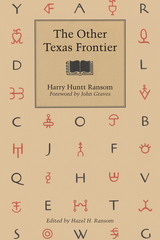 The Other Texas Frontier
By Harry Huntt Ransom; edited by Hazel H. Ransom; foreword by John Graves
University of Texas Press, 1984 “One is tempted to say that wherever there was a frontier in America there was a counterfrontier and that the main purpose of this counterfrontier was not only to help man grow or dig or catch or kill his livng but also to put this man in communication with the traditions of his kind and thereby secure to his descendants the benefits of the free mind.” —Harry Huntt Ransom The reflections of Harry Huntt Ransom (1908–1976) in The Other Texas Frontier present an alternative to the stereotypical picture of the brash, blustery heroes of the Texas frontier. Here, in six highly readable essays, Ransom posits a thesis of the counterfrontier: a quiet settling of the land by thoughtful, undramatic citizens who, he says, were the other Texans—the Texans without guns. Three of the essays are profiles of gifted men from Texas’ nineteenth century: Ashbel Smith, physician, diplomat, and first president of the Board of Regents of the University of Texas; Sherman Goodwin, physician, horticulturalist, bibliophile (and Ransom’s own grandfather); and Swante Palm, Swedish immigrant, bibliographer, and generous patron of the University of Texas libraries. Harry Huntt Ransom, one of Texas’ most accomplished men of letters and for forty-one years an integral part of the University of Texas System as professor, dean, president, and chancellor, leaves an extraordinary legacy to Texas for both his educational and literary service. Though educated out of state, he returned to his native Texas after completion of his PhD at Yale to teach, research, and write in the fields of copyright law, literary history, and bibliography. As founder of the Humanities Research Center, he was squarely in the tradition of the men he was writing about. Compiled and edited after Ransom’s death by his wife, Hazel H. Ransom, the literary sketches of The Other Texas Frontier form a book that Ransom himself had outlined but had not completed.
Other Than They Seem
Allan Peterson
Tupelo Press, 2016 Soft spoken and intuitive, these deeply reflective poems demonstrate the miraculous common currency of thinking, expressed like confidences shared with a reader: “the latent world wavers between us. . . .” Highly visual and verbally chromatic, eschewing punctuation and rigorously open-ended, these poems pursue intimate recognitions in compact forms energized by intuitive jumps.
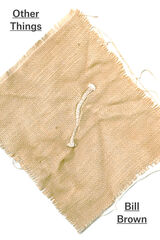 Other Things
Bill Brown
University of Chicago Press, 2015 From the pencil to the puppet to the drone—the humanities and the social sciences continue to ride a wave of interest in material culture and the world of things. How should we understand the force and figure of that wave as it shapes different disciplines? Other Things explores this question by considering a wide assortment of objects—from beach glass to cell phones, sneakers to skyscrapers—that have fascinated a range of writers and artists, including Virginia Woolf, Man Ray, Spike Lee, and Don DeLillo.
The book ranges across the literary, visual, and plastic arts to depict the curious lives of things. Beginning with Achilles’s Shield, then tracking the object/thing distinction as it appears in the work of Martin Heidegger and Jacques Lacan, Bill Brown ultimately focuses on the thingness disclosed by specific literary and artistic works. Combining history and literature, criticism and theory, Other Things provides a new way of understanding the inanimate object world and the place of the human within it, encouraging us to think anew about what we mean by materiality itself.
Other Times, Other Realities: Toward a Theory of Psychoanalytic Treatment
Arnold Modell
Harvard University Press, 1990 Nearly a century has passed since Freud's theories unleashed a revolution in our understanding of the human psyche. Yet, as Arnold Modell firmly points out, we still do not possess a theory that explains how psychoanalysis works. Other Times, Other Realities provides brilliant insight into this perplexing problem and lays the foundation for a comprehensive theory of psychoanalytic treatment. Modell's careful consideration of Freudian theory, the interpretations of contemporary ego psychology, and the contribution of object theory discloses the changing significance of the fundamental elements of the therapeutic process.
In Other Times, Other Realities, readers will discover an illuminating synthesis of concepts underlying the various interpretations of the psychoanalytic process.
The Other Tongue: English Across Cultures
Edited by Braj B. Kachru
University of Illinois Press, 1992 When The Other Tongue appeared in 1982, it was called "required reading for all those concerned with English teaching in non-native situations, from the classroom teacher to the policy planner", Jowhn Platt, English World-Wide) and "an extremely useful and stimulating collection" (William C. Ritchie, Language). It introduced refreshingly new perspectives for understanding the spread and functions of English around the world. This dramatically revised volume contains eight new chapters, replacing or updating more than half of the first edition. The Other Tongue is the first attempt to integrate and address provocative issues relevant to a deeper understanding of the forms and functions of English within different sociolinguistic, cross-cultural, and cross-linguistic contexts. The volume discusses linguistic, literary, pedagogical, and attitudinal issues related to world Englishes.
 An Other Tongue: Nation and Ethnicity in the Linguistic Borderlands
Alfred Arteaga
Duke University Press, 1994 As our millennium draws to a close, we find ourselves in the midst of great and rapid global changes with nations and political systems dissolving all around us and the world becoming one of shifting identities--of peoples unified and divided by such distinctions as nationality, ethnicity, race, religion, and colonial status. The articulation and construction of these distinctions, the very language of difference, is the subject of An Other Tongue. This collection of essays by a group of distinguished scholars, including Norma Alarcón, Gayatri Spivak, Tzvetan Todorov, and Gerald Vizenor, explores the interconnections between language and identity. The Chicanos, the U.S./Mexico borderland polyglots whose sense of history, nationality, and race is as mixed as their language, are the book's prime example. But the authors recognize that border zones, like diasporas and post-colonial relations, occur globally, and their discussion of hybrid or mestizo identities ranges from the United States to the Caribbean to South Asia to Ireland. Drawing on personal experience, readings of poetry and fiction, and cultural theory, the authors detail the politics of being human through the mediation of language. What does "shadow" mean to the Native American Indian, or diaspora to the East Indian immigrant? How does British colonialism yet affect Irish and Indian nationalist literary production? Why is the split between Eastern and Western European language use necessarily schizophrenic? So much of our sense of difference today is constructed as we speak, and An Other Tongue speaks with eloquence to this phenomenon and will be of great interest to those concerned with the discourse of post-colonial studies, critical theory, and the remapping of world literature. Contributors. Norma Alarcón, Alfred Arteaga, Juan Bruce-Novoa, Cordelia Chávez Candelaria, Michael G. Cooke, Edmundo Desnoes, Eugene C. Eoyang, David Lloyd, Lydie Moudileno, Jean-Luc Nancy, Tejaswini Niranjana, Ada Savin, Gayatri Chakravorty Spivak, Michael Smith, Tzvetan Todorov, Luis A. Torres, Gerald Vizenor
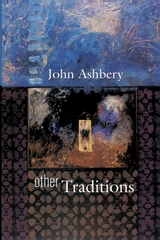 Other Traditions
John Ashbery
Harvard University Press, 2000 One of the greatest living poets in English here explores the work of six writers he often finds himself reading "in order to get started" when writing, poets he turns to as "a poetic jump-start for times when the batteries have run down." Among those whom John Ashbery reads at such times are John Clare, Thomas Lovell Beddoes, Raymond Roussel, John Wheelwright, Laura Riding, and David Schubert. Less familiar than some, under Ashbery's scrutiny these poets emerge as the powerful but private and somewhat wild voices whose eccentricity has kept them from the mainstream--and whose vision merits Ashbery's efforts, and our own, to read them well.
Deeply interesting in themselves, Ashbery's reflections on these poets of "another tradition" are equally intriguing for what they tell us about Ashbery's own way of reading, writing, and thinking. With its indirect clues to his work and its generous and infectious appreciation of a remarkable group of poets, this book conveys the passion, delight, curiosity, and insight that underlie the art and craft of poetry for writer and reader alike. Even as it invites us to discover the work of poets in Ashbery's other tradition, it reminds us of Ashbery's essential place in our own.
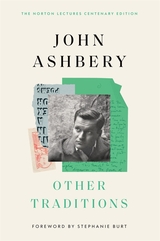 Other Traditions
John Ashbery
Harvard University Press, 2025 “An entertaining and shrewd little book … Ashbery is an accomplished raconteur.” —Charles Simic, New York Review of Books
The most influential American poet of his generation appraises the lesser-known writers who shaped his own confounding, infinitely inventive work.
John Ashbery was the quintessential “difficult poet.” When asked to explain his work, he typically responded by insisting that his poetry was its own explanation. Fittingly, then, when he was invited to deliver the Norton Lectures at Harvard in 1989, Ashbery declined to spell out what he put on the page. Instead, he offered rapt audiences a tour of his influences, the authors he turned to as a “jumpstart for times when the batteries have run down.”
The poets in Ashbery’s personal canon—John Clare, Thomas Lovell Beddoes, Raymond Roussel, John Wheelwright, Laura Riding, and David Schubert—were all tragic figures in their own way, plagued by mental illness or poverty, ridiculed or barely recognized in their own lives, and in some cases, all but forgotten today. More importantly for Ashbery, each wrote poetry that somehow defies the reader. Clare’s sometimes-monotonous naturalism, Roussel’s exhausting maze of parenthetical clauses, and Wheelwright’s eccentric Anglican mysticism do not invite casual reading. But under Ashbery’s tutelage, we experience the idiosyncratic brilliance of these “other traditions,” discovering how they shaped not only Ashbery’s poetics but also the broader trajectory of twentieth-century literature, from surrealism to New Criticism.
With inimitable charm, wit, and erudition, the lectures collected in Other Traditions elevate the imperfect and peculiar, affirming the literary virtues of Ashbery’s difficult predecessors. The result is a revealing self-portrait of one of the giants of American poetry, if only through a convex mirror.
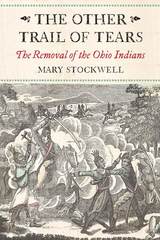 The Other Trail of Tears: The Removal of the Ohio Indians
Mary Stockwell
Westholme Publishing, 2015 The Story of the Longest and Largest Forced Migration of Native Americans in American History
The Indian Removal Act of 1830 was the culmination of the United States’ policy to force native populations to relocate west of the Mississippi River. The most well-known episode in the eviction of American Indians in the East was the notorious “Trail of Tears” along which Southeastern Indians were driven from their homes in Georgia, Alabama, and Mississippi to reservations in present-day Oklahoma. But the struggle in the South was part of a wider story that reaches back in time to the closing months of the War of 1812, back through many states—most notably Ohio—and into the lives of so many tribes, including the Delaware, Seneca, Shawnee, Ottawa, and Wyandot (Huron). They, too, were forced to depart from their homes in the Ohio Country to Kansas and Oklahoma. The Other Trail of Tears: The Removal of the Ohio Indians by award-winning historian Mary Stockwell tells the story of this region’s historic tribes as they struggled following the death of Tecumseh and the unraveling of his tribal confederacy in 1813. At the peace negotiations in Ghent in 1814, Great Britain was unable to secure a permanent homeland for the tribes in Ohio setting the stage for further treaties with the United States and encroachment by settlers. Over the course of three decades the Ohio Indians were forced to move to the West, with the Wyandot people ceding their last remaining lands in Ohio to the U.S. Government in the early 1850s. The book chronicles the history of Ohio’s Indians and their interactions with settlers and U.S. agents in the years leading up to their official removal, and sheds light on the complexities of the process, with both individual tribes and the United States taking advantage of opportunities at different times. It is also the story of how the native tribes tried to come to terms with the fast pace of change on America’s western frontier and the inevitable loss of their traditional homelands. While the tribes often disagreed with one another, they attempted to move toward the best possible future for all their people against the relentless press of settlers and limited time.
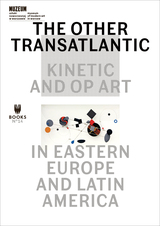 The Other Transatlantic: Kinetic and Op Art in Eastern Europe and Latin America
Edited by Marta Dziewanska, Dieter Roelstraete, and Abigail Winograd
Museum of Modern Art in Warsaw, 2017 The Other Transatlantic is attuned to the brief but historically significant moment in the postwar period between 1950 and 1970 when the trajectories of the Eastern European art scenes on the one hand, and their Latin American counterparts on the other, converged in a shared enthusiasm for kinetic and op art.
As the axis connecting the established power centers of Paris, London, and New York became increasingly dominated by monolithic trends including pop, minimalism, and conceptualism—another web of ideas was being spun linking the hubs of Warsaw, Budapest, Zagreb, Buenos Aires, Caracas, and Sao Paulo. These artistic practices were dedicated to what appeared to be an entirely different set of aesthetic concerns: philosophies of art and culture dominated by notions of progress and science, the machine and engineering, construction and perception. This book presents a highly illustrated introduction to this significant transnational phenomenon in the visual arts.
 Other Voices: Readings in Spanish Philosophy
John R. Welch
University of Notre Dame Press, 2010
English-speaking philosophers are generally attuned to the German and French philosophical traditions but not to the Spanish. Why, for example, does someone with the vivid appeal of Bartolome de Las Casas remain almost completely unknown in North America? The purpose of this anthology is to introduce the Spanish philosophical tradition to English-speaking readers.
Other Voices: Readings in Spanish Philosophy represents high points of nearly two millennia of Spanish philosophy, from first-century thinkers in Roman Hispania to those of the twentieth century. John R. Welch has selected, and in several cases translated excerpts from the works of thirteen philosophers: Seneca, Quintilian, Isidore of Seville, Ibn Rushd (Averroes), Moses Maimonides, Ramon Llull, Juan Luis Vives, Francisco de Vitoria, Bartolome de Las Casas, Francisco Suarez, Benito Jeronimo Feijoo, Miguel de Unamuno, and Jose Ortega y Gasset. Welch provides for the reader a brief introduction to each historical period or philosophical movement represented and a biographical introduction to each philosopher. Of special interest are the selection from Feijoo's "A Defense of Women" (an attack on misogyny), which has not been translated into English since the eighteenth century; the arguments on the justification of war by Vitoria and Las Casas (in the context of the Spanish conquest); and Unamuno's celebration of the concrete over the abstract, desire over reason.
"For the past few decades there has been a growing interest in Latin American philosophy, Hispanic/Latino philosophical issues, and Hispanic/Latino studies throughout North American universities. Because a significant part of the foundations of Latin American philosophy can be traced to Spanish philosophy, the increased interest in the former has naturally spilled over into the latter. This book, therefore, will be an essential resource not only for those interested in the history of philosophy but also for those engaged in the growing fields of Latin American philosophy and Hispanic/Latino studies." --Benardo J. Cantens, Moravian College
"A long overdue resource for scholars and for instructors in courses in the history of philosophy, this anthology makes available to English-speakers a concise collection of some monumental works of Spanish philosophical thought. It deserves a wide readership." --Gary Seay, City University of New York
"This collection is a welcome addition to the almost nonexistent number of collections of philosophy texts in English from Spain. It should be of use to students of philosophy and Spanish literature and intellectual history, and also to scholars from other disciplines who specialize in these areas of the world." --Jorge J. E. Gracia, State University of New York, University at Buffalo
The Other Windrush: Legacies of Indenture in Britain's Caribbean Empire
Maria del Pilar Kaladeen
Pluto Press, 2021 Between the arrival of the HMT Empire Windrush in 1948 and the passing of the 1971 Immigration Act, half a million people came to the UK from the Caribbean. In the aftermath of the 2018 Windrush Scandal, the story of the Windrush Generation is more widely known than ever. But is it the whole story? Through a series of biographical essays, poems and articles, The Other Windrush shines a light on the hidden history of a 'minority within a minority': Indian and Chinese Caribbean migrants - often the descendants of indentured labourers - who were the 'invisible passengers' of the Windrush generation. Both highlighting the diversity of their lives and cultural backgrounds, and delving into the largely forgotten history of the system of indenture in the British Caribbean, The Other Windrush makes a unique addition to the literature on migration and the British Empire.
 The Other Windrush: Legacies of Indenture in Britain's Caribbean Empire
Maria del Pilar Kaladeen
Pluto Press, 2021 'This illuminating, vivid volume is a fitting tribute to the experiences of migration' - Hanif Kureishi
Between the arrival of the HMT Empire Windrush in 1948 and the passing of the 1971 Immigration Act, half a million people came to the UK from the Caribbean. In the aftermath of the 2018 Windrush Scandal, the story of the Windrush Generation is more widely known than ever. But is it the whole story?
Through a series of biographical essays, poems and articles, The Other Windrush shines a light on the hidden history of a 'minority within a minority': Caribbean migrants of Indian and Chinese descent - often the descendants of indentured labourers - who were the 'invisible passengers' of the Windrush generation.
Both highlighting the diversity of their lives and cultural backgrounds, and delving into the largely forgotten history of the system of indenture in the British Caribbean, The Other Windrush makes a unique addition to the literature on migration and the British Empire.
Other Worlds
Albert Goldbarth
University of Pittsburgh Press, 2021 Other Worlds is true to its title, from a look at our everyday joys and griefs as interpreted by the Mars of classic science fiction and the crazy domain of quantum physics; to studies of the many conflicting realities that America uneasily accommodates in a time of pandemic and protests; to elegiac poems informed by the realms of memory, ghosts, and imagined afterlives. From a poem of one line to a sequence of twelve sections, from comic hijinks to despair, and from private revelation to public declaiming, this is a bravura performance by the only poet to have twice received the National Book Critics Circle Award and who, at age seventy-three, is writing at the height of his powers.
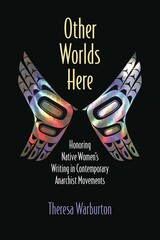 Other Worlds Here: Honoring Native Women’s Writing in Contemporary Anarchist Movements
Theresa Warburton
Northwestern University Press, 2021 Other Worlds Here: Honoring Native Women’s Writing in Contemporary Anarchist Movements examines the interaction of literature and radical social movement, exploring the limitations of contemporary anarchist politics through attentive engagement with Native women’s literatures. Tracing the rise of New Anarchism in the United States following protests against the World Trade Organization in 1999, interdisciplinary scholar Theresa Warburton argues that contemporary anarchist politics have not adequately accounted for the particularities of radical social movement in a settler colonial society. As a result, activists have replicated the structure of settlement within anarchist spaces.
All is not lost, however. Rather than centering a critical indictment of contemporary anarchist politics, Other Worlds Here maintains that a defining characteristic of New Anarchism is its ability to adapt and transform. Through close readings of texts by Native women authors, Warburton argues that anarchists must shift the paradigm that another world is possible to one that recognizes other worlds already here: stories, networks, and histories that lay out methods of building reciprocal relationships with the land and its people. Analyzing memoirs, poetry, and novels by writers including Deborah Miranda, Elissa Washuta, Heid E. Erdrich, Janet Rogers, and Leslie Marmon Silko, Other Worlds Here extends the study of Native women’s literatures beyond ethnographic analysis of Native experience to advance a widely applicable, contemporary political critique.
 Other Worlds: Spirituality and the Search for Invisible Dimensions
Christopher G. White
Harvard University Press, 2018 What do modern multiverse theories and spiritualist séances have in common? Not much, it would seem. One is an elaborate scientific theory developed by the world’s most talented physicists. The other is a spiritual practice widely thought of as backward, the product of a mystical world view fading under the modern scientific gaze.
But Christopher G. White sees striking similarities. He does not claim that séances or other spiritual practices are science. Yet he points to ways that both spiritual practices and scientific speculation about multiverses and invisible dimensions are efforts to peer into the hidden elements and even the existential meaning of the universe. Other Worlds examines how the idea that the universe has multiple, invisible dimensions has inspired science fiction, fantasy novels, films, modern art, and all manner of spiritual thought reaching well beyond the realm of formal religion. Drawing on a range of international archives, White analyzes how writers, artists, filmmakers, televangelists, and others have used the scientific idea of invisible dimensions to make supernatural phenomena such as ghosts and miracles seem more reasonable and make spiritual beliefs possible again for themselves and others.
Many regard scientific ideas as disenchanting and secularizing, but Other Worlds shows that these ideas—creatively appropriated in such popular forms as C. S. Lewis’s Chronicles of Narnia, the art of Salvador Dalí, or the books of the counterculture physicist “Dr. Quantum”—restore a sense that the world is greater than anything our eyes can see, helping to forge an unexpected kind of spirituality.
Other Worlds: The Fantasy Genre
Smith
University of Wisconsin Press, 1983 Fantasy permits its readers a certain distance from pragmatic affairs and offers them a clearer insight into them. It offers a parallel reality, which gives us a renewed awareness of what we already know. Fantasy invites the reader to recover a belief which has been beclouded by knowledge, to renew a faith which has been shattered by fact. As the pace of modern life quickens, the fascination for fantasy literature quickens simultaneously.
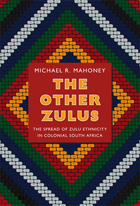 The Other Zulus: The Spread of Zulu Ethnicity in Colonial South Africa
Michael R. Mahoney
Duke University Press, 2012 In 1879, the British colony of Natal invaded the neighboring Zulu kingdom. Large numbers of Natal Africans fought with the British against the Zulus, enabling the British to claim victory and, ultimately, to annex the Zulu kingdom. Less than thirty years later, in 1906, many of those same Natal Africans, and their descendants, rebelled against the British in the name of the Zulu king. In The Other Zulus, a thorough history of Zulu ethnicity during the colonial period, Michael R. Mahoney shows that the lower classes of Natal, rather than its elites, initiated the transformation in ethnic self-identification, and they did so for multiple reasons. The resentment that Natal Africans felt toward the Zulu king diminished as his power was curtailed by the British. The most negative consequences of colonialism may have taken several decades to affect the daily lives of most Africans. Natal Africans are likely to have experienced the oppression of British rule more immediately and intensely in 1906 than they had in 1879. Meanwhile, labor migration to the gold mines of Johannesburg politicized the young men of Natal. Mahoney's fine-grained local history shows that these young migrants constructed and claimed a new Zulu identity, both to challenge the patriarchal authority of African chiefs and to fight colonial rule.
Otherhood: Poems
Reginald Shepherd
University of Pittsburgh Press, 2003 Written in the spaces between otherness and brotherhood, Otherhood combines traditional lyricism with experimentalism, passionate engagement with cold-eyed investigation, and personal details with a depersonalized distance to create a new poetic synthesis.
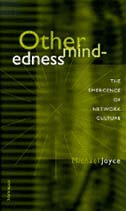 Othermindedness: The Emergence of Network Culture
Michael Joyce
University of Michigan Press, 2001 Michael Joyce's new collection continues to examine the connections between the poles of art and instruction, writing and teaching in the form of what Joyce has called theoretical narratives, pieces that are both narratives of theory and texts in which theory often takes the form of narrative. His concerns include hypertext and interactive fiction, the geography of cyberspace, and interactive film, and Joyce here searches out the emergence of network culture in spaces ranging from the shifting nature of the library to MOOs and other virtual spaces to life along a river. While in this collection Joyce continues to be one of our most lyrical, wide-ranging, and informed cultural critics and theorists of new media, his essays exhibit an evolving distrust of unconsidered claims for newness in the midst of what Joyce calls "the blizzard of the next," as well as a recurrent insistence upon grounding our experience of the emergence of network culture in the body. Michael Joyce is Associate Professor of English, Vassar College. He is author of a number of hypertext fictions on the web and on disk, most notably Afternoon: A Story. His previous books are Of Two Minds: Hypertext Pedagogy and Poetics and Moral Tale and Meditations: Technological Parables and Refractions.
 The Otherness of the Everyday: Twelve Conversations from the Chinese Art World during the Covid-19 Pandemic
Edited by JIANG Jiehong
Intellect Books, 2021 Jiang Jiehong seeks to understand the Covid-19 pandemic through interviews with leading figures of the Chinese art world during the summer of 2020.
In late 2019, as a deadly pandemic began to take hold, China’s Wuhan province was the first to feel the effects. As the virus spread, the streets and squares of the world emptied, and the structures of our social world were redefined.
In response to the pandemic, Jiang Jiehong convened in-conversation talks with twelve figures—such as Chen Danqing, Pi Li, Xiang Biao, and Zhang Peili, among others—from different disciplines in the Chinese-speaking world, including anthropology, architecture, art, curation, fashion, film, literature, media, museum, music, and photography. Presented here, the conversations foster new understandings of the ongoing crisis. The discussions explore the threat of the invisible; notions of distance and spatialization, separation and isolation, communication and mobility, discipline and surveillance, and community and collectiveness; and China’s changing relationship with the rest of the world. These illuminating reflections on the global crisis allow us to re-examine past norms and begin to form visions of a post-Covid world.
The Others
Raül Garrigasait, Translated by Tiago Miller
Fum d'Estampa Press, 2021 In 1837, at the height of the Carlist wars, a young Prussian man named Rudolf von Wielemann heads South to fight for the "Order." Finding himself left behind in the ruins of an abandoned city destroyed by war, he tentatively navigates his new surroundings in which his sense of self begins to distort and transform. A novel on place and (un)belonging, The Others masterfully intertwines humor and tragedy to explore Wielemann’s encounters with eccentric and enigmatic characters, and his unfamiliar surroundings. Garrigasait’s precise and intricately constructed prose, interspersed by beautifully lyrical passages on music and nature, invites readers to delve into reflections on family, politics, and place.
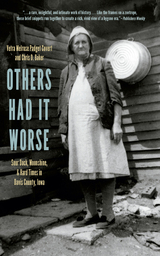 Others Had It Worse: Sour Dock, Moonshine, and Hard Times in Davis County, Iowa
Vetra Melrose Padget Covert and Chris D. Baker
University of Iowa Press, 2013 In 1977, while studying journalism at the University of Iowa, Chris Baker gave his grandmother a notebook and asked her to write about her childhood. Years later, long after her death in 1990, he found the tattered yellow notebook. In twenty-nine handwritten pages, the woman he knew as Grandma Covert had recorded her younger life in rural Iowa between 1920 and 1929. Writing about herself from the ages of four to thirteen, Vetra Covert sent a simple message back to her grandson: “That’s just the way it was. Others had it worse. We got by.” Captivated by this glimpse of a woman very different from the more formidable grandmother of his memory, Chris Baker reframed Vetra’s journal to create a narrative of her childhood and a window into rural Iowa life in the 1920s. Transcribing her words into nine chapters that illuminate home, family, neighbors, school, and social life, he has composed a collection of candid, whimsical, sometimes ornery stories that will resonate with anyone who has ever tried to decipher the lives found in old letters and photos. Vetra’s was not a romantic little-house-on-the-prairie childhood. She grew up with seven brothers and sisters (every new baby was “a supprise”) in a dilapidated log cabin near a small town now vanished from the Iowa map. Two rooms up, two rooms down, no plumbing, no electricity, holes in the roof and floor so big “you could of throwed a cat through them.” Her father was a bootlegger-farmer who measured his corn yield in gallons, not bushels, a moonshiner occasionally harassed by federal agents. Although family stories now present him as a quaint old-timer, the reality of living with him was much starker. In his introduction to Vetra’s recollections, Chris Baker reveals the harsh truths underlying her authentic, uncomplaining account. By honoring her legacy, he discovered a newfound respect for her and for her family’s ability to survive despite the devastating forces of poverty, isolation, and the looming Great Depression. Together he and his grandmother have created an enduring chapter in family history.
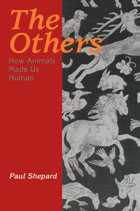 The Others: How Animals Made Us Human
Paul Shepard
Island Press, 1996 Paul Shepard has been one of the most brilliant and original thinkers in the field of human evolution and ecology for more than forty years. His thought-provoking ideas on the role of animals in human thought, dreams, personal identity, and other psychological and religious contexts have been presented in a series of seminal writings, including Thinking Animals, The Tender Carnivore and the Sacred Game, and now The Others, his most eloquent book to date. The Others is a fascinating and wide-ranging examination of how diverse cultures have thought about, reacted to, and interacted with animals. Shepard argues that humans evolved watching other animal species, participating in their world, suffering them as parasites, wearing their feathers and skins, and making tools of their bones and antlers. For millennia, we have communicated their significance by dancing, sculpting, performing, imaging, narrating, and thinking them. The human species cannot be fully itself without these others. Shepard considers animals as others in a world where otherness of all kinds is in danger, and in which otherness is essential to the discovery of the true self. We must understand what to make of our encounters with animals, because as we prosper they vanish, and ultimately our prosperity may amount to nothing without them.
Others' Milk: The Potential of Exceptional Breastfeeding
Wilson, Kristin J.
Rutgers University Press, 2018 Breastfeeding rarely conforms to the idealized Madonna-and-baby image seen in old artwork, now re-cast in celebrity breastfeeding photo spreads and pro-breastfeeding ad campaigns. The personal accounts in Others’ Milk illustrate just how messy and challenging and unpredictable it can be—an uncomfortable reality in the contemporary context of high-stakes motherhood in which “successful” breastfeeding proves one’s maternal mettle.
Exceptional breastfeeders find creative ways to feed and care for their children—such as by inducing lactation, sharing milk, or exclusively pumping. They want to adhere to the societal ideal of giving them “the best” but sometimes have to face off with dogmatic authorities in order to do so. Kristin J. Wilson argues that while breastfeeding is never going to be the feasible choice for everyone, it should be accessible to anyone.
Otherwise
Eleanor Wilner
University of Chicago Press, 1993 Eleanor Wilner loosens the attachments of traditional figures to the old historical ground and sets them free—to suggest how it might have been otherwise, and might still be. This is the most important book yet from the acclaimed poet and MacArthur prize winner.
"Otherwise is ambitious and patient, built on the spider's stratagem: the poet throws out a long tentative thread, then spins carefully outward until we see the new shape standing on air."—Carol Muske, The New York Times Book Review
"In a book of poems, one is happy to find half a dozen remarkable performances—poems worth rereading and even committing to memory. In Otherwise—which is splendid from the title on—it would be hard to find half a dozen which failed to equal Wilner's stratospheric standard."—David Slavit, Seven Arts
Otherwise: Essays
Julie Marie Wade
Autumn House Press, 2023 A personal lyrical essay collection by a winner of the Lambda Literary Award for Lesbian Memoir.
“I am a butterfly at half-mast. Muscles coiled like springs. I have not unwound yet,” writes Julie Marie Wade in Otherwise. In this series of intimate, braided essays written throughout her 30s, Wade traces her own unwinding and becoming through probing lyricism. As a daughter, lover, lesbian, and writer, she invites readers on a journey of self-discovery framed by memory, literature, and popular culture. Touching and tender, empathic and insightful, Otherwise revels in its author's self-acceptance at the threshold of mid-life.
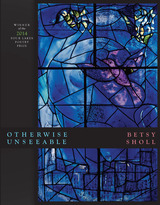 Otherwise Unseeable
Betsy Sholl
University of Wisconsin Press, 2014 Winner of the 2014 Four Lakes Poetry Prize What if ruin is a good thing? What if each day is built on the ruin of the one before? What if all our attempts to avoid ruin only make us bitter or closed off from what’s around us? What if only by exploring our ruins do we become human?
The poems in Otherwise Unseeable examine such questions. It is a poetry full of music and surprise, in voices that are personal, invented, and historical, sometimes belonging to the poet and sometimes to others. Betsy Sholl probes what there is still to learn from the devastations of the twentieth century, and she explores the roots of human envy, greed, and generosity in lively, unexpected ways, enacting the kinds of arguments we have with ourselves: between control and relinquishment, grief and ecstasy, regret and acceptance, faith and skepticism. The end result is a book of verbal wrestling, a girl-Jacob mixing it up with one kind of angel or another, limping for sure, but still blessed.
Winner, Maine Literary Award, Maine Writers and Publishers Alliance
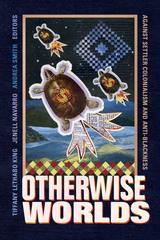 Otherwise Worlds: Against Settler Colonialism and Anti-Blackness
Tiffany Lethabo King, Jenell Navarro, and Andrea Smith, editors
Duke University Press, 2020 The contributors to Otherwise Worlds investigate the complex relationships between settler colonialism and anti-Blackness to explore the political possibilities that emerge from such inquiries. Pointing out that presumptions of solidarity, antagonism, or incommensurability between Black and Native communities are insufficient to understand the relationships between the groups, the volume's scholars, artists, and activists look to articulate new modes of living and organizing in the service of creating new futures. Among other topics, they examine the ontological status of Blackness and Indigeneity, possible forms of relationality between Black and Native communities, perspectives on Black and Indigenous sociality, and freeing the flesh from the constraints of violence and settler colonialism. Throughout the volume's essays, art, and interviews, the contributors carefully attend to alternative kinds of relationships between Black and Native communities that can lead toward liberation. In so doing, they critically point to the importance of Black and Indigenous conversations for formulating otherwise worlds.
Contributors
Maile Arvin, Marcus Briggs-Cloud, J. Kameron Carter, Ashon Crawley, Denise Ferreira da Silva, Chris Finley, Hotvlkuce Harjo, Sandra Harvey, Chad B. Infante, Tiffany Lethabo King, Jenell Navarro, Lindsay Nixon, Kimberly Robertson, Jared Sexton, Andrea Smith, Cedric Sunray, Se’mana Thompson, Frank B. Wilderson
Otherworld Women in Early Irish Literature
Heather Key
Amsterdam University Press, 2023 In early Ireland, there were many names for what scholars have dubbed the ‘Otherworld’: the Plain of Delights, the Land of Youth, the Land of Promise, and more. Many of the myths and legends from this period involve an encounter between a hero and a woman from this Otherworld, with sufficient frequency to form a distinct theme within the literature. This book examines the particularities and consequences of these otherworldly encounters, attending in particular to the question of gender and the social dynamics at work. Five stories purportedly from the lost book Cín Dromma Snechta receive detailed analysis, alongside material from other sources, in order to reconstruct the mindset of the early Irish who told these stories about the Otherworld and their views about women in general.
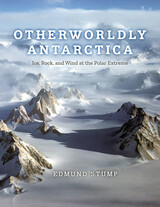 Otherworldly Antarctica: Ice, Rock, and Wind at the Polar Extreme
Edmund Stump
University of Chicago Press, 2024 With stunning original photographs, an Antarctic scientist and explorer takes us to one of the most sublime, remote, and pristine regions on the planet.
The interior of Antarctica is an utterly pristine wilderness, a desolate landscape of ice, wind, and rock; a landscape so unfamiliar as to seem of another world. This place has been known to only a handful of early explorers and the few scientists fortunate enough to have worked there. Edmund Stump is one of the lucky few. Having climbed, photographed, and studied more of the continent-spanning Transantarctic Mountains than any other person on Earth, this geologist, writer, and photographer is uniquely suited to share these alien sights.
With stories of Stump’s forty years of journeys and science, Otherworldly Antarctica contains 130 original color photographs, complemented by watercolors and sketches by artist Marlene Hill Donnelly. Over three chapters—on the ice, the rock, and the wind—we meet snowy paths first followed during Antarctica’s Heroic Age, climb the central spire of the Organ Pipe Peaks, peer into the crater of the volcanic Mount Erebus, and traverse Liv Glacier on snowmobile, while avoiding fatal falls into the blue interiors of hidden crevasses. Along the way, we see the beauty of granite, marble, and ice-cored moraines, meltwater ponds, lenticular clouds, icebergs, and glaciers. Many of Stump’s breathtaking images are aerial shots taken from the planes and helicopters that brought him to the interior. More were shot from vantages gained by climbing the mountains he studied. Some were taken from the summits of peaks. Many are of places no one had set foot before—or has since. All seem both permanent and precarious, connecting this otherworld to our fragile own.
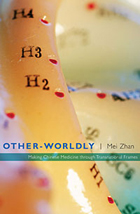 Other-Worldly: Making Chinese Medicine through Transnational Frames
Mei Zhan
Duke University Press, 2009 Traditional Chinese medicine is often portrayed as an enduring system of therapeutic knowledge that has become globalized in recent decades. In Other-Worldly, Mei Zhan argues that the discourses and practices called “traditional Chinese medicine” are made through, rather than prior to, translocal encounters and entanglements. Zhan spent a decade following practitioners, teachers, and advocates of Chinese medicine through clinics, hospitals, schools, and grassroots organizations in Shanghai and the San Francisco Bay Area. Drawing on that ethnographic research, she demonstrates that the everyday practice of Chinese medicine is about much more than writing herbal prescriptions and inserting acupuncture needles. “Traditional Chinese medicine” is also made and remade through efforts to create a preventive medicine for the “proletariat world,” reinvent it for cosmopolitan middle-class aspirations, produce clinical “miracles,” translate knowledge and authority, and negotiate marketing strategies and medical ethics. Whether discussing the presentation of Chinese medicine at a health fair sponsored by a Silicon Valley corporation, or how the inclusion of a traditional Chinese medicine clinic authenticates the “California” appeal of an upscale residential neighborhood in Shanghai, Zhan emphasizes that unexpected encounters and interactions are not anomalies in the structure of Chinese medicine. Instead, they are constitutive of its irreducibly complex and open-ended worlds. Zhan proposes an ethnography of “worlding” as an analytic for engaging and illuminating emergent cultural processes such as those she describes. Rather than taking “cultural difference” as the starting point for anthropological inquiries, this analytic reveals how various terms of difference—for example, “traditional,” “Chinese,” and “medicine”—are invented, negotiated, and deployed translocally. Other-Worldly is a theoretically innovative and ethnographically rich account of the worlding of Chinese medicine.
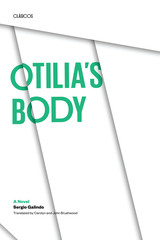 Otilia's Body: A Novel
By Sergio Galindo
University of Texas Press, 1994 From reviews of the Spanish edition: "...among the best works that Mexican fiction has produced." —Héctor Gally, Sábado "With homely features, but with a body so shapely and exciting that it sets men (priests included) aflame throughout the novel, with an incandescent voluptuousness and delightful amorality (surely explosive in the conservative Mexican society of her time and place) ...Otilia Rauda could be the protagonist of a Greek tragedy or of a soap opera made of improbable happenings and as many turns of fate as there are chapters used to tell the story of her life." —Jorge Ruffinelli, Punto y Aparte Winner of Mexico's prestigious Xavier Villaurrutia prize in 1986, Otilia Rauda is here translated into English for the first time as Otilia's Body. Widely considered Sergio Galindo's best work, the novel dramatizes a sexually liberated woman's obsession with an outlaw lover, played against the backdrop of Mexican history from 1910 to 1940. A fine example of "intimist" fiction, Otilia's Body is noteworthy for its penetratingly described characters who transcend time and place to become universally recognizable.
Otomi Parables, Folktales, and Jokes
H. Russell Bernard and Jesus Salinas Pedraza
University of Chicago Press Journals, 1976 This volume includes 20 oral texts from Otomí, collected in the 1970s. Each of the stories in this collection is presented in parallel format in a practical orthography. These texs represent a variety of genres seldom recorded in the field and will be of interest to linguists specializing in Otomanguean languages, typologists, and aficionados of oral narrative, as well as to speakers and learners of Otomí.
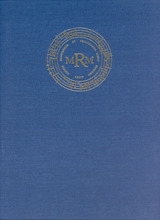 Ottaviano Petrucci, Motetti de Passione, de Cruce, de Sacramento, de Beata Virgine et huiusmodi B: Venice, 1503
Edited by Warren Drake
University of Chicago Press, 2002 Venetian publisher Ottaviano Petrucci was the first to print music for many voices with movable type. This Petrucci collection of motets from 1503, known as Motetti B, includes music from an impressive array of composers, many among the best known of their day. Motetti B is also the only source for many of its compositions, including several by Josquin des Prez.
As its lengthy title suggests, Motetti B consists of a wide range of devotional motets on the Passion, the Veneration of the Cross, the Eucharist, and the Virgin Mary. Many display a new style with a more harmonic orientation and also have close connections to lauda, devotional songs in Latin and Italian. Indeed, as Warren Drake points out, the subject matter of these motets displays close ties with the widespread devotional trends of the late fifteenth century, and Motetti B might even be considered a musical book of hours. In addition to a general introduction and the motets themselves, this edition includes detailed concordances and critical commentary on the sources and problematic aspects of the works.
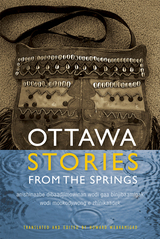 Ottawa Stories from the Springs: Anishinaabe dibaadjimowinan wodi gaa binjibaamigak wodi mookodjiwong e zhinikaadek
Howard Webkamigad
Michigan State University Press, 2014 Sometimes things come to people out of the blue and seemingly for a reason. The Anishinaabe word for this is nigika. The stories contained in this collection reached Howard Webkamigad nearly eighty years after they were recorded, after first being kept in their original copper wire format by the American Philosophical Society and later being converted onto cassettes and held by Dr. James McClurken of Michigan State University. These rich tales, recorded by Anishinaabe people in the Harbor Springs area of Michigan, draw on the legends, fables, trickster stories, parables, and humor of Anishinaabe culture. Reaching back to the distant past but also delving into more recent events, this book contains a broad swath of the history of the Ojibwe/Chippewa, Ottawa, Pottawatomi, Algonkian, Abenaki, Saulteau, Mashkiigowok/Cree, and other groups that make up the broad range of the Anishinaabe-speaking peoples. Provided here are original stories transcribed from Anishinaabe-language recordings alongside Howard Webkamigad’s English translations. These stories not only provide a textured portrait of a complex people but also will help Anishinaabe-language learners see patterns in the language and get a sense of how it flows. Featuring side-by-side Anishinaabe/English translations.
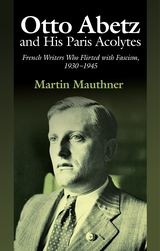 Otto Abetz and His Paris Acolytes: French Writers Who Flirted with Fascism, 1930-1945
Martin Mauthner
Sussex Academic Press, 2022 Before Hitler came to power, Otto Abetz was a left-wing Francophile teacher in provincial Germany, mobilising young French and German idealists to work together for peace through Franco-German reconciliation and a united Europe. Abetz married a French girl but, after 1933, succumbed to the Nazi sirens. Ribbentrop recruited him as his expert on France, tasking him with soothing the nervous French as Hitler turned Germany into a war machine. Abetz built up a network of opinion-moulding French men and women who admired the Nazis and detested the Bolsheviks, and he encouraged them to use their pens to highlight Hitler's triumphs. In 1939, France expelled Abetz as a Nazi agent but the following year he returned in triumph with the German army as an ambassador in Paris, appointed by Hitler. During the war, Abetz (apart from 'securing' works of art and playing a role in the deportation of Jews) manoeuvred three of his French publicist friends-Jean Luchaire, Fernand de Brinon, Drieu la Rochelle-into key positions from where they could laud Nazi achievements and denigrate the Resistance. A prime question the author addresses is why these writers and two others, Jules Romains and Bertrand de Jouvenel (all of whom had close Jewish family connections)supported the Nazi ideology. At the war's end, Drieu commited suicide, while Luchaire and Brinon were tried and executed as traitors. Abetz, charged with war crimes, pleaded that he saved France from being 'Polonized,' but a French court found him guilty and imprisoned him. He was released early but died in a mysterious car crash-a saboteur being suspected of having tampered with the steering. [Subject: Literature, Politics, Fascism]
 Otto Dix in Detail: Painting and Precarity in the Field of Weimar Culture
James A. van Dyke
University of Chicago Press How small details in the paintings of Otto Dix materialize the realities of a modern German artist.
Offering a fresh look at German art during a period of extraordinary transition and precarity, James A. van Dyke focuses on overlooked but critically significant details in works completed by Otto Dix between 1919 and 1936. A small lump of paint, a monogram, an almost invisible self-portrait, the verso of a drawing, a patch of discoloration, and a web of fine cracks—van Dyke reveals such details, hidden in plain sight, as coded dialogue through which Dix addressed audiences and art-world insiders amid the combative world of cultural production in Weimar Germany. Sly, cutting, and provocative, these are the material traces of social relationships between the painter and those who represented threats to his professional ambition: an avant-garde mentor and rival, an increasingly skeptical critic, a prominent bourgeois photographer, and a local Nazi authority.
Proving that small things offer insight into the big picture, this book highlights Dix’s satirical, transgressive work as nuanced and polyvocal, reflecting the complex fields of power and economics in which the field of art is located.
 Otto Marseus van Schrieck and the Art of the Butterfly: A Technical Study of Early Modern Lepidochromy
Mandrij
Amsterdam University Press, 2026 The Dutch painter and naturalist Otto Marseus van Schrieck became famous for an unusual iconography that mixed characteristics of landscape, animal painting, natural history illustration, and still life: the sottobosco paintings. These artworks, which he developed during his voyage to Italy around 1650, represent reptiles, amphibians, and insects in dark forests. To increase the realistic representations of lepidopterans, he pressed the wings of dead specimens onto the paintings to transfer their original colours. The technique of printing butterfly wings, named lepidochromy in this book, was already being used in the sixteenth century and has been documented as a means of conserving and classifying lepidopterans from the eighteenth through twentieth century.
With a strong focus on the techniques and materials involved in making butterfly imprints, this book introduces readers for the first time to the development, uses, and meanings of lepidochromy in the oeuvre of Otto Marseus van Schrieck at the crossroads of art and natural history.
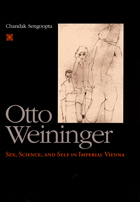 Otto Weininger: Sex, Science, and Self in Imperial Vienna
Chandak Sengoopta
University of Chicago Press, 2000 Turn-of-the century Vienna is remembered as an aesthetic, erotic, and intellectual world: the birthplace of Freud and psychoanalysis, the waltz, and novels of Schnitzler. The contexts of this cultural vibrancy, Chandak Sengoopta argues, were darker and more complex than we might imagine.
This provocative, enlightening study explores the milieu in which the philosopher Otto Weininger (1880-1903) wrote his controversial book Sex and Character. Shortly after its publication, Weininger committed suicide at the age of twenty-three. His book, which argued that women and Jews were mere sexual beings who lacked individuality, became a bestseller.
Hailed as a genius by intellectuals such as Ludwig Wittgenstein and Karl Kraus, Weininger was admired, not for his prejudices, but for his engagement with the central issues of the time—the nature and meanings of identity. Sengoopta pays particular attention to how Weininger appropriated scientific language and data to defend his views and examines the scientific theories themselves.
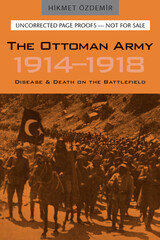 The Ottoman Army 1914 - 1918: Disease and Death on the Battlefield
Hikmet Ozdemir
University of Utah Press, 2008 Utah Series in Middle East Studies
What kind of relationship exists between wars and epidemics? It is widely held that epidemics affected the outcomes of many wars and, until World War II, more victims of war died of disease than of battle wounds. Many disease vectors are present in times of conflict, including mass movements of people across borders and increased contact between persons of different geographic regions, yet disease is rarely treated in depth in histories of war.
Hikmet Özdemir’s The Ottoman Army, 1914–1918 provides extensive documentation of disease and death across the Ottoman Empire during World War I, when epidemic diseases annihilated armies and caused civilians to perish en masse. Drawing on hospital records and information on regional disease prevalence, Özdemir examines the effects that disease and epidemic had on the outcome of the war.
The information on disease mortality explains much that has never been properly understood about wartime events and government actions, events that only begin to make sense when the disease factor is considered. Rich in detail, this is an extremely valuable book that illuminates a facet of the war that has not been adequately considered until now.
Ottoman Egypt in the Age of the French Revolution
Huseyn Efendi
Harvard University Press Huseyn Efendi, a scribe in the Treasury of Ottoman Egypt who put his service at the disposal of Napoleon Bonaparte during the French expedition to Egypt (1798–1801), wrote his account of Ottoman Egypt in the form of answers to questions posed by the French administrative and financial experts.
Stanford Shaw’s translation is supplemented by an introduction describing the French expedition, and by detailed notes based on material found in the Ottoman archives of Istanbul and Cairo.
Ottoman Empire and Islamic Tradition
Norman Itzkowitz
University of Chicago Press, 1980 This skillfully written text presents the full sweep of Ottoman history from its beginnings on the Byzantine frontier in about 1300, through its development as an empire, to its late eighteenth-century confrontation with a rapidly modernizing Europe. Itzkowitz delineates the fundamental institutions of the Ottoman state, the major divisions within the society, and the basic ideas on government and social structure. Throughout, Itzkowitz emphasizes the Ottomans' own conception of their historical experience, and in so doing penetrates the surface view provided by the insights of Western observers of the Ottoman world to the core of Ottoman existence.
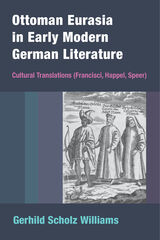 Ottoman Eurasia in Early Modern German Literature: Cultural Translations (Francisci, Happel, Speer)
Gerhild Scholz Williams
University of Michigan Press, 2021 Even a casual perusal of seventeenth-century European print production makes clear that the Turk was on everyone’s mind. Europe’s confrontation of and interaction with the Ottoman Empire in the face of what appeared to be a relentless Ottoman expansion spurred news delivery and literary production in multiple genres, from novels and sermons to calendars and artistic representations. The trans-European conversation stimulated by these media, most importantly the regularly delivered news reports, not only kept the public informed but provided the basis for literary conversations among many seventeenth-century writers, three of whom form the center of this inquiry: Daniel Speer (1636-1707), Eberhard Werner Happel (1647-1690), and Erasmus Francisci (1626-1694). The expansion of the Ottoman Empire during the sixteenth and seventeenth centuries offers the opportunity to view these writers' texts in the context of Europe and from a more narrowly defined Ottoman Eurasian perspective. Ottoman Eurasia in Early Modern German Literature: Cultural Translations (Francisci, Happel, Speer) explores the variety of cultural and commercial conversations between Europe and Ottoman Eurasia as they negotiated their competing economic and hegemonic interests. Brought about by travel, trade, diplomacy, and wars, these conversations were, by definition, “cross-cultural” and diverse. They eroded the antagonism of “us and them,” the notion of the European center and the Ottoman periphery that has historically shaped the view of European-Ottoman interactions.
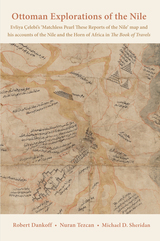 Ottoman Explorations of the Nile: Evliya Çelebi’s Map of the Nile and The Nile Journeys in the Book of Travels (Seyahatname)
Robert Dankoff, Nuran Tezcan, and Michael D. Sheridan
Gingko, 2018 Before the time of Napoleon, the most ambitious effort to explore and map the Nile was undertaken by the Ottomans, as attested by two monumental documents: an elaborate map, with 475 rubrics, and a lengthy travel account. Both were achieved at about the same time—c. 1685—and both by the same man.
Evliya Çelebi’s account of his Nile journeys, in the tenth volume of his Book of Travels (Seyahatname), has been known to the scholarly world since 1938, when that volume was first published. The map, held in the Vatican Library, has been studied since at least 1949. Numerous new critical editions of both the map and the text have been published over the years, each expounding upon the last in an attempt to reach a definitive version. The Ottoman Explorations of the Nile provides a more accurate translation of the original travel account. Furthermore, the maps themselves are reproduced in greater detail and vivid color, and there are more cross-references to the text than in any previous edition. This volume gives equal weight and attention to the two parts that make up this extraordinary historical document, allowing readers to study the map or the text independently, while also using each to elucidate and accentuate the details of the other.
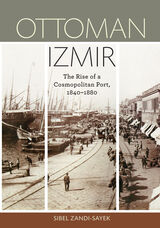 Ottoman Izmir: The Rise of a Cosmopolitan Port, 1840-1880
Sibel Zandi-Sayek
University of Minnesota Press, 2011 Between 1840 and 1880, the Eastern Mediterranean port of Izmir (Smyrna) underwent unprecedented change. A modern harbor that welcomed international steamships and new railway lines that transported a cornucopia of products transformed the physical city. Migrants, seasonal workers, and transient sailors thronged into an already diverse metropolis, helping to double the population to 200,000. Simultaneously, Ottoman officials and enterprising citizens vied to control and reform the city’s administrative and legal institutions.
Ottoman Izmir examines how urban space, institutional structures, and everyday practices shaped one another in the thriving seaport of Izmir during a volatile period of growth. Sibel Zandi-Sayek investigates a variety of urban actors—Muslims and non-Muslims, Ottomans and Europeans, newcomers and native residents, merchants, investors, civil servants, and press reporters—who were actively engaged in restructuring the city. Concentrating on the workings of urban committees and on laws and policies that were written, rewritten, but never fully implemented, Zandi-Sayek exposes how modern interventions sought to impose clear-cut concepts of public and private, safety and danger, and hygiene on a city that previously had a wide range of customary regulations.
Ottoman Izmir shows how Izmir’s various stakeholders contested its built environment. In so doing, it offers a new view of the dynamics of urban modernization.
Ottoman Jerusalem: The Living City: 1517-1917 Part 1 & 2
Sylvia Auld
Council for British Research in the Levant, 2000 A survey of Ottoman architecture in the Old City of Jerusalem, carried out by Yusuf Natsheh, and scholarship about this period co-edited by Robert Hillenbrand and Sylvia Auld, which began in 1991. In Part 1 of Ottoman Jerusalem, contributions from 33 academics present valuable research about life and culture in Jerusalem during the Ottoman period. Part 2 provides a detailed survey of the Ottoman architecture in the Old City of Jerusalem conducted by Yusuf Natsheh with the support of The Administration of Auqaf and Islamic Affairs, Jerusalem. The publication is published on behalf of the BSAJ by the World of Islam Festival Trust (now Al Tajir Trust).
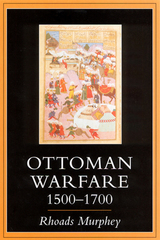 Ottoman Warfare 1500-1700
Murphey, Rhoads
Rutgers University Press, 1999 Ottoman Warfare is an impressive and original examination of the Ottoman military machine, detailing its success in Europe, North Africa, and the Middle East. Focusing primarily on the evolution of the Ottoman military organization and its subsequent impact on Ottoman society in a period of change, the book redresses the historiographical imbalance in the existing literature, analyzing why the Ottomans were the focus of such intense military concern.Several books have been written on the fiscal, technological, tactical, and political dimensions of Ottoman military history; little has been attempted, however, to recreate or evoke the physical and psychological realities of war as experienced by Ottoman soldiers. Rhoads Murphey seeks to rectify this imbalance, favoring operational matters and providing a detailed study of a number of campaigns: we are offered, for example, vivid descriptions of life in the trenches with the diggers at Baghdad in 1638, who dug a total of five miles at 50 yards a day. Murphey's analysis does not focus on the Ottoman's success or failure in particular campaigns per se; he focuses on understanding the actual process of how the Ottoman military machine worked.This long-awaited work will become the definitive study of Ottoman warfare in the early modern period, and will be invaluable to those studying the Ottoman Empire and early modern European history in general.
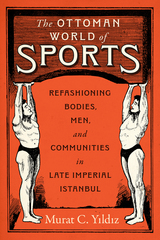 The Ottoman World of Sports: Refashioning Bodies, Men, and Communities in Late Imperial Istanbul
Murat C. Yildiz
University of Texas Press, 2025 A revision of the history of modern sports in late Ottoman Istanbul, showing how Muslims, Christians, and Jews created a shared sports culture that was simultaneously global, imperial, and local. The history of sports in Turkey is deeply contested. Over the decades, journalists, pundits, non-professional historians, and everyday people have offered competing narratives about the origins of modern sports in the late Ottoman Empire. The Ottoman World of Sports tells the story of how Istanbul’s Muslims, Christians, and Jews—gymnastics teachers, football coaches, weightlifters, journalists, athletes, and fans—created a gendered and class-stratified civic project that promoted athletics as a source of fun, beauty, and moral education. Influenced by the emerging global vogue for organized sports, all boys from the expanding middle class of the late nineteenth- and early twentieth-century imperial capital were expected to exercise and compete on the playing field in order to develop into moral men. Yet even as the embrace of modern physical culture transcended ethno-religious divisions, it did not erase them. Drawing on a wide range of archival research in multiple languages, historian Murat Yıldız shows that sportsmen created new communal boundaries in team affiliations, fandom, and sports media. Adeptly reconstructing Istanbul’s imperial culture as it was experienced more than a century ago, The Ottoman World of Sports recovers a lived imperial culture whose defining features were shaped by its multiethnic, multireligious, and multilingual sportsmen.
Ouidah: The Social History of a West African Slaving Port, 1727–1892
Robin Law
Ohio University Press, 2004 Ouidah, an African town in the Republic of Benin, was the principal precolonial commercial center of its region and the second-most-important town of the Dahomey kingdom. It served as a major outlet for the transatlantic slave trade. Between the seventeenth and the nineteenth centuries, Ouidah was the most important embarkation point for slaves in the region of West Africa known to outsiders as the Slave Coast. This is the first detailed study of the town’s history and of its role in the Atlantic slave trade.
Ouidah is a well-documented case study of precolonial urbanism, of the evolution of a merchant community, and in particular of the growth of a group of private traders whose relations with the Dahomian monarchy grew increasingly problematic over time.
 Our Aesthetic Categories: Zany, Cute, Interesting
Sianne Ngai
Harvard University Press, 2012 The zany, the cute, and the interesting saturate postmodern culture. They dominate the look of its art and commodities as well as our discourse about the ambivalent feelings these objects often inspire. In this radiant study, Sianne Ngai offers a theory of the aesthetic categories that most people use to process the hypercommodified, mass-mediated, performance-driven world of late capitalism, treating them with the same seriousness philosophers have reserved for analysis of the beautiful and the sublime.
Ngai explores how each of these aesthetic categories expresses conflicting feelings that connect to the ways in which postmodern subjects work, exchange, and consume. As a style of performing that takes the form of affective labor, the zany is bound up with production and engages our playfulness and our sense of desperation. The interesting is tied to the circulation of discourse and inspires interest but also boredom. The cute's involvement with consumption brings out feelings of tenderness and aggression simultaneously. At the deepest level, Ngai argues, these equivocal categories are about our complex relationship to performing, information, and commodities.
Through readings of Adorno, Schlegel, and Nietzsche alongside cultural artifacts ranging from Bob Perelman's poetry to Ed Ruscha's photography books to the situation comedy of Lucille Ball, Ngai shows how these everyday aesthetic categories also provide traction to classic problems in aesthetic theory. The zany, cute, and interesting are not postmodernity's only meaningful aesthetic categories, Ngai argues, but the ones best suited for grasping the radical transformation of aesthetic experience and discourse under its conditions.
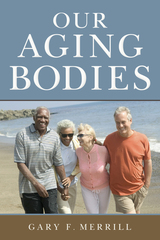 Our Aging Bodies
Merrill, Gary F
Rutgers University Press, 2015 People in developed countries are living longer and, just as the aged population around the world is steadily growing, the number of adults eighty-five and older in the United States is projected to quadruple to twenty-one million people by 2050. The aging of our population has huge implications for baby boomers and their children, and has generated a greater interest in the causes and effects of aging. Our Aging Bodies provides a clear, scientifically based explanation of what happens to all the major organ systems and bodily processes—such as the cardiovascular and digestive systems—as people age. The first section is an overview of secondary aging—changes that occur with age that are related to disease and the environment—and include the effect of such things as diet, humor, and exercise. Readers will also learn about primary aging—intrinsic changes that occur with the aging of specific organs and body systems (including the prostate, the heart, the digestive system, and the brain). Throughout the book, Gary F. Merrill weaves in personal anecdotes and stories that help clarify and reinforce the facts and principles of the underlying scientific processes and explanations. Our Aging Bodies is accessible to a general reader interested in the aging phenomenon, or baby boomers wanting to be more informed when seeing their doctor and discussing changes to their bodies as they age.
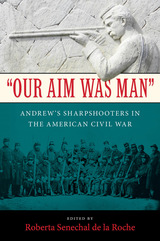 "Our Aim Was Man": Andrew's Sharpshooters in the American Civil War
Roberta Senechal de la Roche
University of Massachusetts Press, 2016 One was a father who worried about his fellow soldiers' swearing. Another hoped to enter Harvard College. The third was a farmer whose letters home depict the later stages of the war. The fourth had turned to boot making when he did not inherit land. Based on the letters, diaries, and memoirs of four members of the First Company Massachusetts Sharpshooters, known as Andrew's Sharpshooters, this book provides a rare glimpse into the experiences of Union Army snipers. The company was one of the first units in American military history to be equipped with telescope-sighted rifles to enable long-distance targeting. Despite complaints that snipers violated codes of honorable combat, the members of Andrew's Sharpshooters generally expressed quiet pride in being an elite unit of highly skilled soldiers—"cool blooded sharpshooters," as one of them said.
Introduced and edited by Roberta Senechal de la Roche, these primary accounts include new details about the equipment, training, and deployment of snipers in the Army of the Potomac. They also reveal the challenges of covert warfare and include rich detail on the everyday problems of Civil War soldiers, including bad food, disease, punishing marches, and homesickness. The collected documents also convey the trials of those left on the home front.
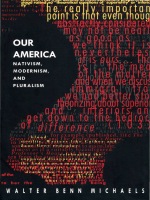 Our America: Nativism, Modernism, and Pluralism
Walter Benn Michaels
Duke University Press, 1997 Arguing that the contemporary commitment to the importance of cultural identity has renovated rather than replaced an earlier commitment to racial identity, Walter Benn Michaels asserts that the idea of culture, far from constituting a challenge to racism, is actually a form of racism. Our America offers both a provocative reinterpretation of the role of identity in modernism and a sustained critique of the role of identity in postmodernism.
“We have a great desire to be supremely American,” Calvin Coolidge wrote in 1924. That desire, Michaels tells us, is at the very heart of American modernism, giving form and substance to a cultural movement that would in turn redefine America’s cultural and collective identity—ultimately along racial lines. A provocative reinterpretation of American modernism, Our America also offers a new way of understanding current debates over the meaning of race, identity, multiculturalism, and pluralism.
Michaels contends that the aesthetic movement of modernism and the social movement of nativism came together in the 1920s in their commitment to resolve the meaning of identity—linguistic, national, cultural, and racial. Just as the Johnson Immigration Act of 1924, which excluded aliens, and the Indian Citizenship Act of the same year, which honored the truly native, reconceptualized national identity, so the major texts of American writers such as Cather, Faulkner, Hurston, and Williams reinvented identity as an object of pathos—something that can be lost or found, defended or betrayed. Our America is both a history and a critique of this invention, tracing its development from the white supremacism of the Progressive period through the cultural pluralism of the Twenties. Michaels’s sustained rereading of the texts of the period—the canonical, the popular, and the less familiar—exposes recurring concerns such as the reconception of the image of the Indian as a symbol of racial purity and national origins, the relation between World War I and race, contradictory appeals to the family as a model for the nation, and anxieties about reproduction that subliminally tie whiteness and national identity to incest, sterility, and impotence.
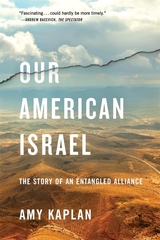 Our American Israel: The Story of an Entangled Alliance
Amy Kaplan
Harvard University Press, 2018 “Our American Israel is masterful and deserves a larger audience.” —Ta-Nehisi Coates
An essential account of America’s most controversial alliance, and how that strong and divisive partnership plays out in our own time.
In 1945, it was not inevitable that a global superpower emerging victorious from World War II would come to identify with a small state for Jewish refugees, refugees who at that time were still being turned away from the United States. How, then, did so many in America come to feel that the bond between it and Israel was historically inevitable, morally right, and a matter of common sense. Our American Israel reveals how Israel’s identity has long been entangled with America’s belief in its own exceptional nature. Beginning at the end of World War II with debates about the establishment of a Jewish state in Palestine and continuing through both the rise of evangelical Christian Zionism and the war on terror, Amy Kaplan challenges the associations underlying this special alliance.
Through popular narratives expressed in news media, fiction, and film, a shared sense of identity emerged from the two nations’ histories as settler societies. Americans projected their own origin myths onto Israel: the biblical promised land, the open frontier, the refuge for immigrants. Israel assumed a mantle of moral authority, based on its image as an “invincible victim,” a nation of intrepid warriors and concentration camp survivors. The image of the underdog shattered when Israel invaded Lebanon; its military was strongly censured around the world, including notes of dissent in the United States. Rather than a symbol of justice, Israel became a model of military strength and technological ingenuity.
In America today, Israel’s political realities pose profoundly difficult challenges. Turning a critical eye on the turbulent history that bound the two nations together, Kaplan unearths the roots of present controversies that threaten to divide them.
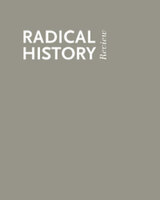 Our Americas: Political and Cultural Imaginings, Volume 2004
Sandhya Shukla and Heidi Tinsman, eds.
Duke University Press Named 2004 Best Special Issue by the Council of Editors of Learned JournalsThis special issue of Radical History Review takes as its inspiration Cuban writer and revolutionary José Martí’s famous 1891 essay “Our America.” Focusing on Martí’s appropriation of the term “America”—used to refer to a transnational, regional project of solidarity in Latin America and to suggest a new epistemology that challenged the ideologies underpinning U.S. imperialism—Our Americas: Political and Cultural Imaginings investigates the highly contested concept of “the Americas” as it has been defined and deployed in differing strategic and politically informed ways across history. The issue is dedicated to probing the transnational political and social possibilities that emerge when the discursive boundaries established by fields such as “Latin American studies” and “American studies”—as well as the geopolitical boundaries drawn during the colonial era—are expanded or transgressed. Drawing on history, cultural anthropology, literary criticism, and memoirs, the works in this collection, gathered from contributors from an array of geographic locales, seek to integrate “Latin America,” “North America,” “the Caribbean,” and other regions. Striving to move beyond a simple joining of “Latin America” and the United States, the transnational concept of “the Americas” is explored and complicated through essays that examine the contrasting visions of Latin American independence embodied in the writings of revolutionaries from different nations; discuss the ramifications of a political treaty that institutionalized a separation between Mexico and the United States; deconstruct the exclusionary discourses of U.S. nationalism; and expose the ways in which institutionalized racism and homophobia are roadblocks to social and political solidarity in Latin America. In discussion forums, contributors plumb the history and current relevance of the concept of “Latin America” for intellectual, social, and political work and address the unique challenges facing those who seek to teach “the Americas.” Contributors. Arturo Arias, John Beck, John D. Blanco, Nestor Garcia Canclini, Patricio Del Real, Ian Christopher Fletcher, Paul Giles, Salah D. Hassan, Martin Hopenhayn, Aisha Khan, R. J. Lambrose, Ian Lekus, Kate Masur, Enrique C. Ochoa, Diana Paton, Rossana Reguillo, Gemma Robinson, Aimee Carillo Rowe, Maria Josefina Saldana-Portillo, Sandhya Shukla, Heidi Tinsman, Carlos E. Bojorquez Urzaiz
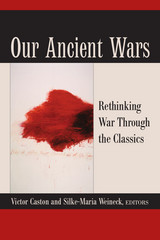 Our Ancient Wars: Rethinking War through the Classics
Victor Caston and Silke-Maria Weineck, editors
University of Michigan Press, 2016 Many famous texts from classical antiquity—by historians like Thucydides, tragedians like Sophocles and Euripides, the comic poet Aristophanes, the philosopher Plato, and, above all, Homer—present powerful and profound accounts of wartime experience, both on and off the battlefield. They also provide useful ways of thinking about the complexities and consequences of wars throughout history, and the concept of war broadly construed, providing vital new perspectives on conflict in our own era.
Our Ancient Wars features essays by top scholars from across academic disciplines—classicists and historians, philosophers and political theorists, literary scholars, some with firsthand experience of war and some without—engaging with classical texts to understand how differently they were read in other times and places. Contributors articulate difficult but necessary questions about contemporary conceptions of war and conflict.
Our Animal
Meredith Stricker
Omnidawn, 2016 Our Animal hybridizes novel flaking into poetic forms like a gnat swarm, magnetic filings, or migratory flux. It’s a fierce inquiry into Othering, tracking Kafka’s life through his deep identification with animals, especially those hunted or outcast. Graphically complex with metamorphic text layers, the chapters shape-shift in relation to crows, dragonflies, a frog; there are deer, swallows, a goldfinch, humans, a hybrid Beast, wolf, Insekt, a small unidentified animal in its burrow. We are entangled in biography as biology— paradisiacal transfiguration that leaves out no being.
Our Animal is the winner of the 2014 Omnidawn Poetry Open Book Contest, selected by Mary Jo Bang.
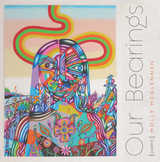 Our Bearings: Poems
Molly McGlennen; Foreword by Ben Burgess
University of Arizona Press, 2020 Our Bearings is a collection of narrative poetry that examines and celebrates Anishinaabe life in modern Minneapolis. Crafted around the four elements—earth, air, water, and fire— the poems are a beautifully layered discourse between landscapes, stories, and the people who inhabit them. Throughout the collection, McGlennen weaves the natural elements of Minnesota with rich historical commentary and current images of urban Native life. Reverence for wildlife and foliage is pierced by the sharp man-made skylines of Minneapolis while McGlennen reckons with the heavy impact of industrial progress on the souls and everyday lives of individuals.
While working with both traditional and contemporary form, McGlennen’s unique use of space and rhythm creates poetry that is both captivating and accessible. Our Bearings does not attempt to speak for a population; rather it offers vibrant stories and moments that give voice to pieces of a large and complex tapestry of experiences. Through keen observation and a deep understanding of Native life in Minneapolis, McGlennen has created a timely collection that contributes beautifully to the important conversation about contemporary urban Native life in North America and globally.
 Our Blood: The Social Experience of Heritas
Michael M. Bell, Loka Ashwood and Jay Orne
University of Chicago Press Who are we, where do we come from, and why does it matter?
From whom do I come? Our Blood describes the central importance of our sense not just of our heritage, but our embodied heritage: that our past is in our bodies and runs in our blood, and that our embodied past is central to our futures. Deeply felt heritas, as Michael M. Bell, Loka Ashwood, and Jay Orne call it, can be a source of great love and kindness for one another. But it can also be a beautiful horror, the source of some of our greatest hate and meanness towards one another. We think of our embodied heritage as natural and historical facts, beyond our choice, and therefore free of manipulation for social gain. We think of it as spirited presences in our bodies that we did not choose. We think of its origins as external to us, whether we are talking about family, class, caste, places, things, ethnoraciality, or our professions. We think of it as legitimate and rightful, therefore. But we do choose. We do select. Bell, Ashwood, and Orne argue that greater awareness of heritas’s social origins and social selectivity can help us cultivate a wider sense of mutual care and ease the divisiveness of our time. Ultimately, Our Blood asks us all to consider heritas, and in doing so, to perhaps even reconsider our very selves.
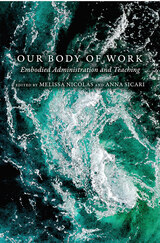 Our Body of Work: Embodied Administration and Teaching
edited by Melissa Nicolas & Anna Sicari
Utah State University Press, 2022 Our Body of Work invites administrators and teachers to consider how physical bodies inform everyday work and labor as well as research and administrative practices in writing programs. Combining academic and personal essays from a wide array of voices, it opens a meaningful discussion about the physicality of bodily experiences in the academy.
Open exchanges enable complex and nuanced conversations about intersectionality and how racism, sexism, classism, and ableism (among other “isms”) create systems of power. Contributors examine how these conversations are framed around work, practices, policies, and research and identify ways to create inclusive, embodied practices in writing programs and classrooms. The collection is organized to maximize representation in the areas of race, gender, identity, ability, and class by featuring scholarly chapters followed by narratively focused interchapters that respond to and engage with the scholarly work.
The honest and emotionally powerful stories in Our Body of Work expose problematic and normalizing policies, practices, and procedures and offer diverse theories and methodologies that provide multiple paths for individuals to follow to make the academy more inclusive and welcoming for all bodies. It will be an important resource for researchers, as well a valuable addition to graduate and undergraduate syllabi on embodiment, writing instruction/pedagogy, and WPA work.
Contributors: Dena Arendall, Janel Atlas, Hayat Bedaiwi, Elizabeth Boquet, Lauren Brentnell, Triauna Carey, Denise Comer, Joshua Daniel, Michael Faris, Rebecca Gerdes-McClain, Morgan Gross, Nabila Hijazi, Jacquelyn Hoermann-Elliott, Maureen Johnson, Jasmine Kar Tang, Elitza Kotzeva, Michelle LaFrance, Jasmine Lee, Lynn C. Lewis, Mary Lourdes Silva, Rita Malenczyk, Anna Rita Napoleone, Julie Prebel, Rebecca Rodriguez Carey, Ryan Skinnell, Trixie Smith, Stacey Waite, Kelsey Walker, Shannon Walters, Isaac Wang, Jennie Young
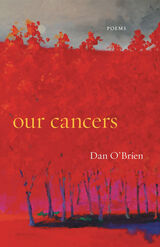 Our Cancers: Poems
Dan O'Brien
Acre Books, 2021 Poet and playwright Dan O’Brien chronicles the year and a half during which both he and his wife were treated for cancer.
On the fourteenth anniversary of 9/11—an event that caused their downtown apartment to become “suffused with the World Trade Center’s carcinogenic dust”—Dan O’Brien’s wife discovers a lump in her breast. Surgery and chemotherapy soon follow, and on the day of his wife’s final infusion, O’Brien learns of his own diagnosis. He has colon cancer and will need to undergo his own intensive treatment over the next nine months.
Our Cancers is a compelling account of illness and commitment, of parenthood and partnership. This spare and powerful sequence creates an intimate mythology that seeks meaning in illness while also celebrating the resilience of sufferers, caregivers, and survivors.
As O’Brien explains in an introduction, “The consecutiveness of our personal disasters, with a daughter not yet two years old at the start of it, was shattering and nearly silencing. At hospital bedsides, in hospital beds myself, and at home through the cyclical assaults of our therapies, these poems came to me in fragments, as if my unconscious were attempting to reassemble our lives, our identities and memories . . . as if I were in some sense learning how to speak again.”
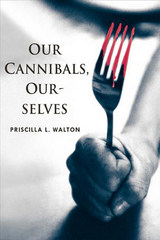 Our Cannibals, Ourselves
Priscilla L. Walton
University of Illinois Press, 2004 Why does Western culture remain fascinated with and saturated by cannibalism? Moving from the idea of the dangerous Other, Priscilla L. Walton's Our Cannibals, Ourselves shows us how modern-day cannibalism has been recaptured as in the vampire story, resurrected into the human blood stream, and mutated into the theory of germs through AIDS, Ebola, and the like. At the same time, it has expanded to encompass the workings of entire economic systems (such as in "consumer cannnibalism").
Our Cannibals, Ourselves is an interdisciplinary study of cannibalism in contemporary culture. It demonstrates how what we take for today's ordinary culture is imaginatively and historically rooted in very powerful processes of the encounter between our own and different, often "threatening," cultures from around the world. Walton shows that the taboo on cannibalism is heavily reinforced only partly out of fear of cannibals themselves; instead, cannibalism is evoked in order to use fear for other purposes, including the sale of fear entertainment.
Ranging from literature to popular journalism, film, television, and discourses on disease, Our Cannibals, Ourselves provides an all-encompassing, insightful meditation on what happens to popular culture when it goes global.
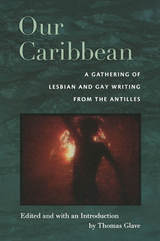 Our Caribbean: A Gathering of Lesbian and Gay Writing from the Antilles
Thomas Glave, ed.
Duke University Press, 2008 The first book of its kind, Our Caribbean is an anthology of lesbian and gay writing from across the Antilles. The author and activist Thomas Glave has gathered outstanding fiction, nonfiction, memoir, and poetry by little-known writers together with selections by internationally celebrated figures such as José Alcántara Almánzar, Reinaldo Arenas, Dionne Brand, Michelle Cliff, Audre Lorde, Achy Obejas, and Assotto Saint. The result is an unprecedented literary conversation on gay, lesbian, bisexual, and transgendered experiences throughout the Caribbean and its far-flung diaspora. Many selections were originally published in Spanish, Dutch, or creole languages; some are translated into English here for the first time. The thirty-seven authors hail from the Bahamas, Barbados, Cuba, the Dominican Republic, Grenada, Guyana, Haiti, Jamaica, Panama, Puerto Rico, St. Vincent, St. Kitts, Suriname, and Trinidad. Many have lived outside the Caribbean, and their writing depicts histories of voluntary migration as well as exile from repressive governments, communities, and families. Many pieces have a political urgency that reflects their authors’ work as activists, teachers, community organizers, and performers. Desire commingles with ostracism and alienation throughout: in the evocative portrayals of same-sex love and longing, and in the selections addressing religion, family, race, and class. From the poem “Saturday Night in San Juan with the Right Sailors” to the poignant narrative “We Came All the Way from Cuba So You Could Dress Like This?” to an eloquent call for the embrace of difference that appeared in the Nassau Daily Tribune on the eve of an anti-gay protest, Our Caribbean is a brave and necessary book. Contributors: José Alcántara Almánzar, Aldo Alvarez, Reinaldo Arenas, Rane Arroyo, Jesús J. Barquet, Marilyn Bobes, Dionne Brand, Timothy S. Chin, Michelle Cliff, Wesley E. A. Crichlow,
Mabel Rodríguez Cuesta, Ochy Curiel, Faizal Deen, Pedro de Jesús, R. Erica Doyle, Thomas Glave,
Rosamond S. King, Helen Klonaris, Lawrence La Fountain-Stokes, Audre Lorde, Shani Mootoo,
Anton Nimblett, Achy Obejas, Leonardo Padura Fuentes, Virgilio Piñera, Patricia Powell, Kevin Everod Quashie, Juanita Ramos, Colin Robinson, Assotto Saint, Andrew Salkey, Lawrence Scott,
Makeda Silvera, H. Nigel Thomas, Rinaldo Walcott, Gloria Wekker, Lawson Williams
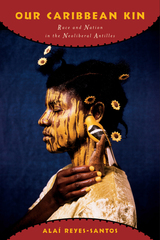 Our Caribbean Kin: Race and Nation in the Neoliberal Antilles
Reyes-Santos, Alaí
Rutgers University Press, 2015 Beset by the forces of European colonialism, US imperialism, and neoliberalism, the people of the Antilles have had good reasons to band together politically and economically, yet not all Dominicans, Haitians, and Puerto Ricans have heeded the calls for collective action. So what has determined whether Antillean solidarity movements fail or succeed? In this comprehensive new study, Alaí Reyes-Santos argues that the crucial factor has been the extent to which Dominicans, Haitians, and Puerto Ricans imagine each other as kin.
Our Caribbean Kin considers three key moments in the region’s history: the nineteenth century, when the antillanismo movement sought to throw off the yoke of colonial occupation; the 1930s, at the height of the region’s struggles with US imperialism; and the past thirty years, as neoliberal economic and social policies have encroached upon the islands. At each moment, the book demonstrates, specific tropes of brotherhood, marriage, and lineage have been mobilized to construct political kinship among Antilleans, while racist and xenophobic discourses have made it difficult for them to imagine themselves as part of one big family.
Recognizing the wide array of contexts in which Antilleans learn to affirm or deny kinship, Reyes-Santos draws from a vast archive of media, including everything from canonical novels to political tracts, historical newspapers to online forums, sociological texts to local jokes. Along the way, she uncovers the conflicts, secrets, and internal hierarchies that characterize kin relations among Antilleans, but she also discovers how they have used notions of kinship to create cohesion across differences.
|
|


